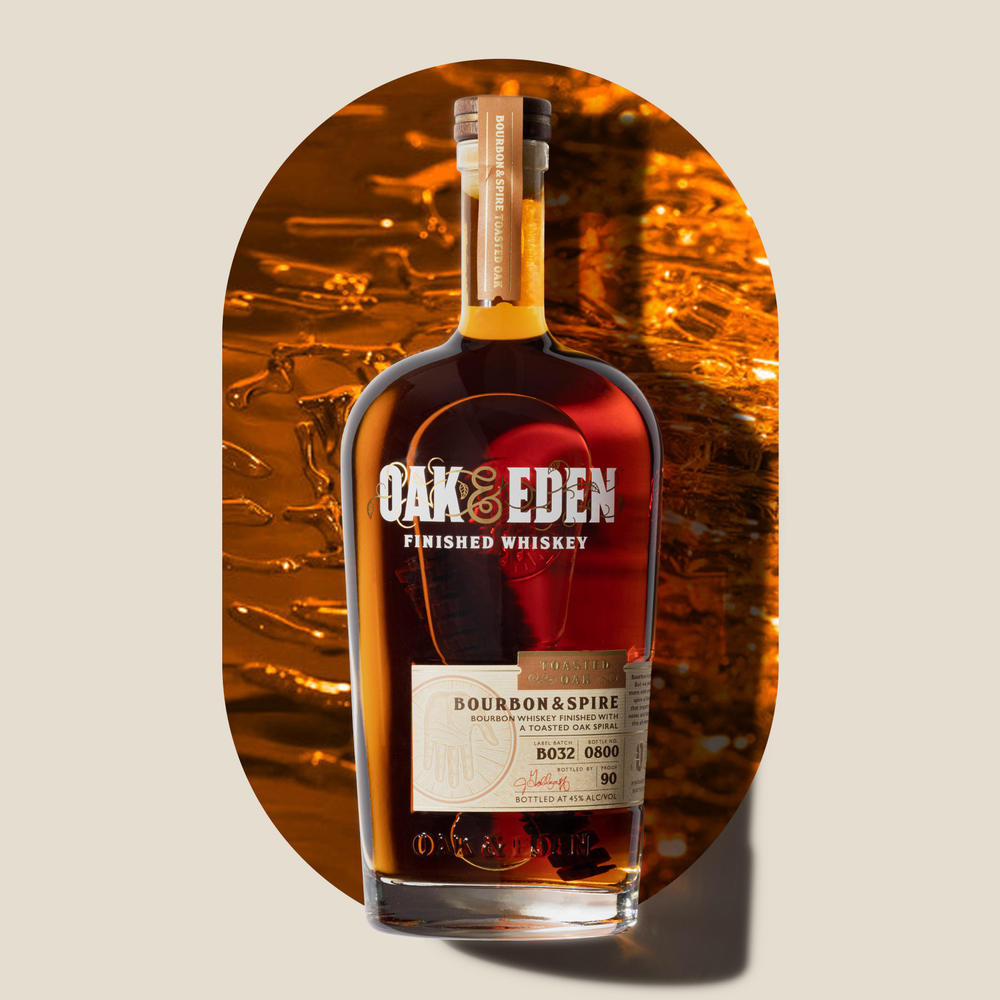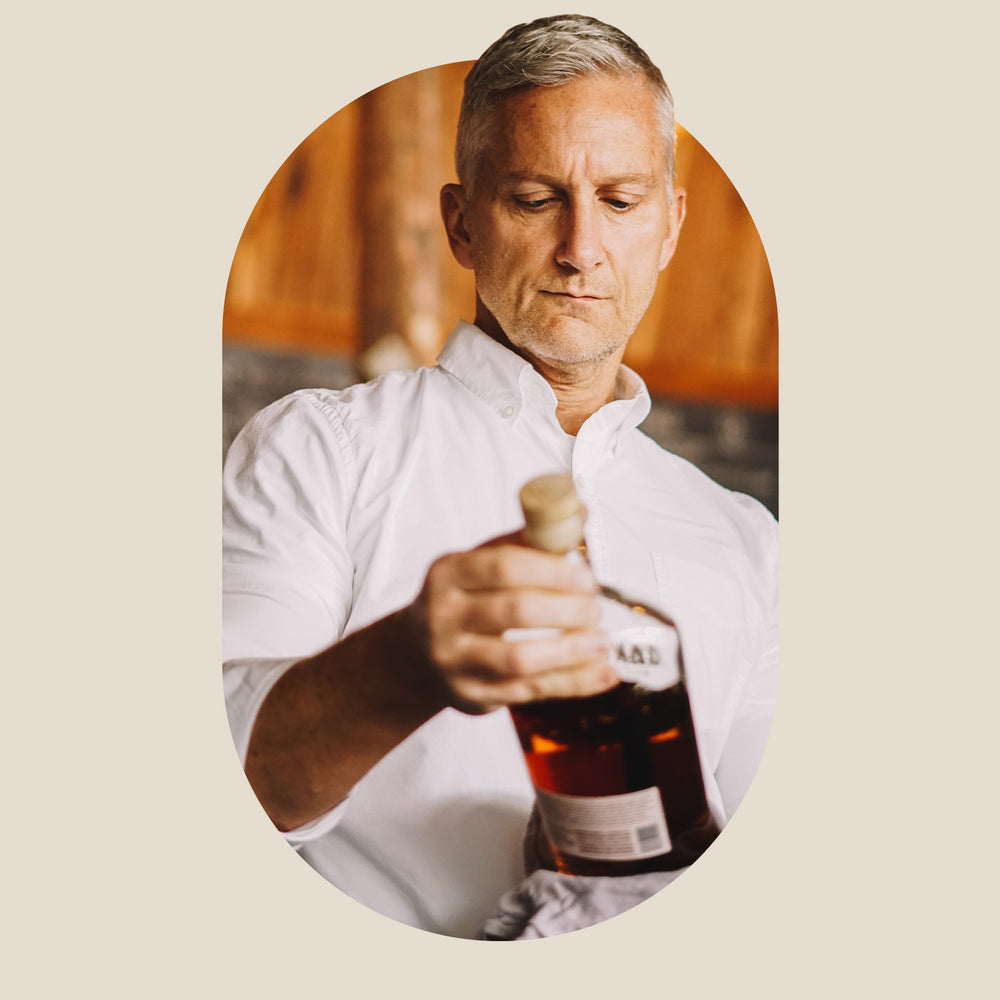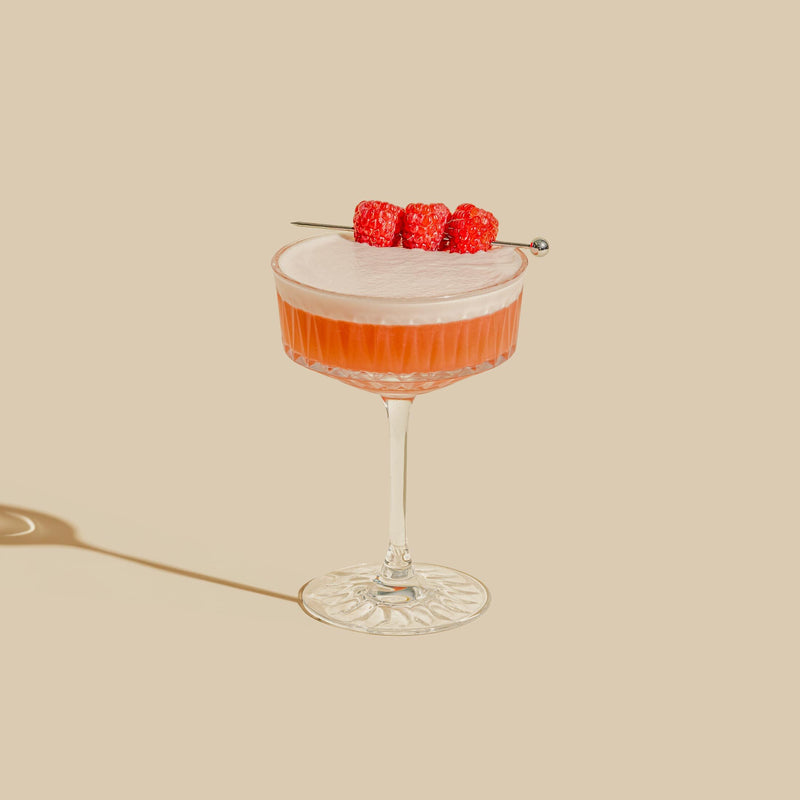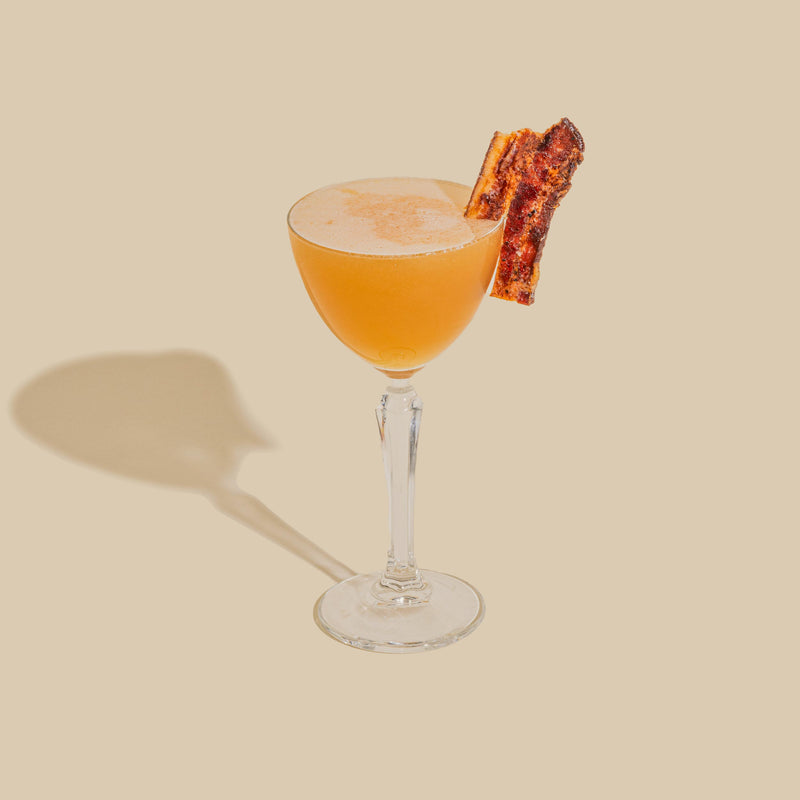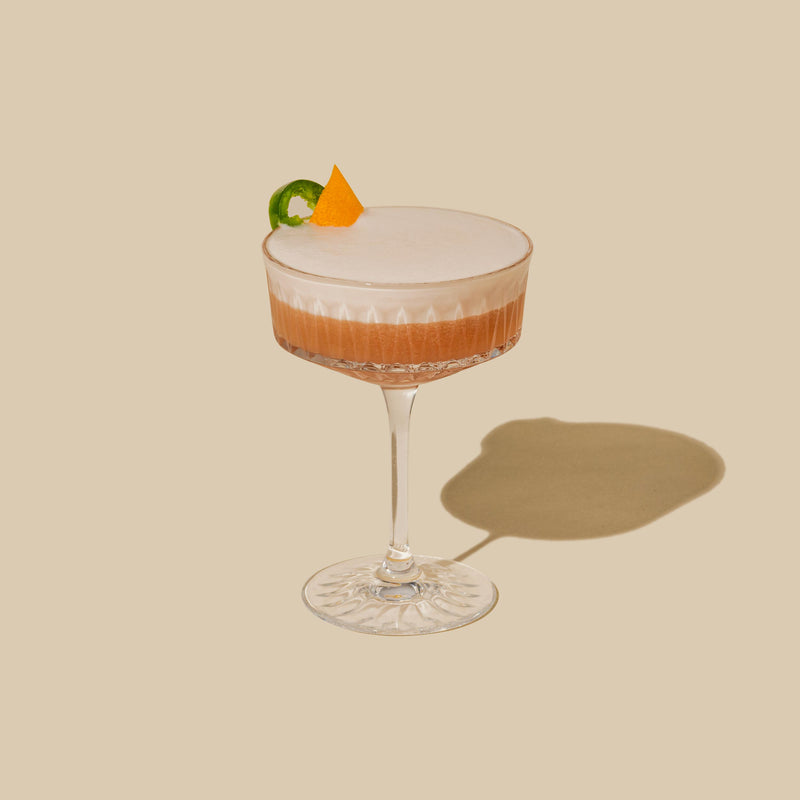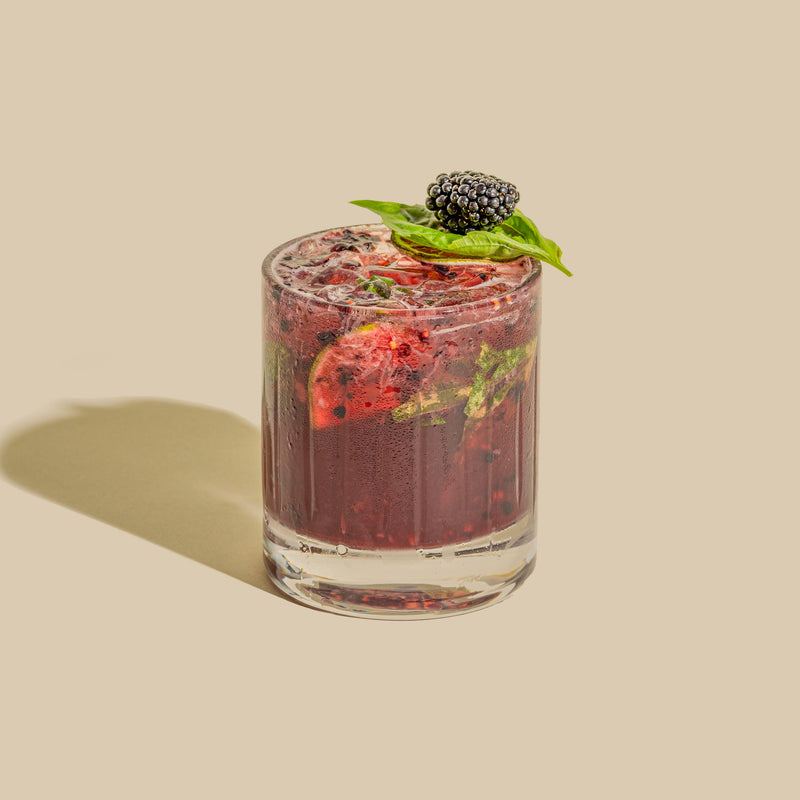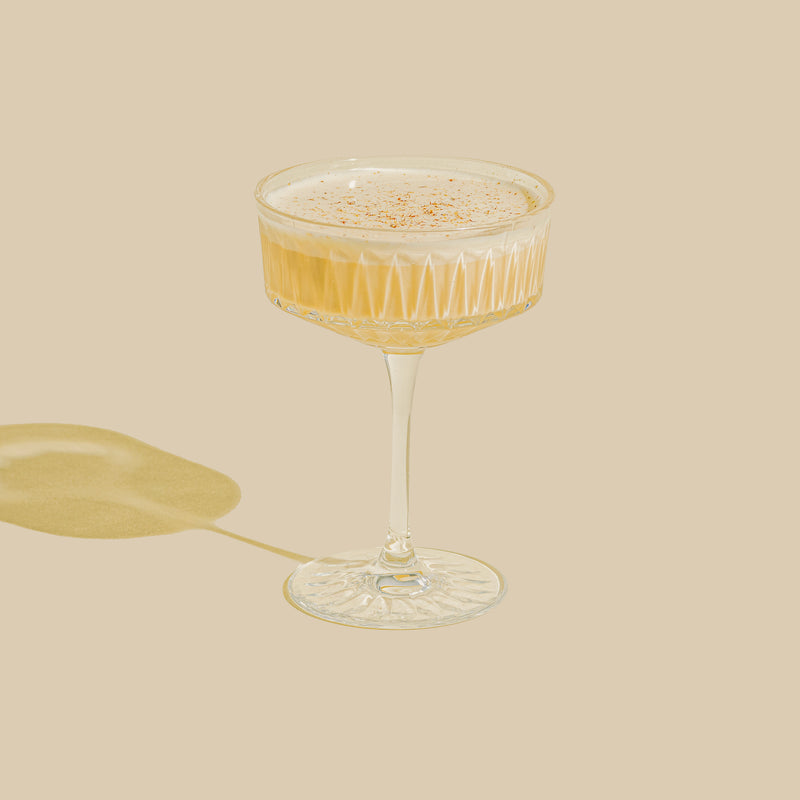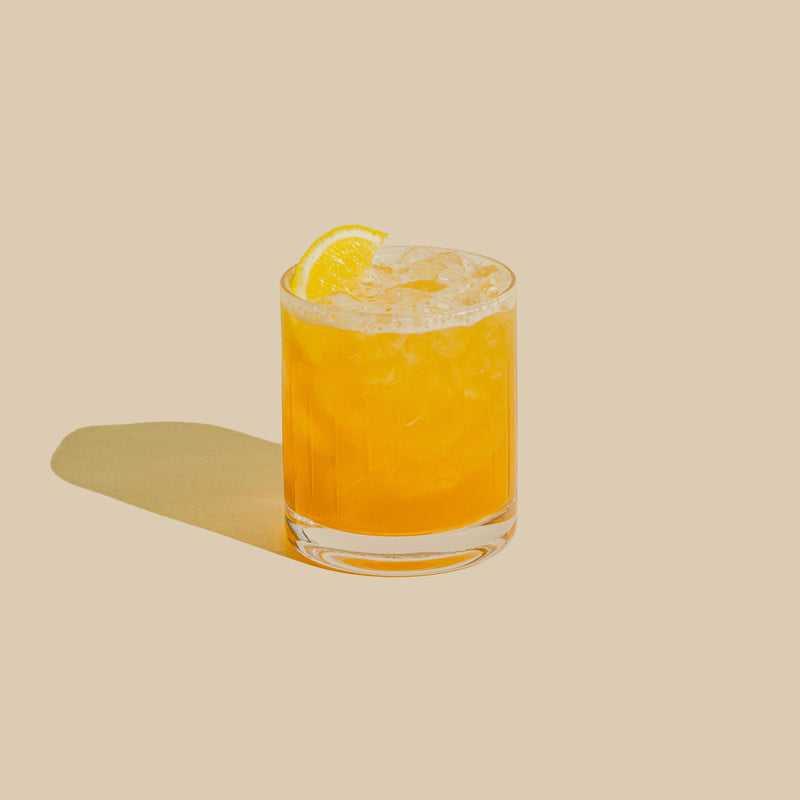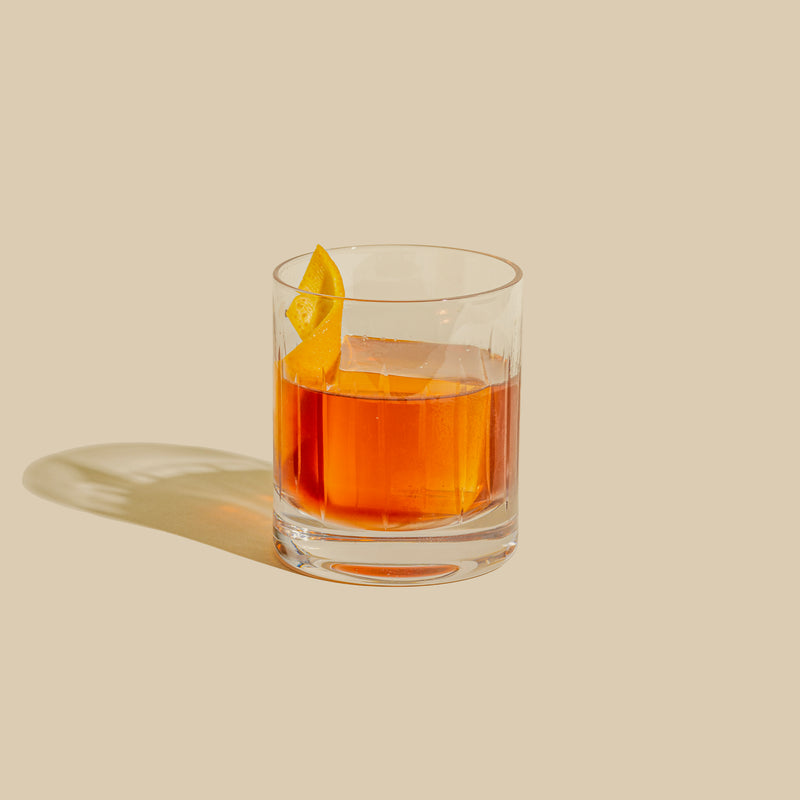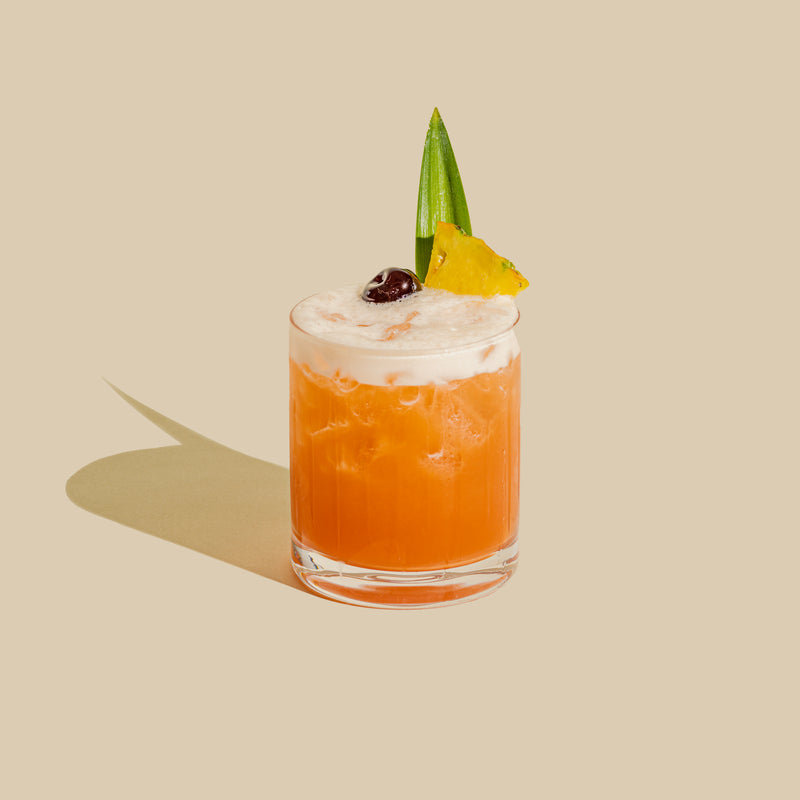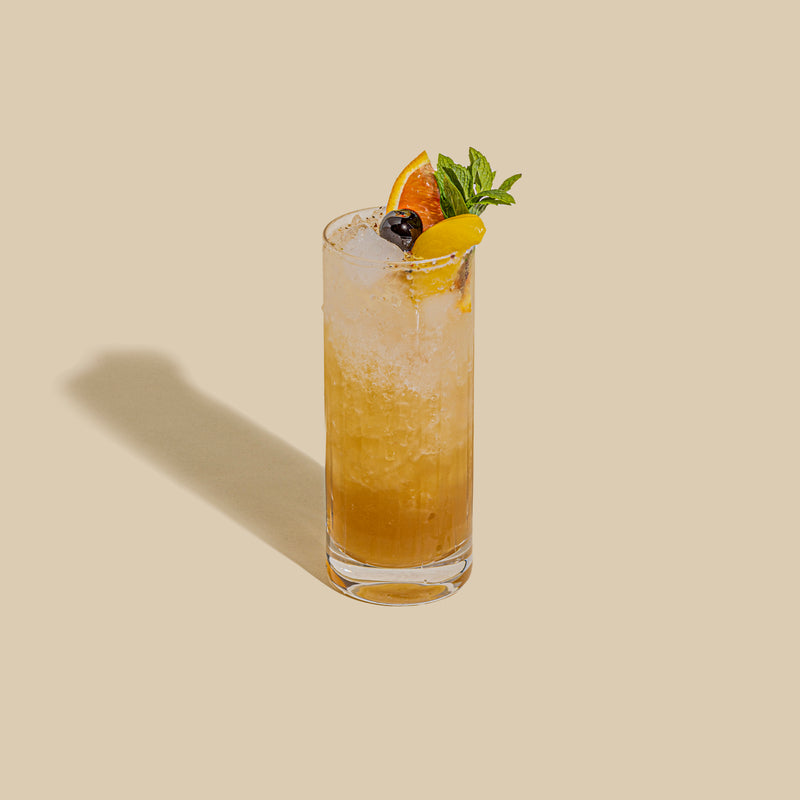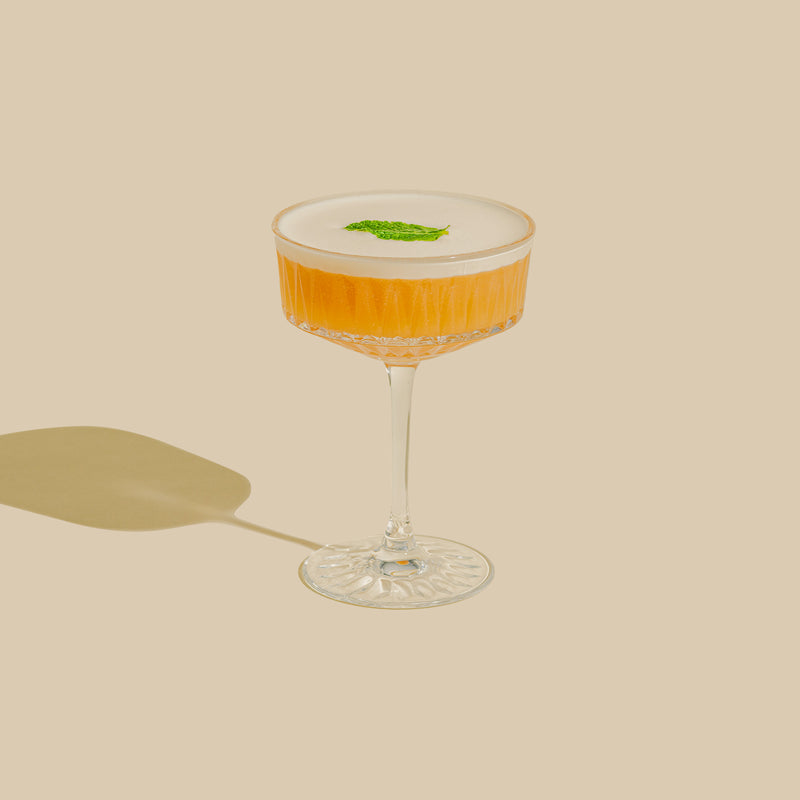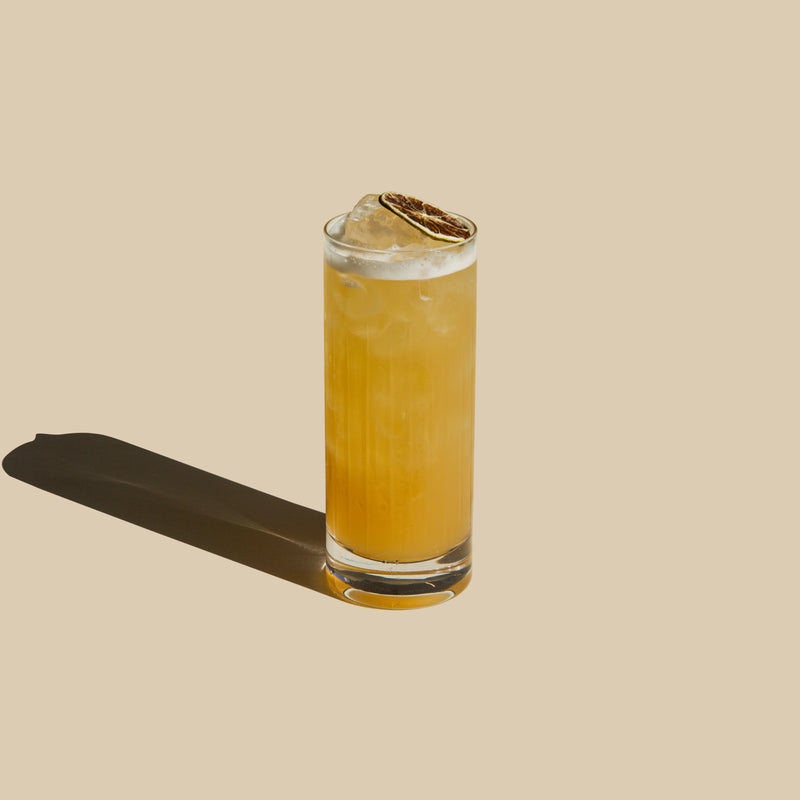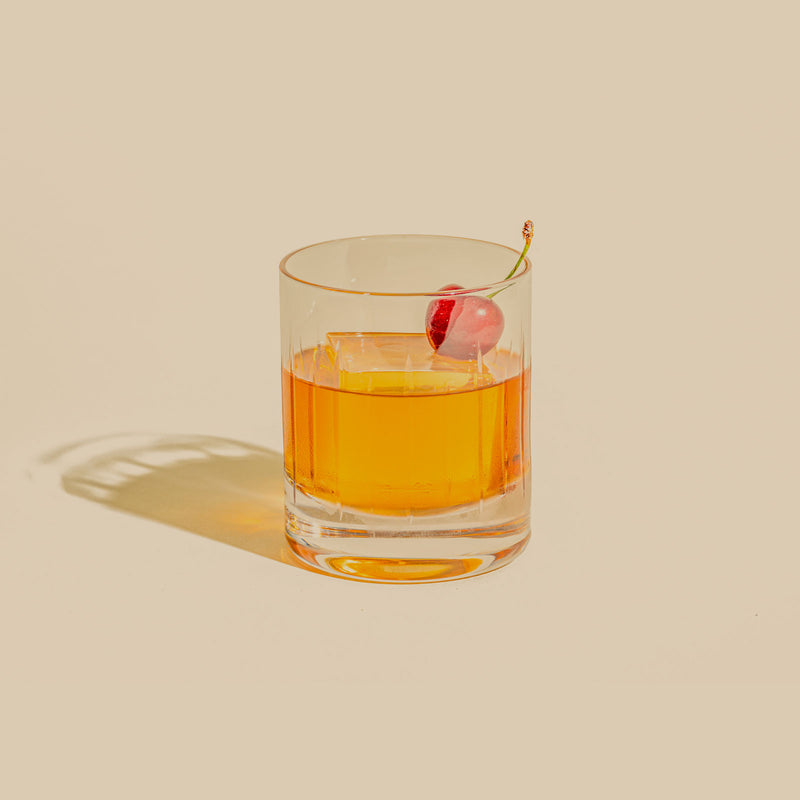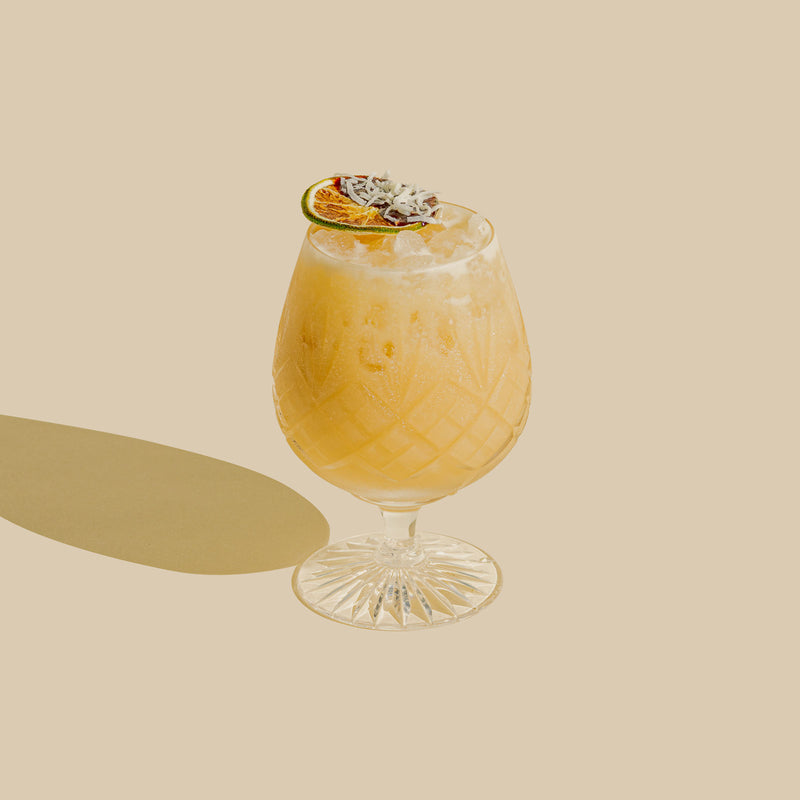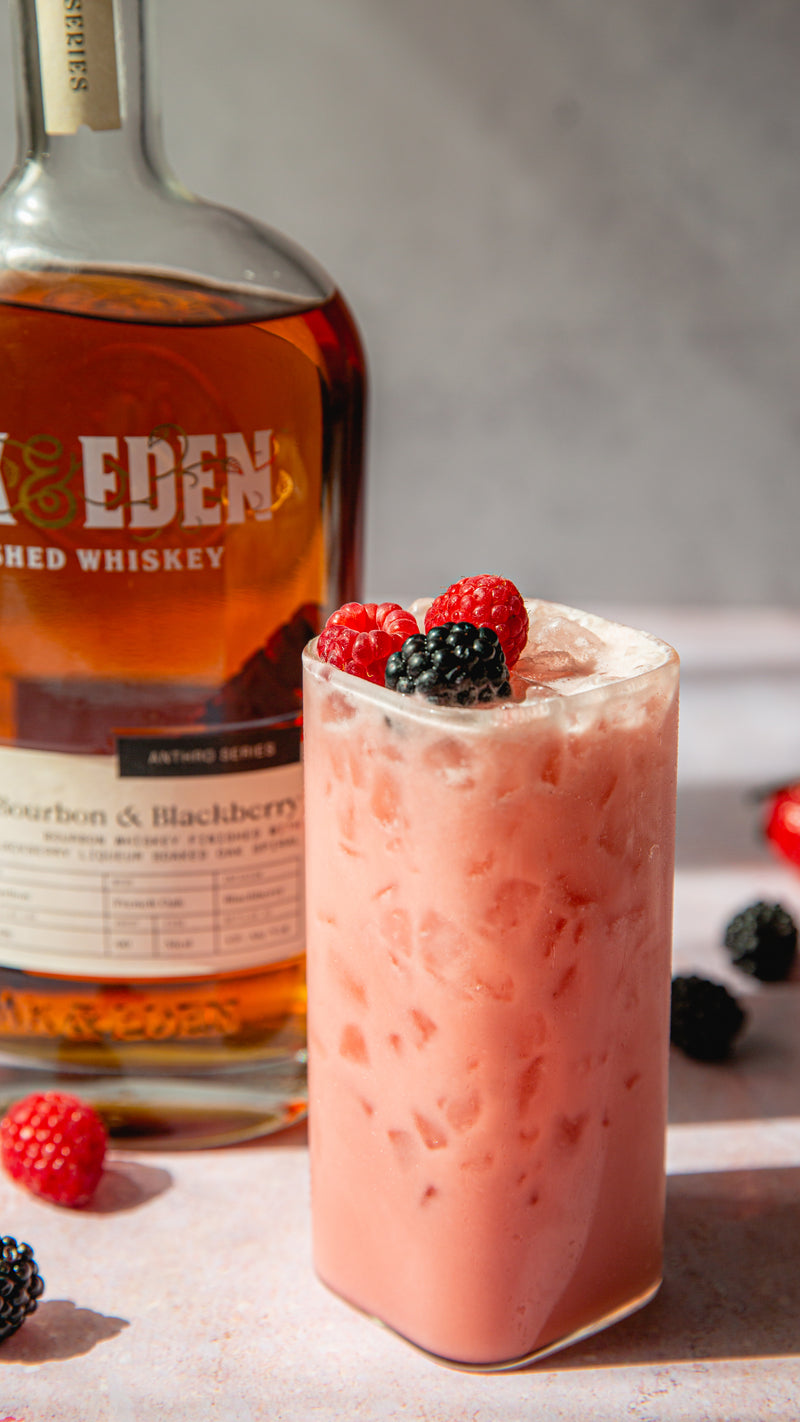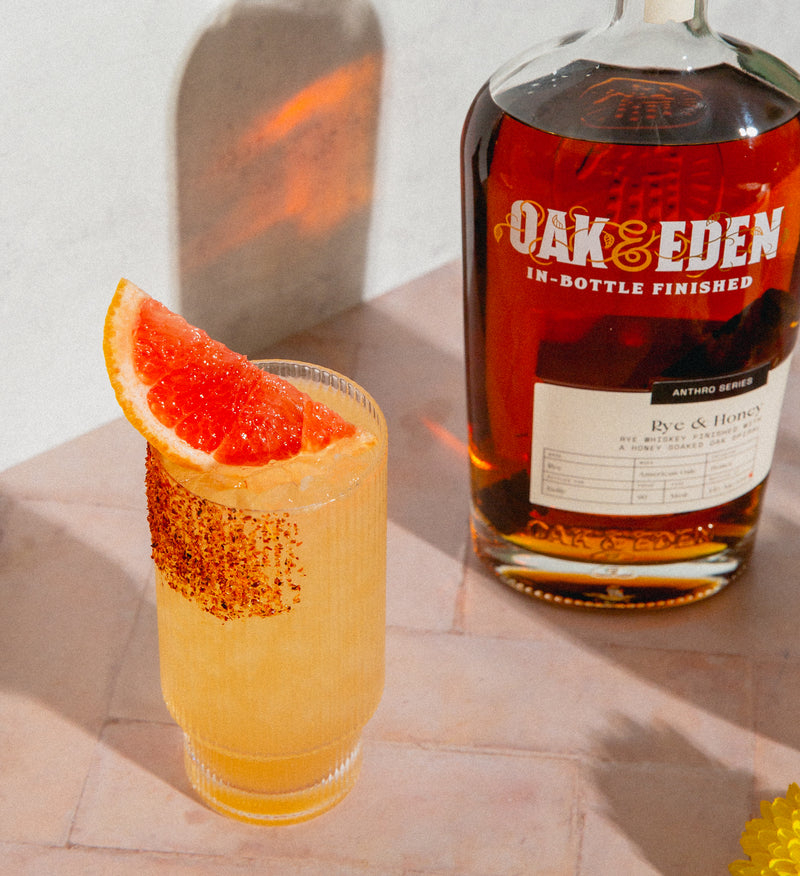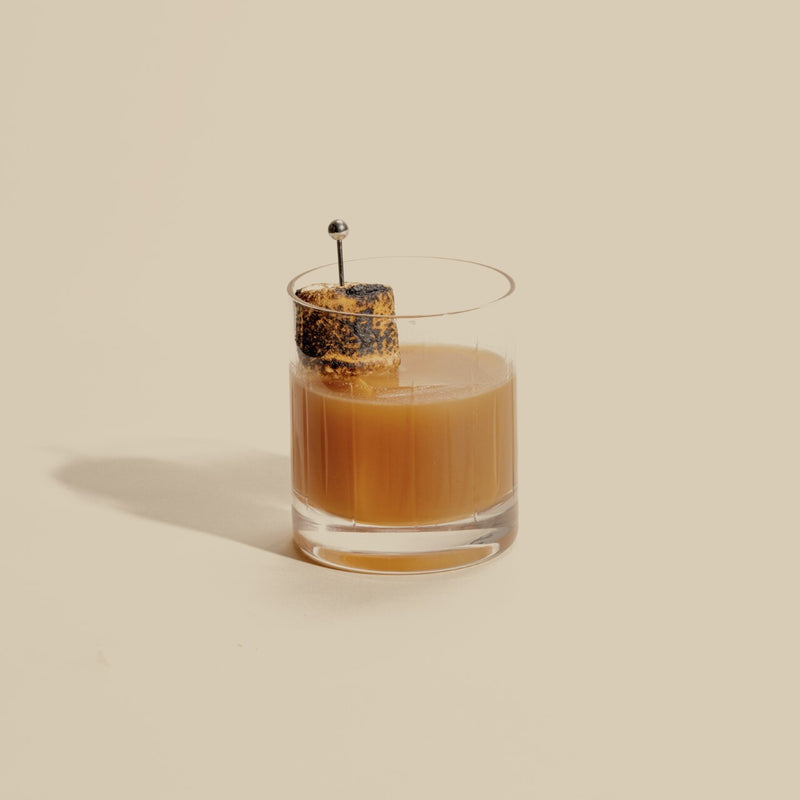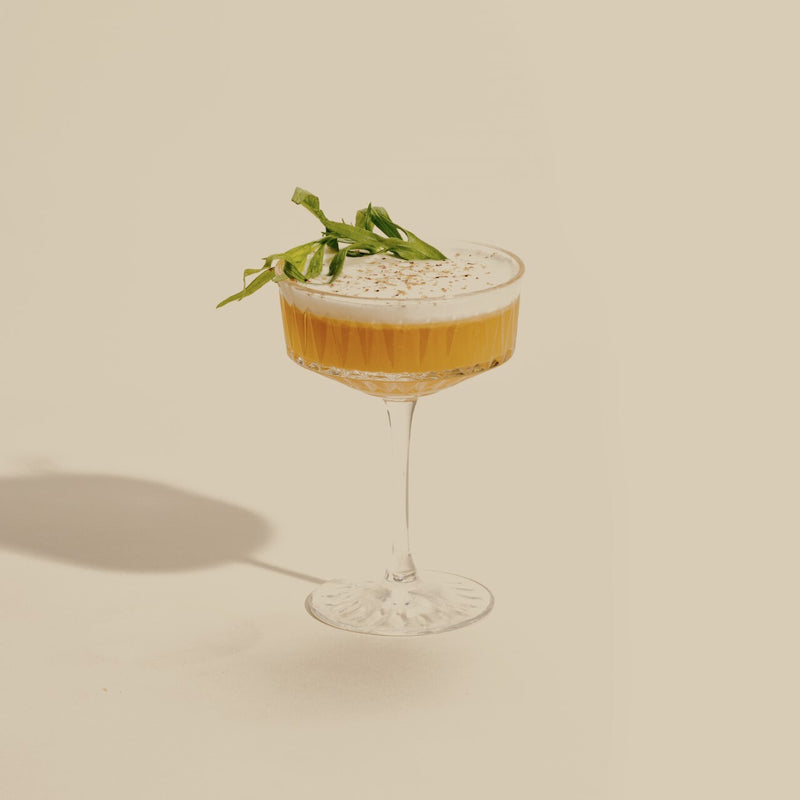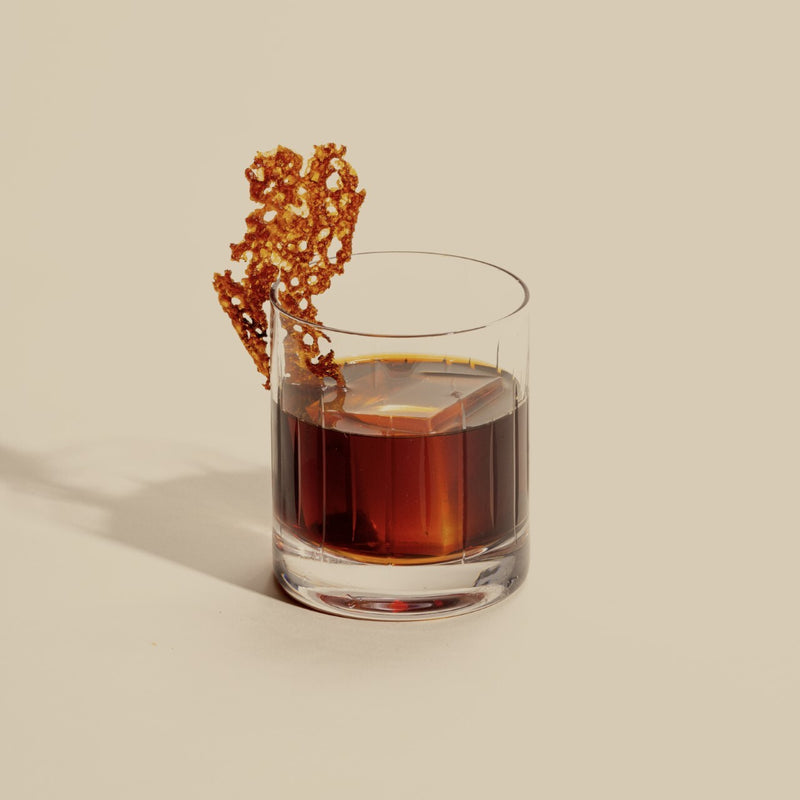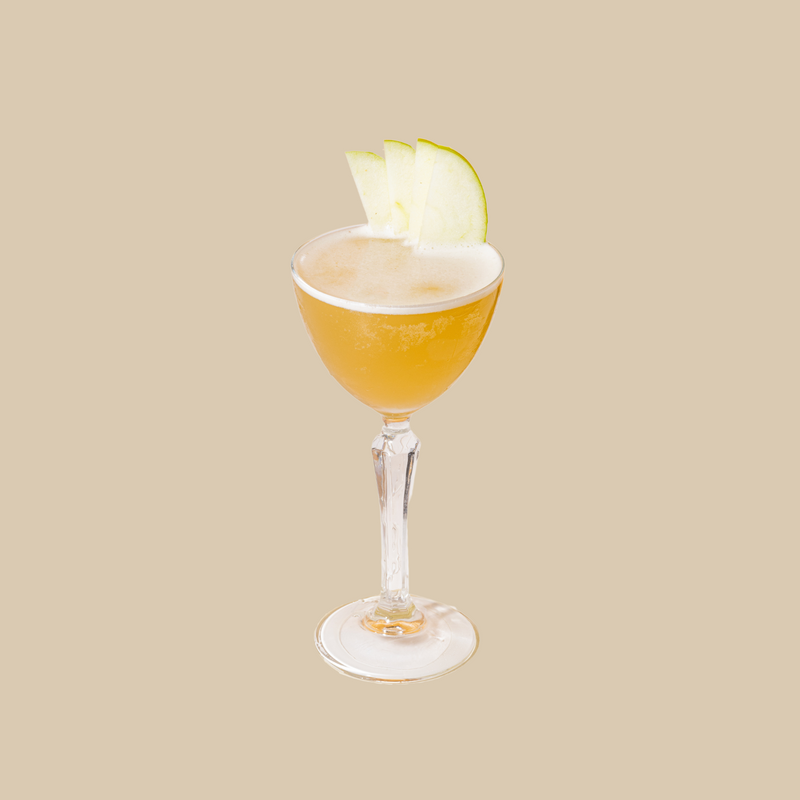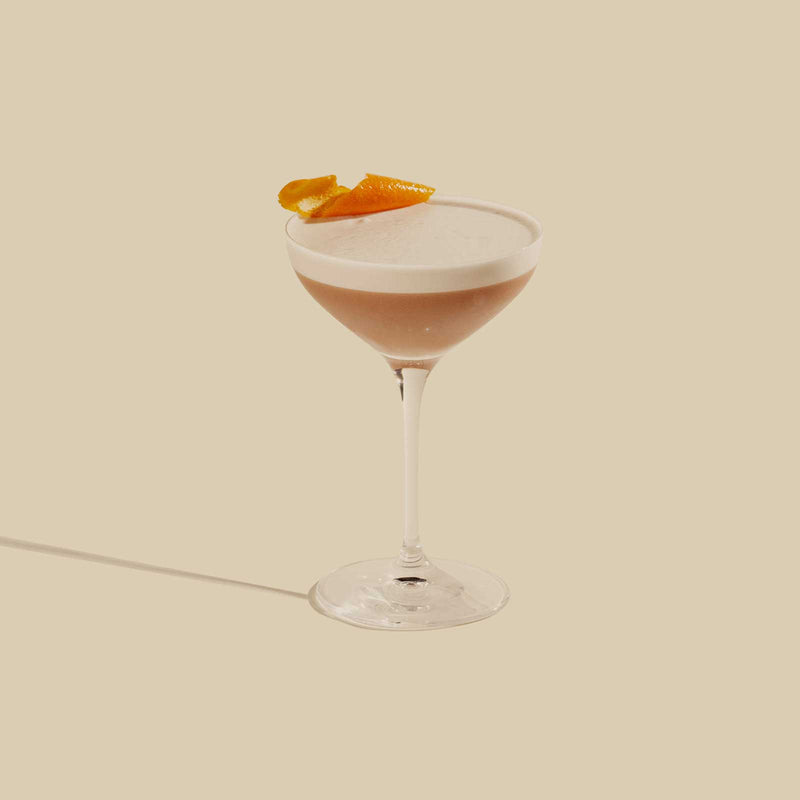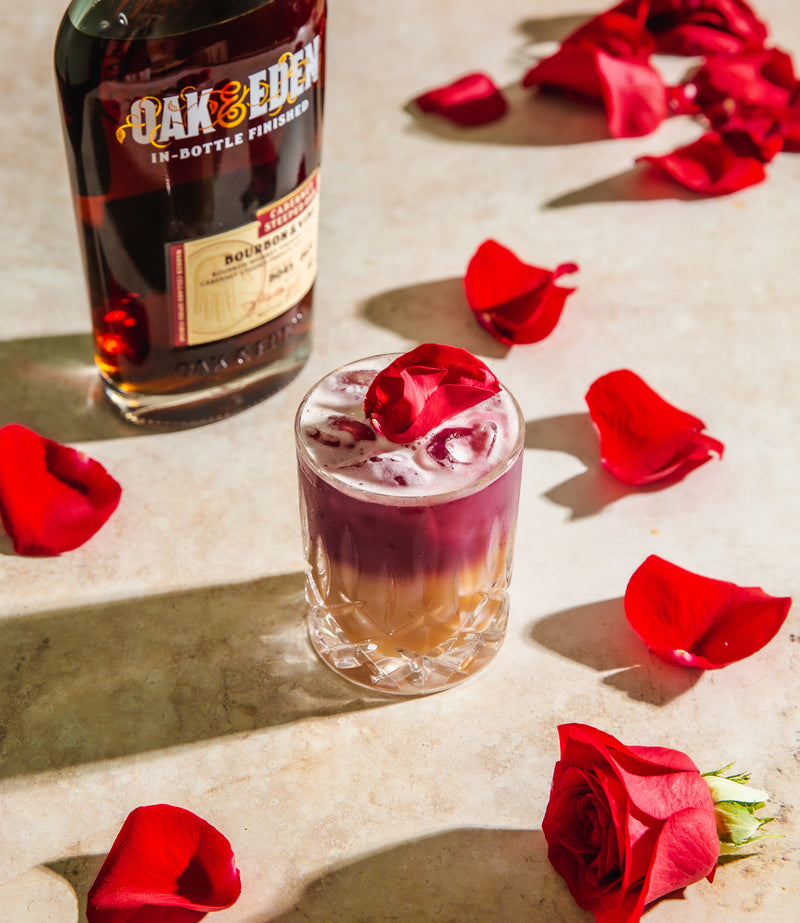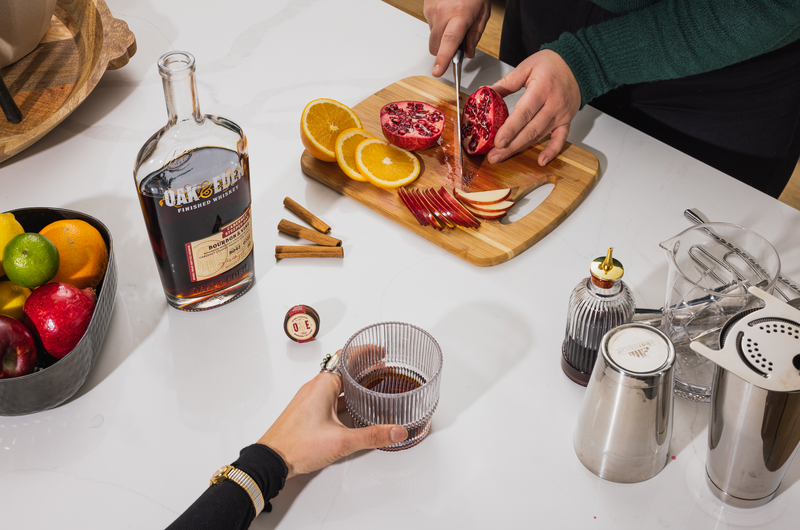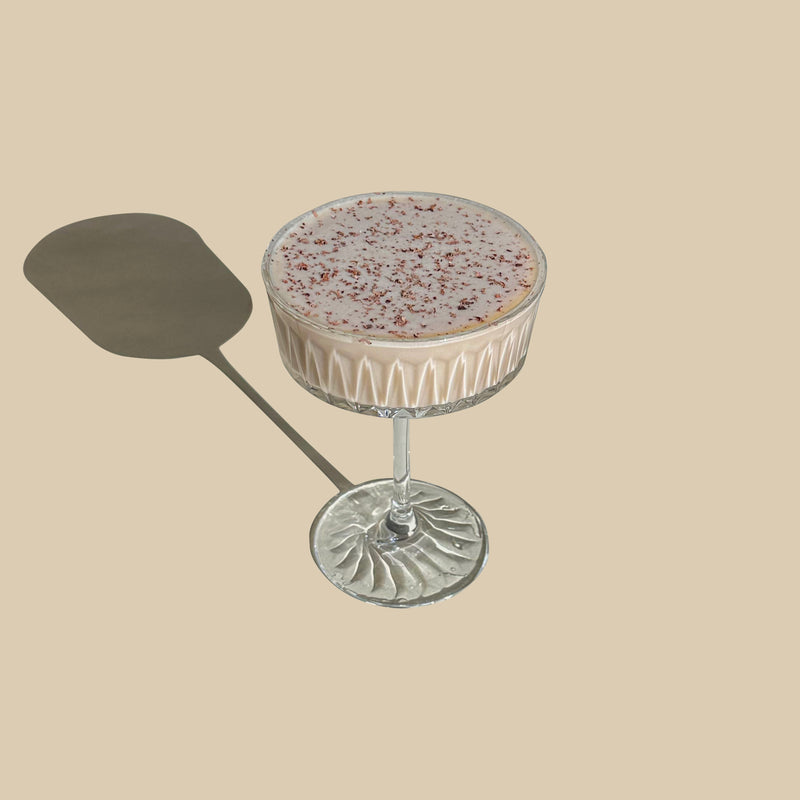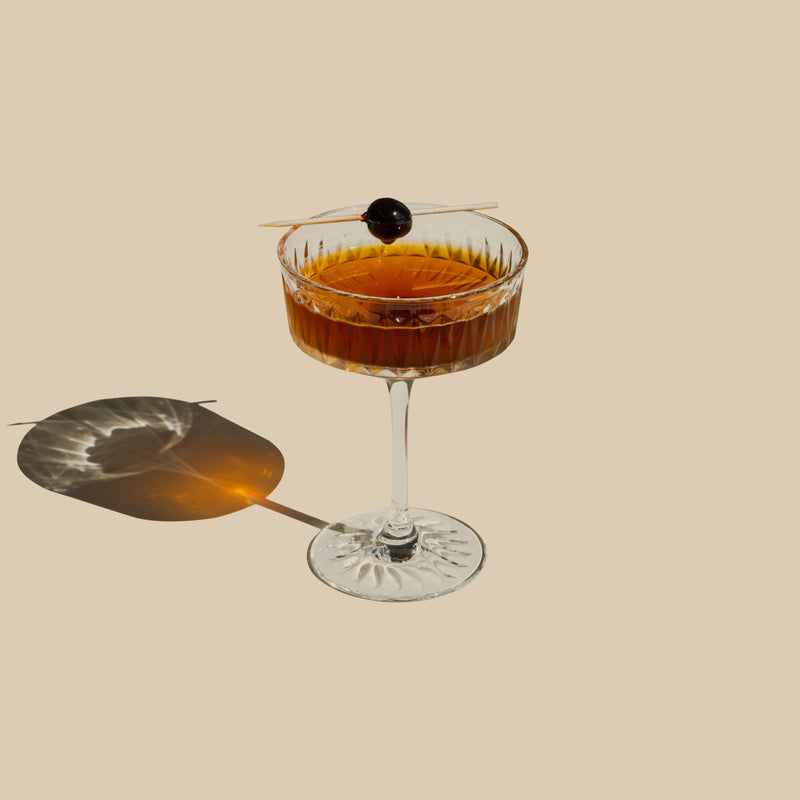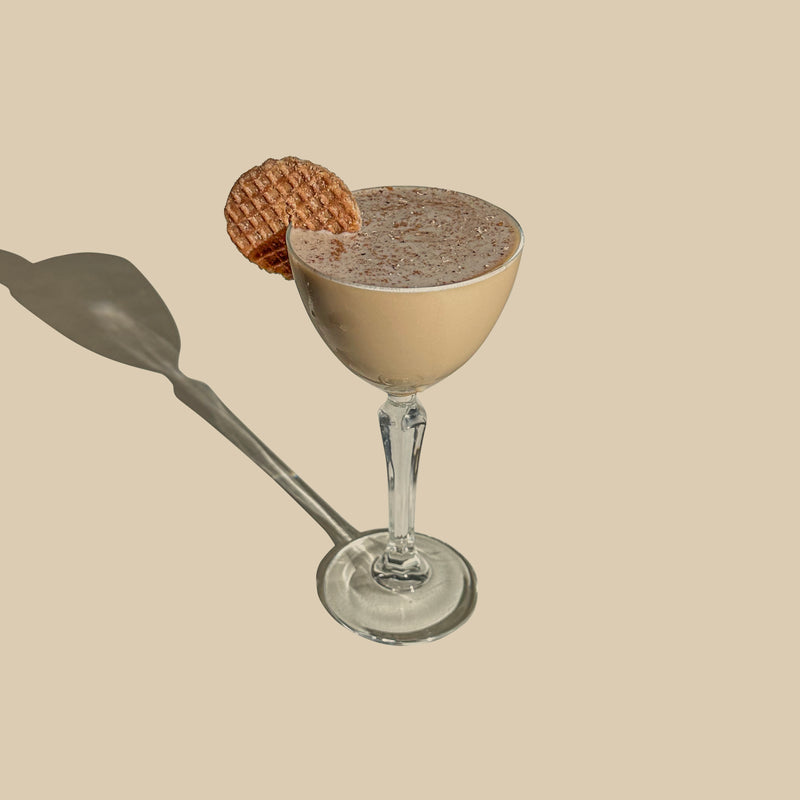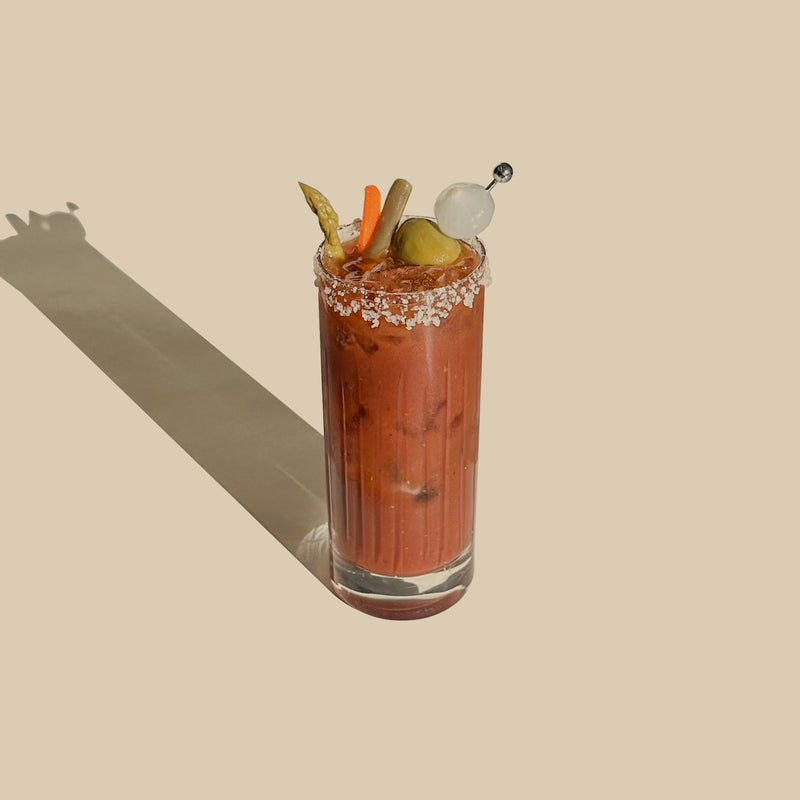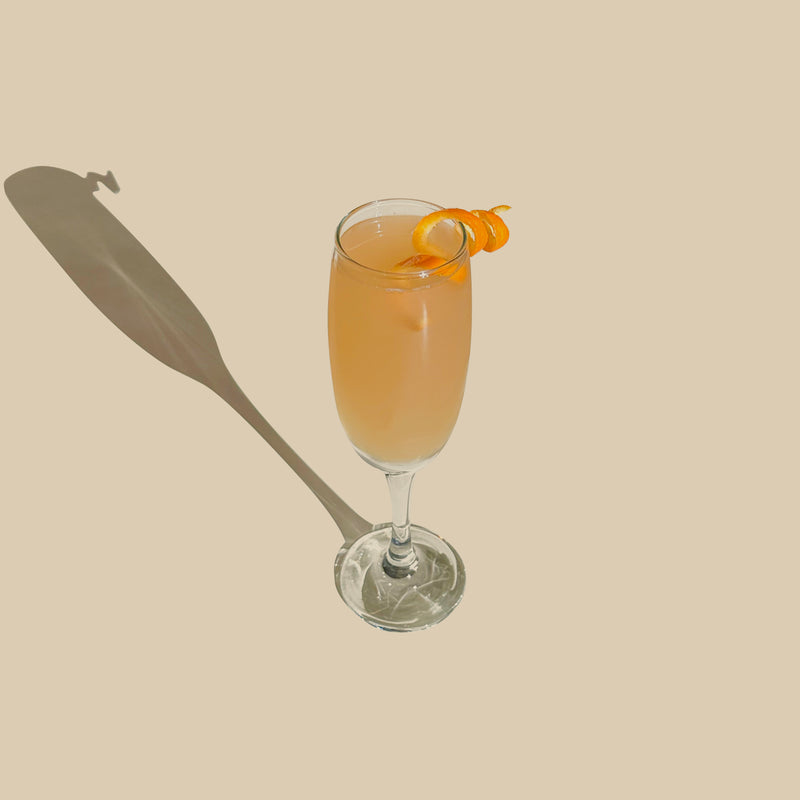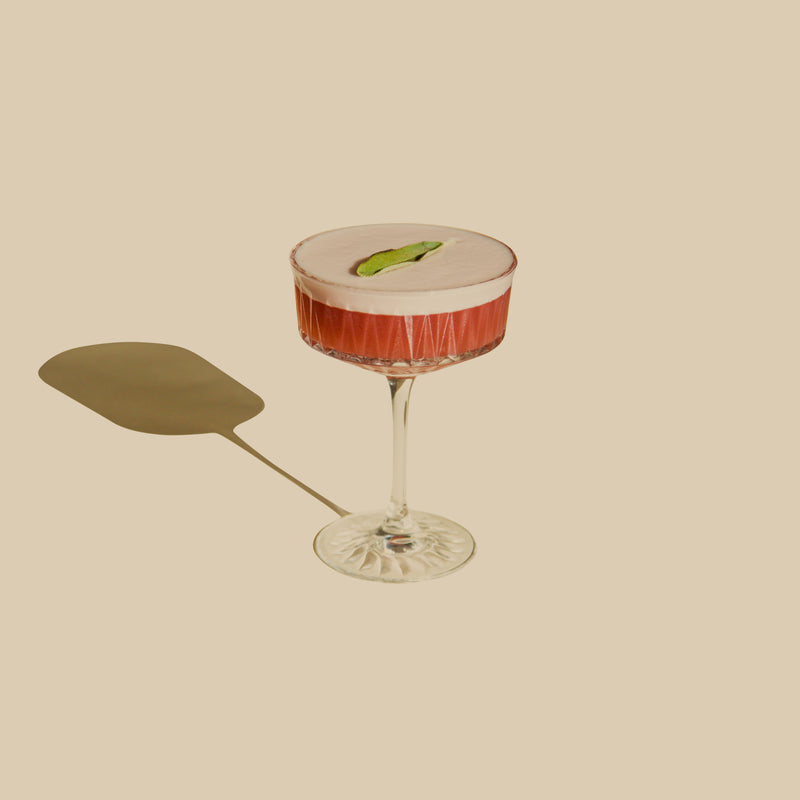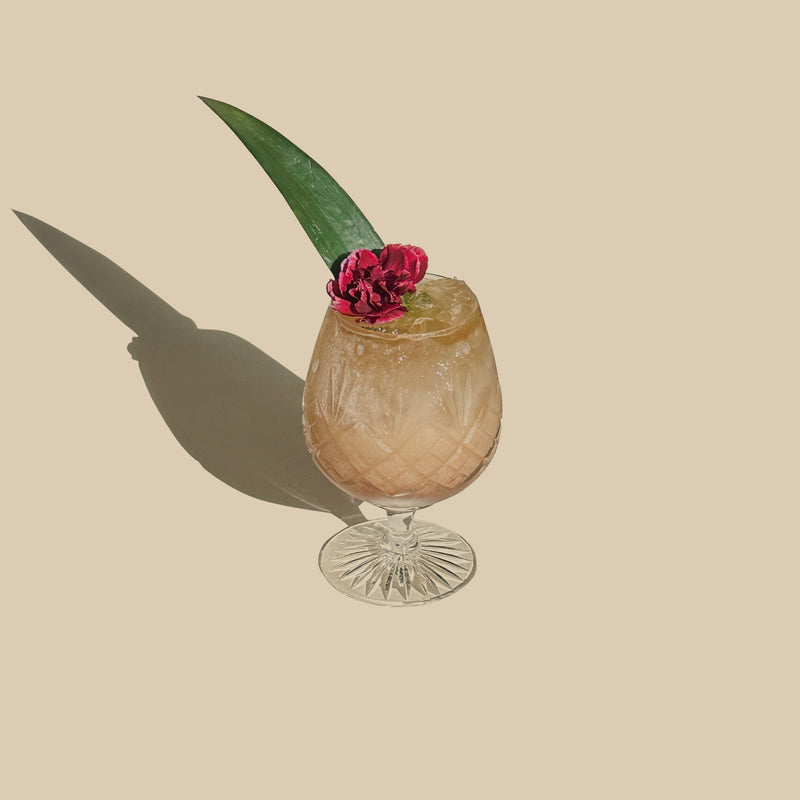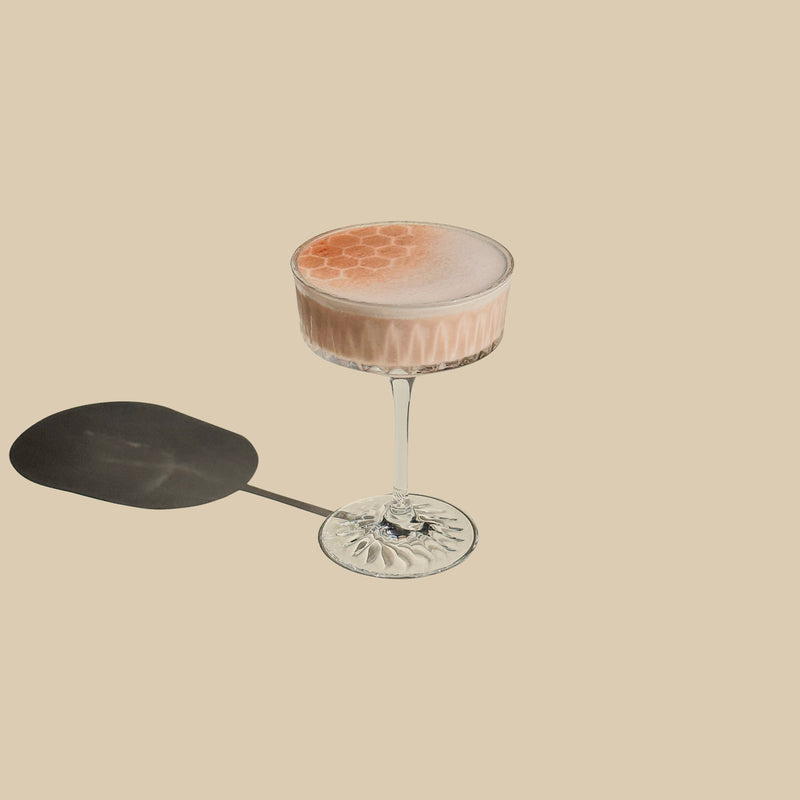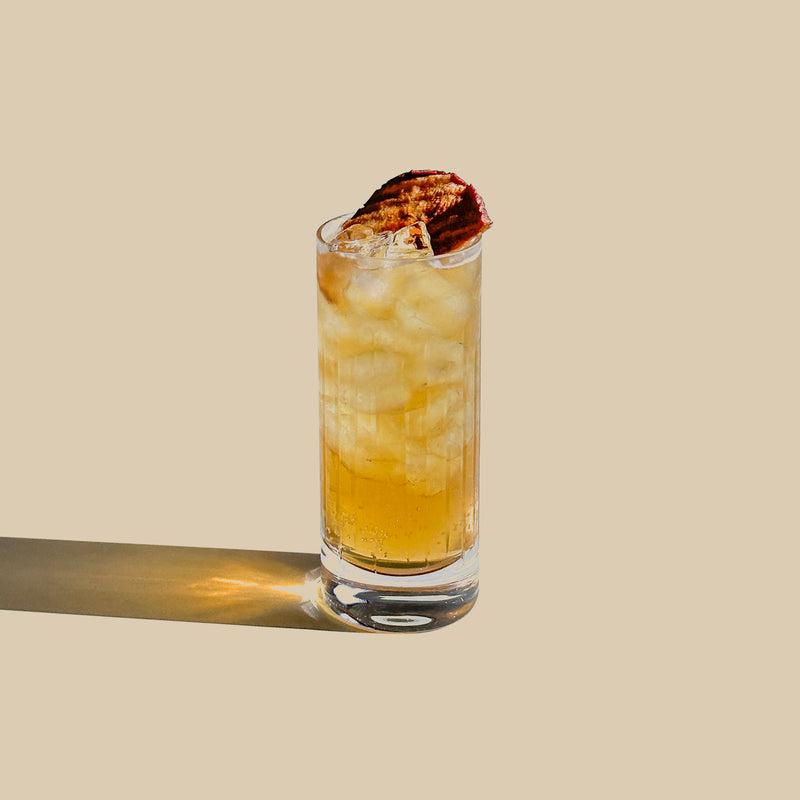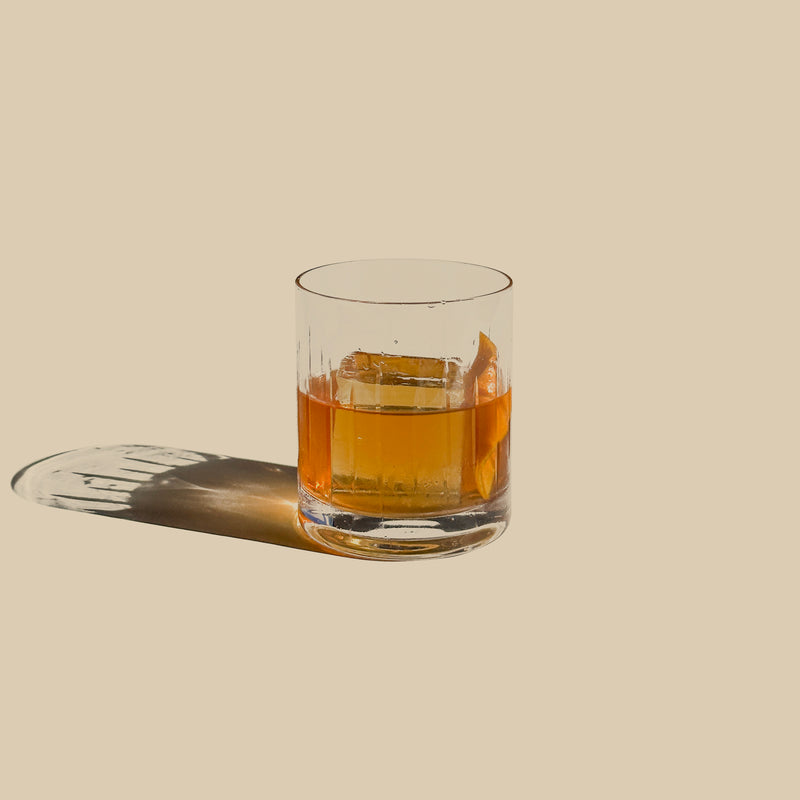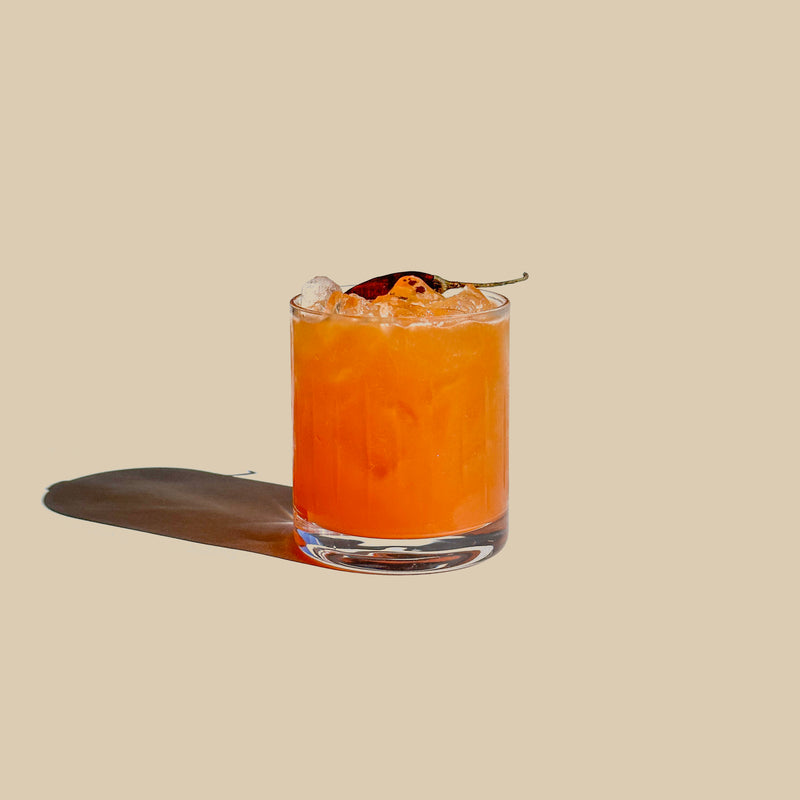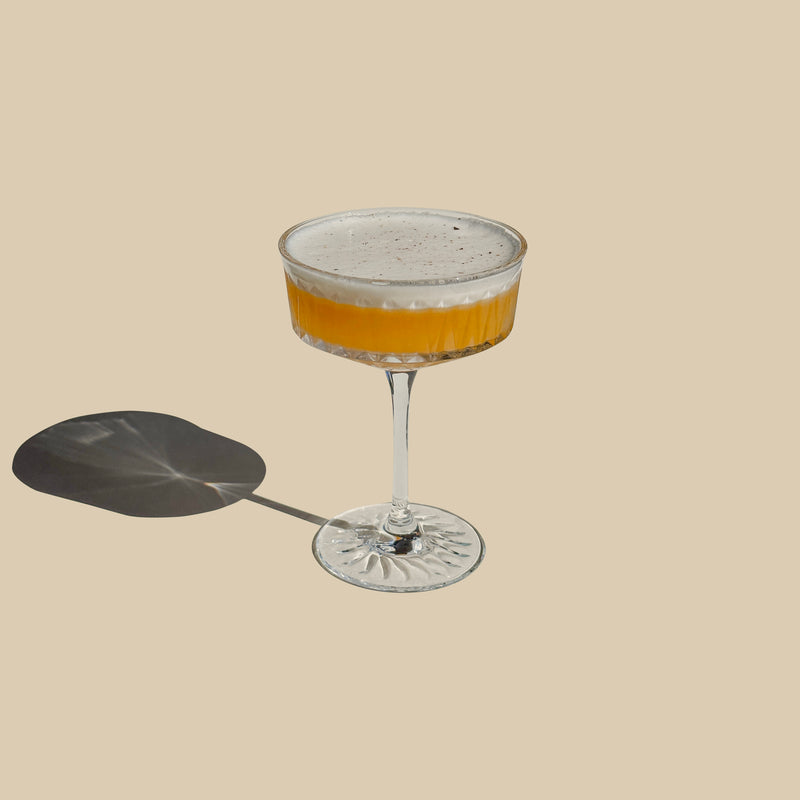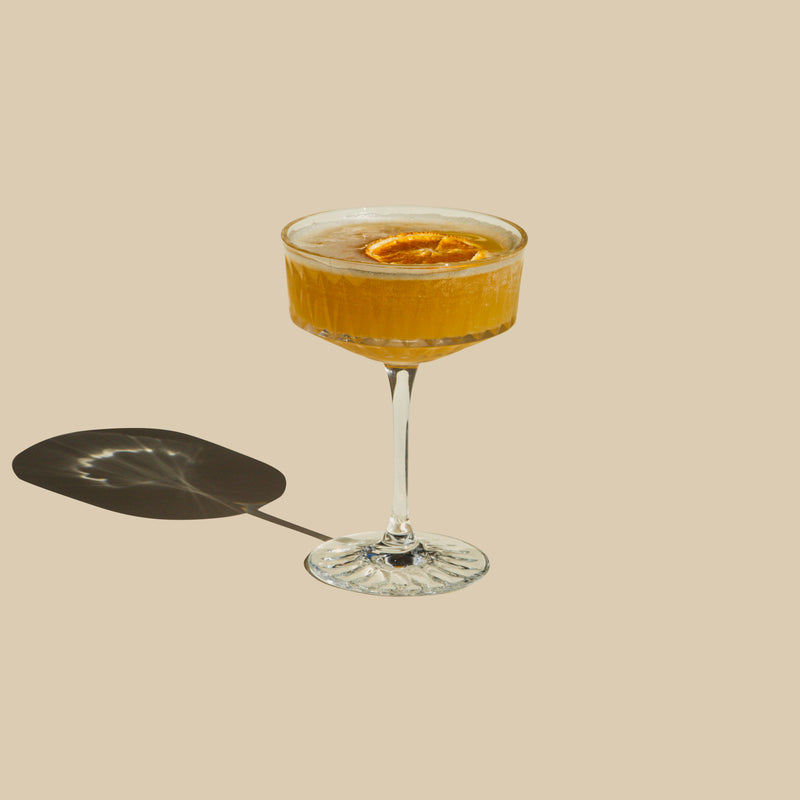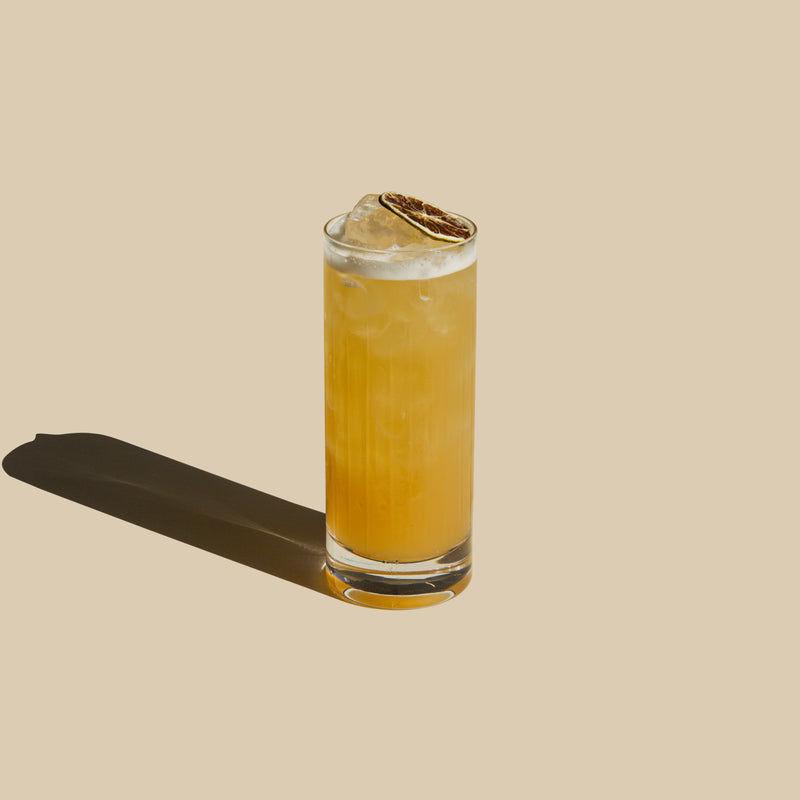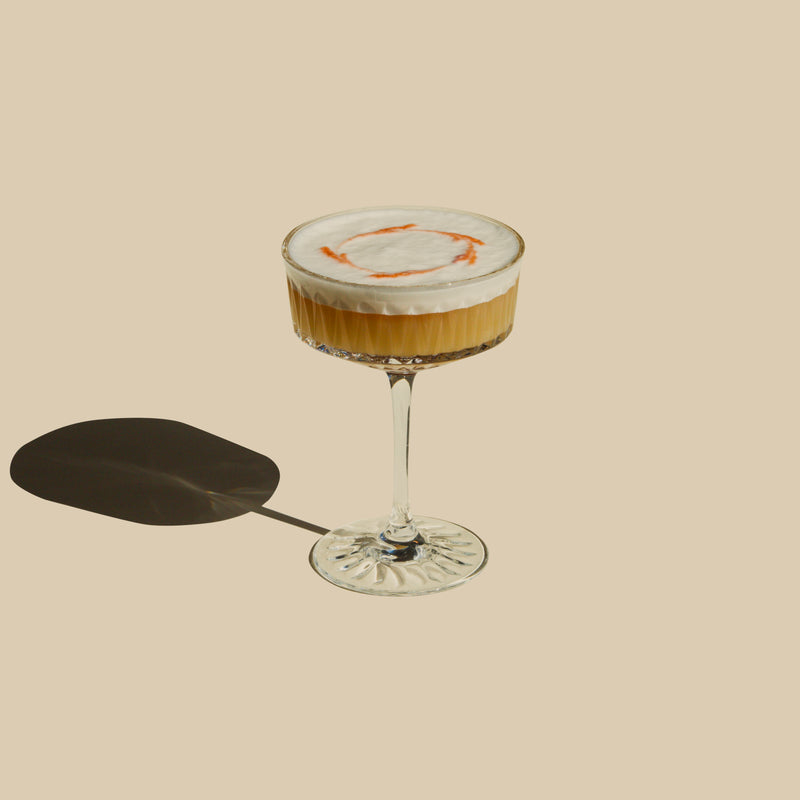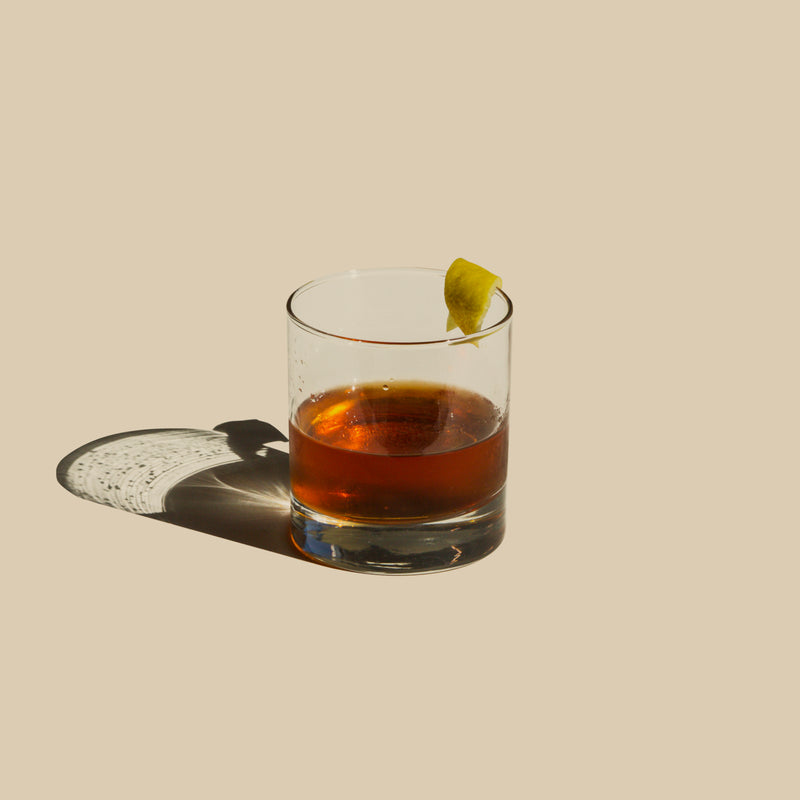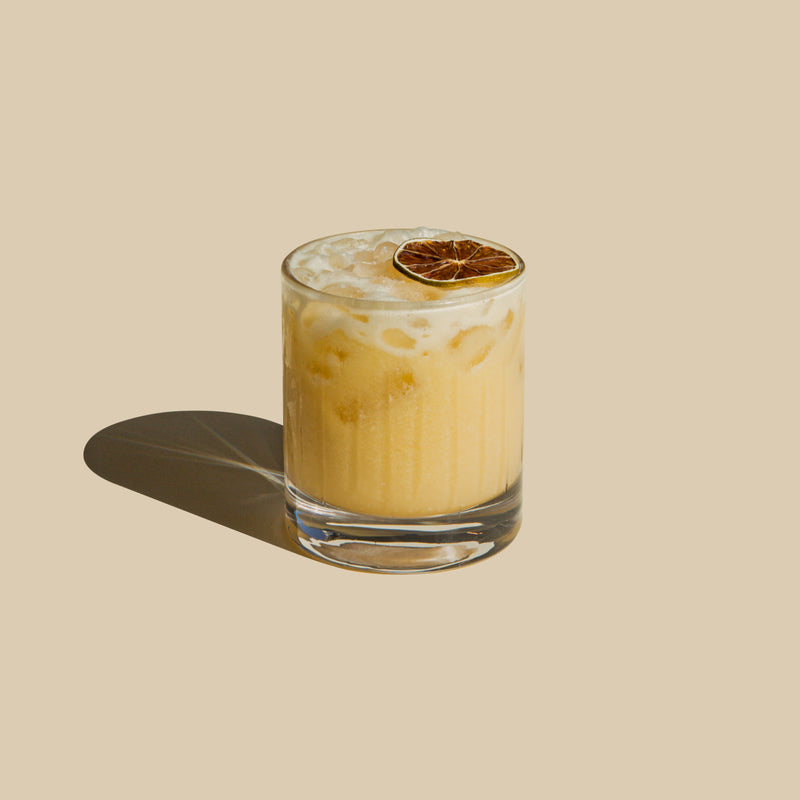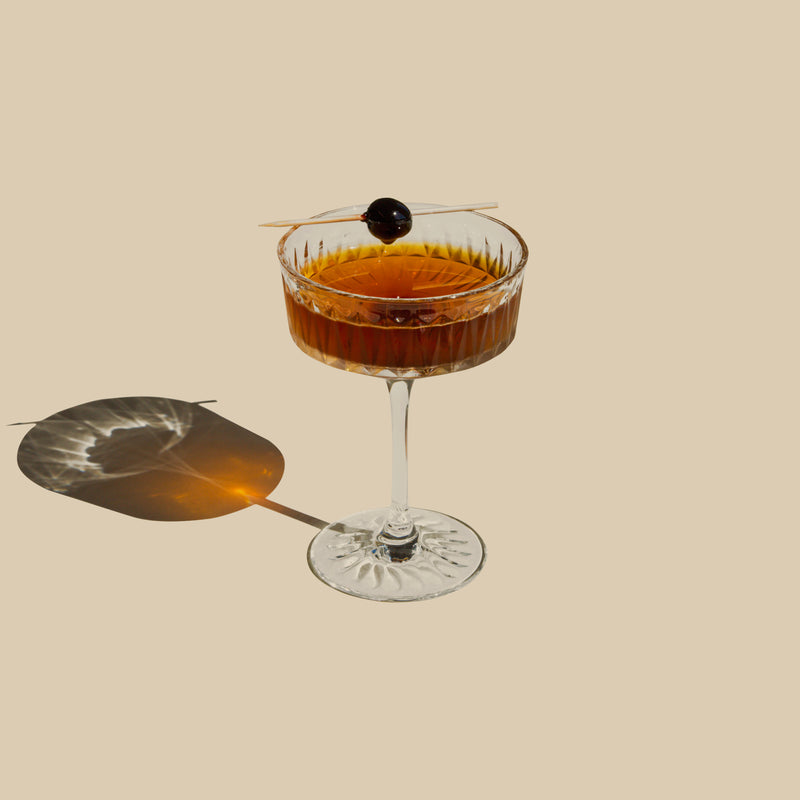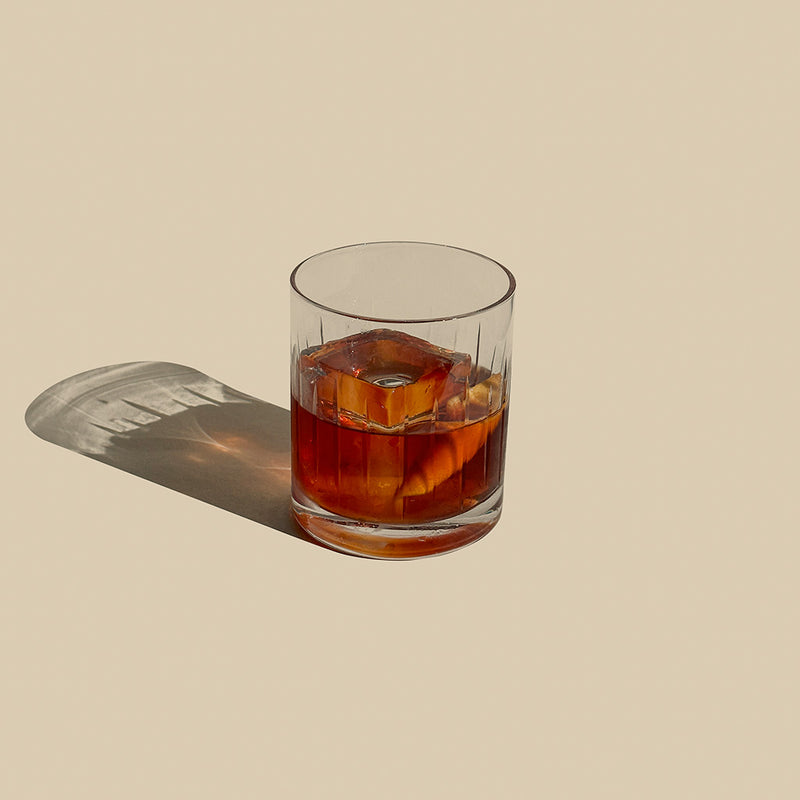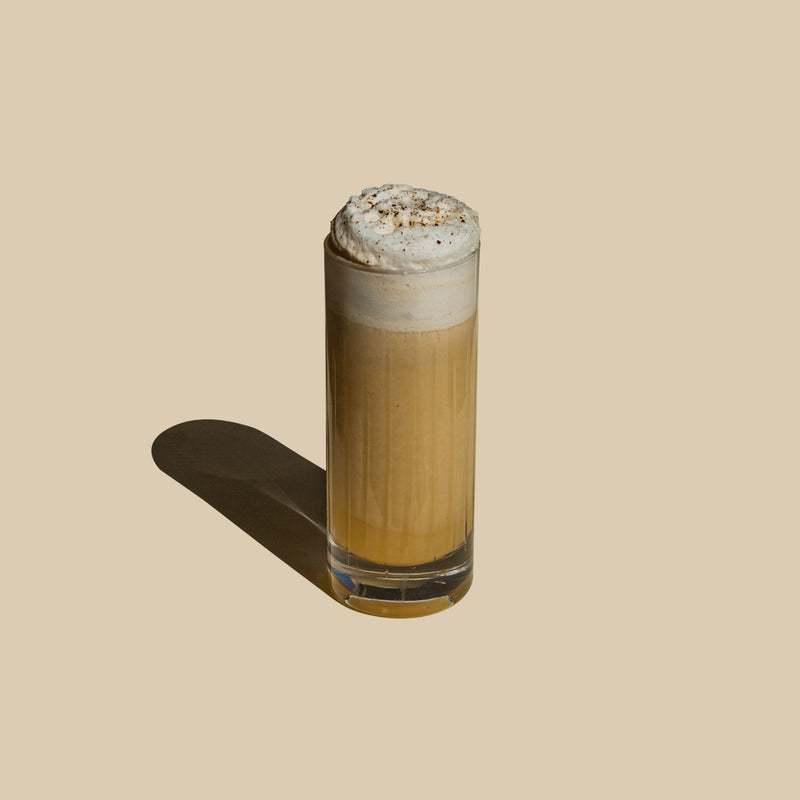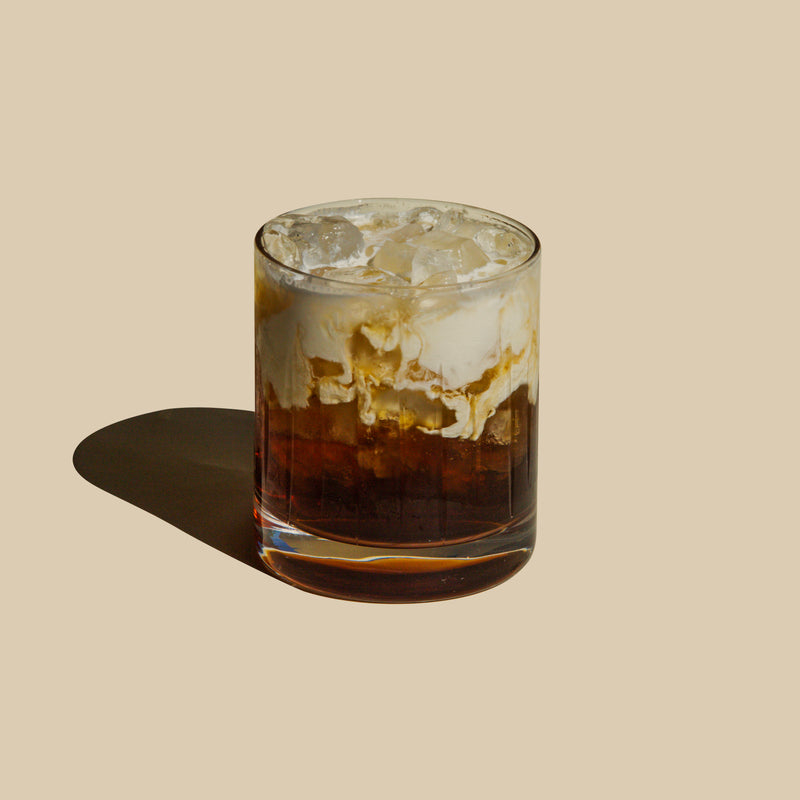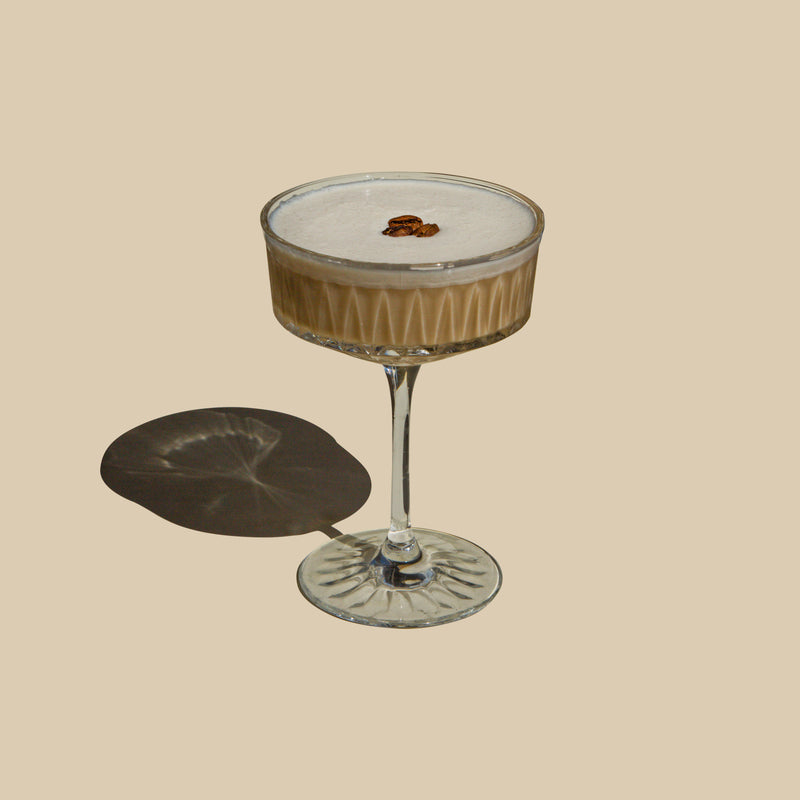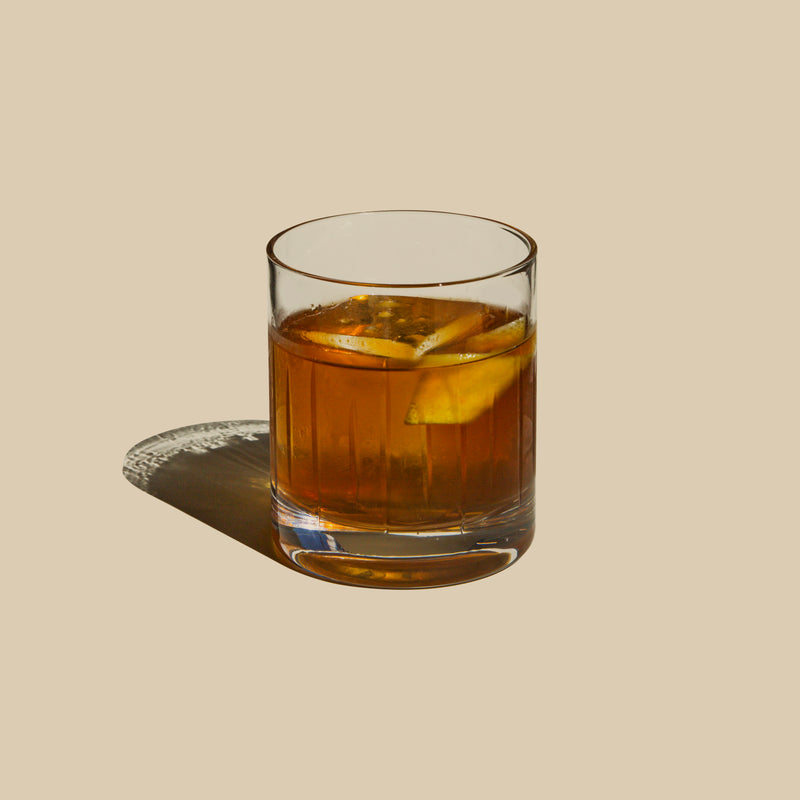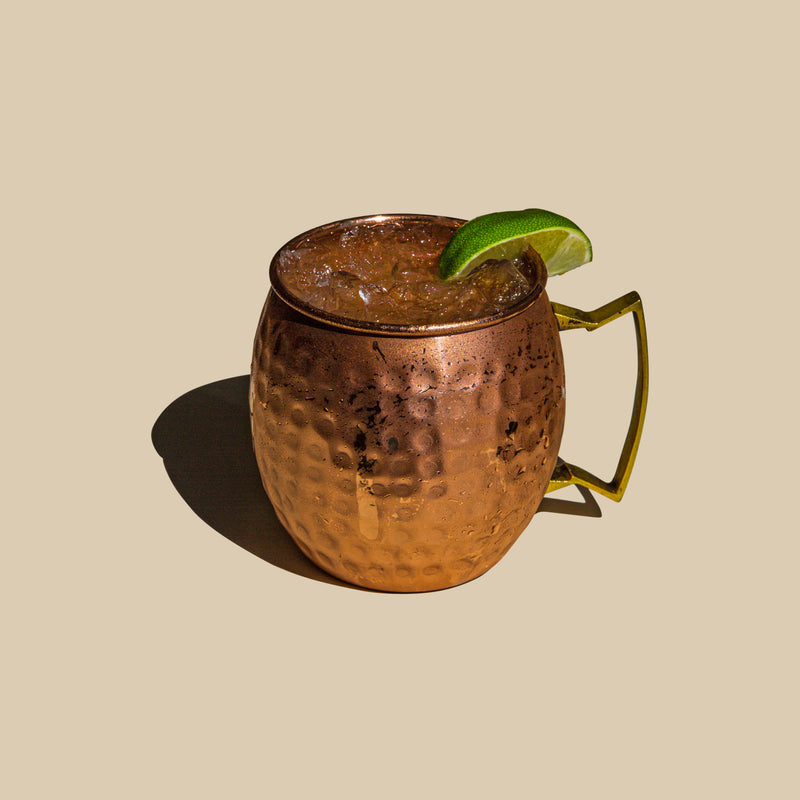
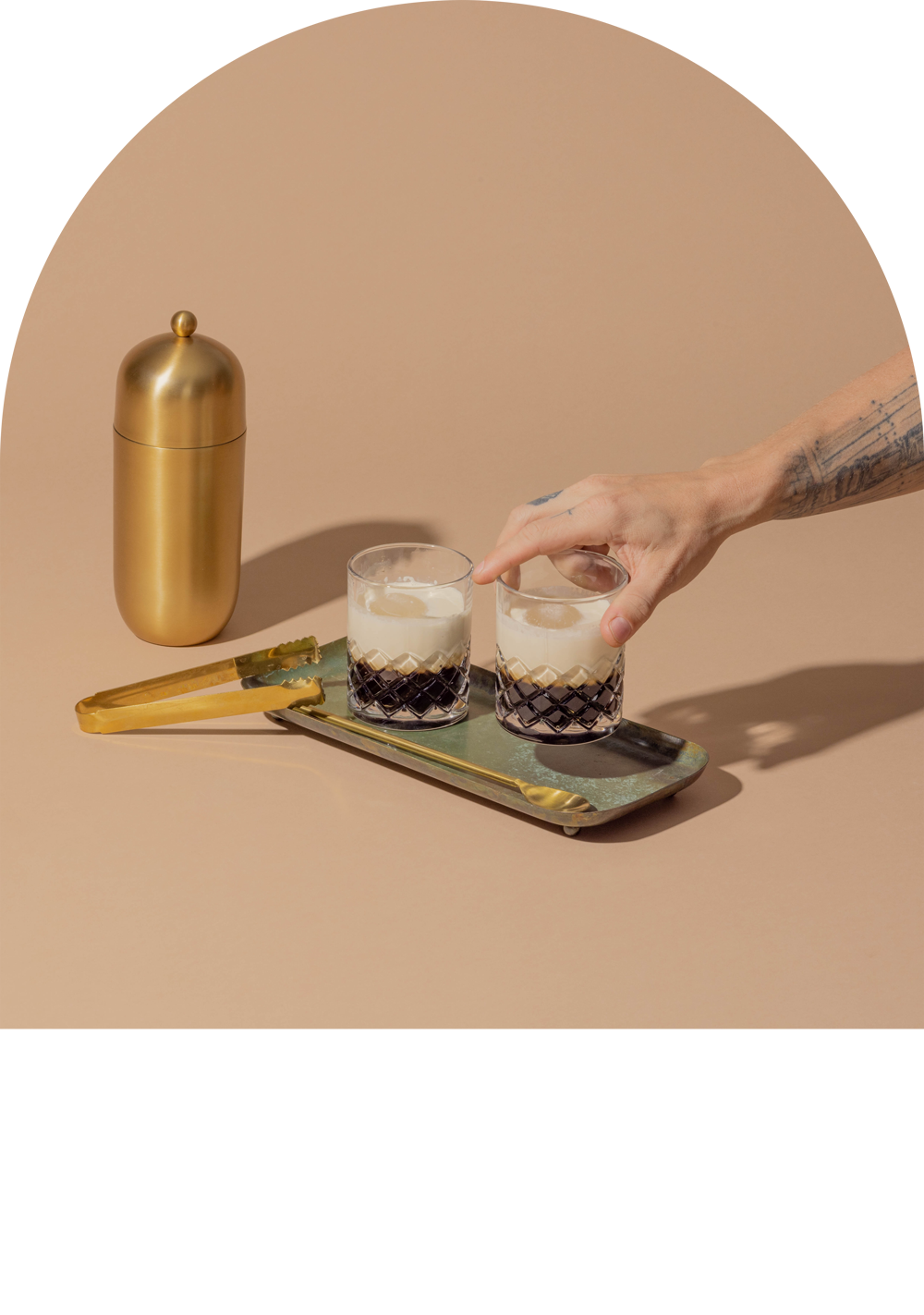
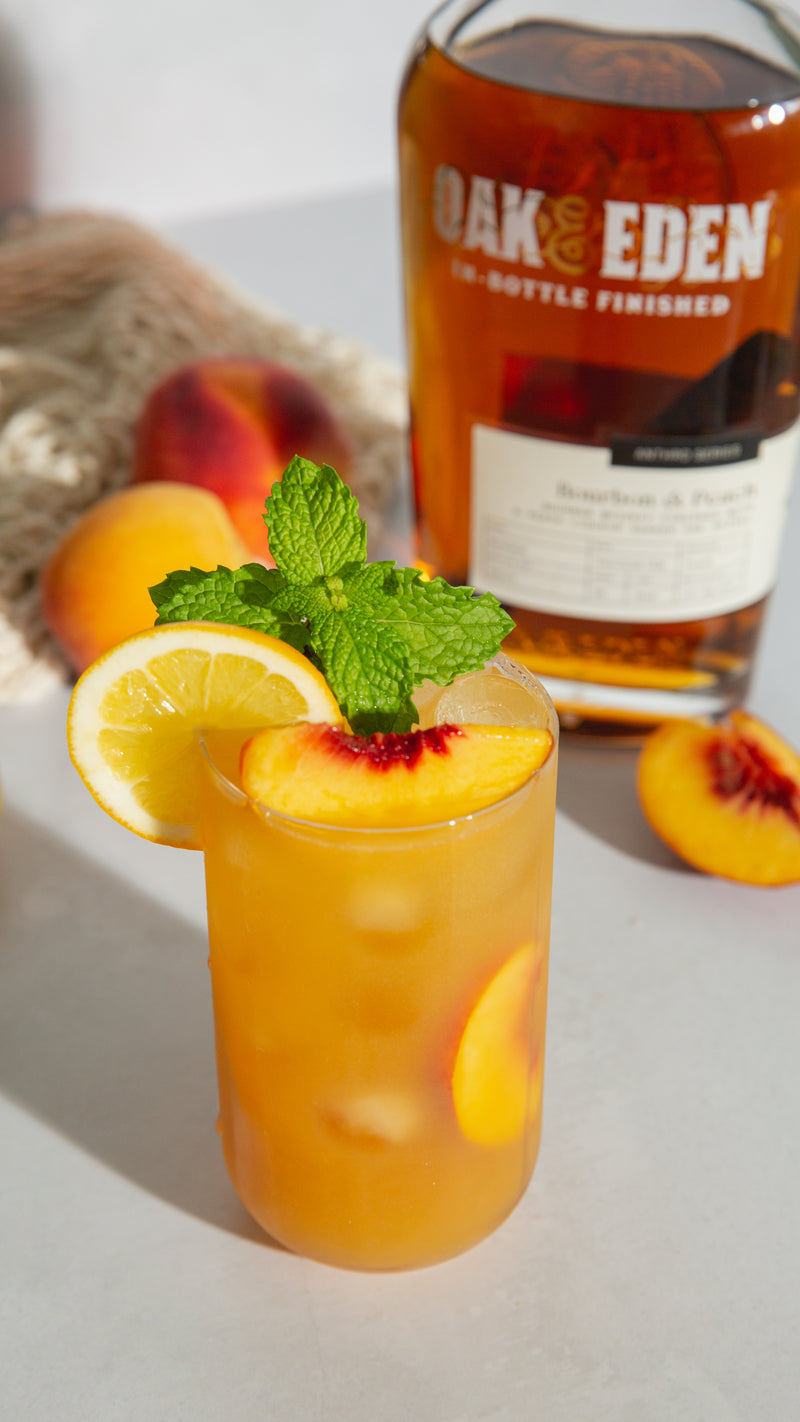
HOT HONEY PEACH LEMONADE BY KELLY PETTIT
INGREDIENTS
1.5oz Peach Infused Bourbon (90 proof) - Custom bottle creation3 oz Hot Honey Peach Purée1.5oz Lemon Juice1oz water
DIRECTIONS
What you’ll need for the Hot Honey Peach Purée: Hot Honey Syrup (2oz Hot Honey and 2oz Hot Water + Shake), 2 small peaches (peel + dice). Add 1 cup peaches plus the ingredients for the Hot Honey Syrup into blender and blend! Add ice & shake. Add garnishes of your choice - Kelly added lemon, peaches and mint here!
Check out Kelly's page here!
READ THE STORY
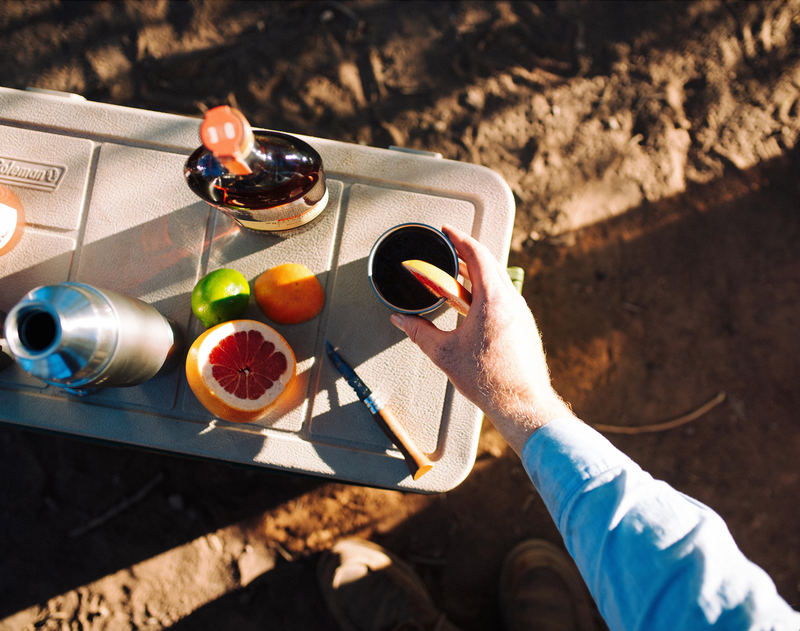
SUMMER COCKTAIL ROUNDUP!
One of the best parts about summer? Enjoying a cold and refreshing cocktail! Here are a few of of our favorites using a variety of our Finished and Infused whiskeys. The Brazos Sour
Ingredients:1.5oz Bourbon & Spire
.25oz Mezcal
.75 lime juice
.5oz grapefruit juice
.5oz vanilla syrup
Garnish: dried lime wheel
Directions: Shake all ingredients with ice. Strain over fresh ice in a rocks glass. Garnish with the lime wheel.
Poteet Lassi
Ingredients:1.5oz Bourbon & Spire
.75oz lemon juice
.75oz honey syrup
1 Tbsp vanilla yogurt
2 strawberries
5 drops of Bittermens 'Elemakule Tiki bitters
Garnish: strawberry, orange blossom water
Directions: Muddle 2 strawberries w/ honey syrup. Add all other ingredients and shake firmly with ice. Double strain into a rocks glass. Add fresh ice and garnish with the strawberry. Finish with a spritz of blossom water.
Endless Summer
Ingredients:1.5oz Wheat & Honey
.75oz apricot liqueur
.75oz lemon Juice
.5oz orgeat
3 drops Elemakule tiki bitters
1 Egg white
Garnish: Elemakule bitters and orange blossom water
Directions: Reverse dry shake all ingredients and double strain into a coupe. Spritz with blossom water, finish with bitters drop design on the foamy top layer.
Disco Cowboy
Ingredients:1.5oz Wheat & Spire
.75oz Aperol
.75oz Blanc Vermouth
3 dashes peach bitters
Garnish: lemon twist
Directions: Stir all ingredients in a mixing glass with ice. Strain into a rocks glass with a large ice cube and garnish with the expressed lemon twist.
Get to shaking and be sure to share your creation with us! Find us on Instagram and TikTok.
READ THE STORY
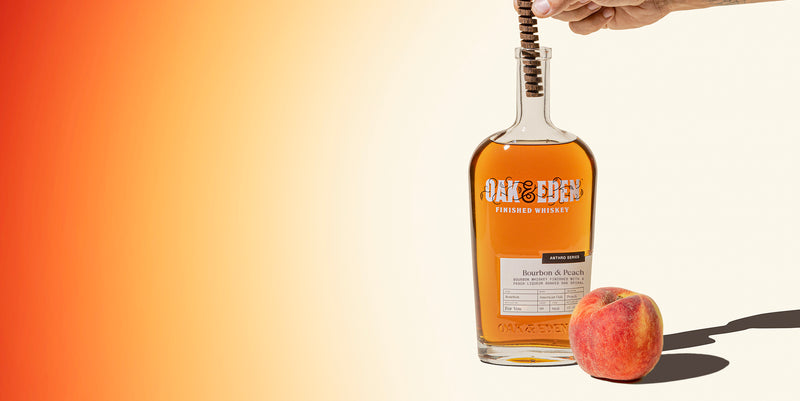
WHISKEY CUSTOMIZER: THE PEACH INFUSION EDITION
Oak & Eden's Whiskey Customizer is a stand out in the innovative world of whiskey. We’ve changed the game, mixed things up, and are proud to share this experience with all who are curious. Whiskey Customizer invites you to curate a whiskey that perfectly aligns with your taste preferences. This experience gives you the opportunity to embark on a personalized journey of whiskey exploration, enabling you to craft your very own custom bottle of whiskey. We released whiskey customizer with four different whiskey bases, two different wood species, and eleven different infusion offerings.You guys asked for more. And we answered. Enter our new peach infusion offering. The perfect flavor for this summertime season. Imagine the velvety sweetness of juicy, ripe peaches merging harmoniously with the smooth burst of liquid gold.Creating your own bottle of whiskey with a peach liqueur finish is a simple yet exciting process. Begin by selecting your base whiskey. Make it barrel strength or keep it 90 proof. Next, choose the wood type — American Oak or French Oak. Then, objectively the best part, is choosing your finishing libation. In this case, we recommend our newest peach liqueur. It introduces a luscious and fruity dimension to your whiskey, elevating the drinking experience with every sip.We invite you to experience the process of building your very own custom bottle of whiskey, pour it neat or mix up a cocktail, savor the rich flavors, and raise your glass to a peachy keen moment! Cheers, y’all!
READ THE STORY
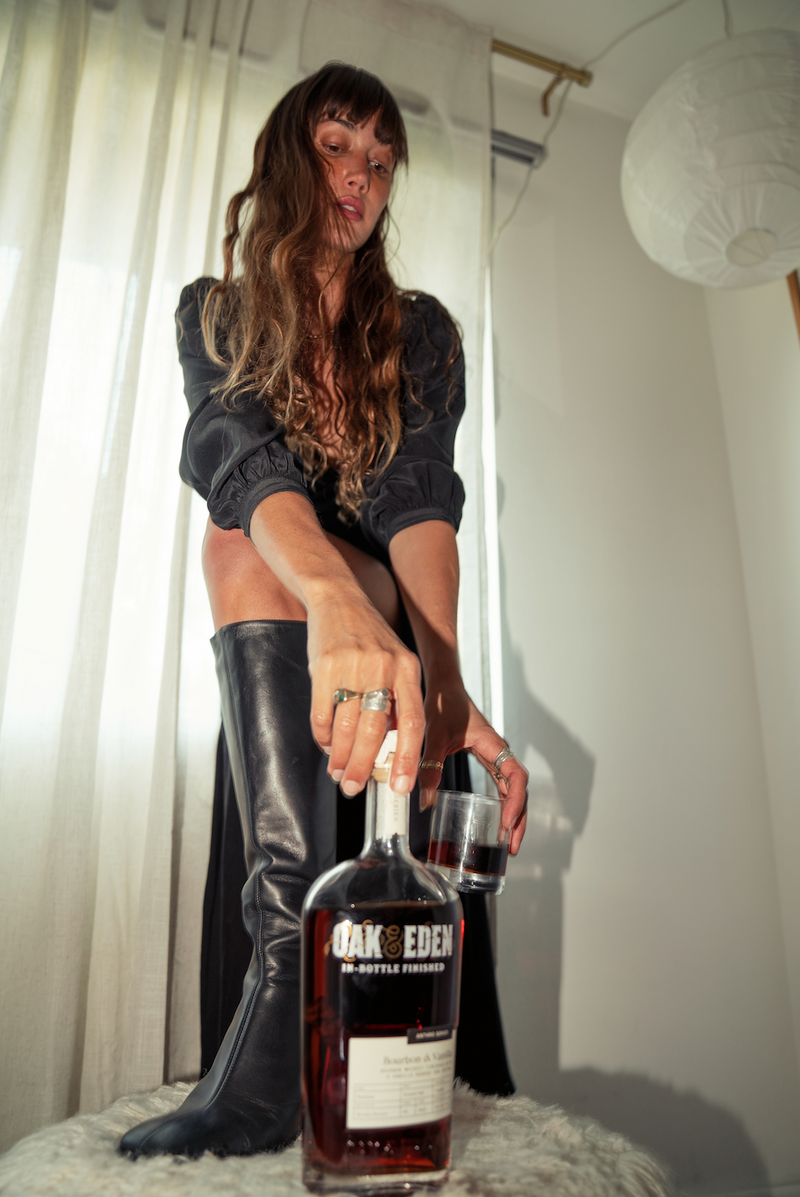
POV: YOU CREATED YOUR VERY OWN BOTTLE OF WHISKEY & NOW IT'S TIME TO ENJOY
Customizing your bottle is just the beginning!
READ THE STORY
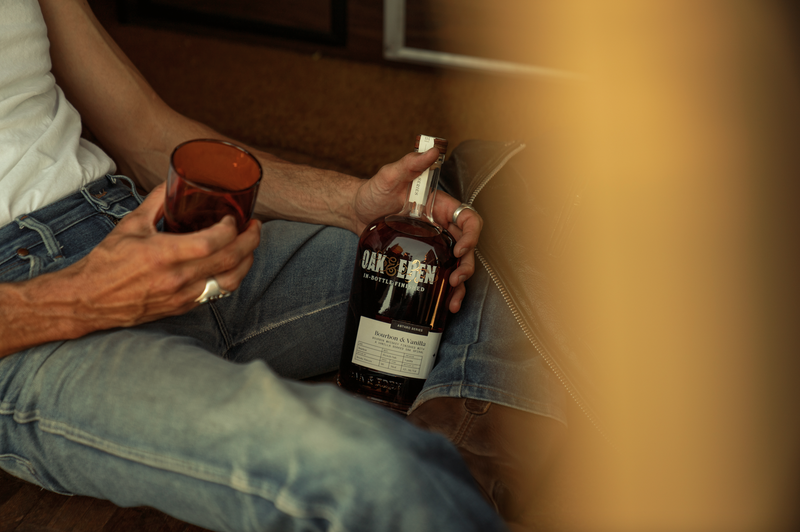
5 WAYS TO CELEBRATE INTERNATIONAL WHISKEY DAY!
International Whiskey Day calls for extra celebration around here!
READ THE STORY
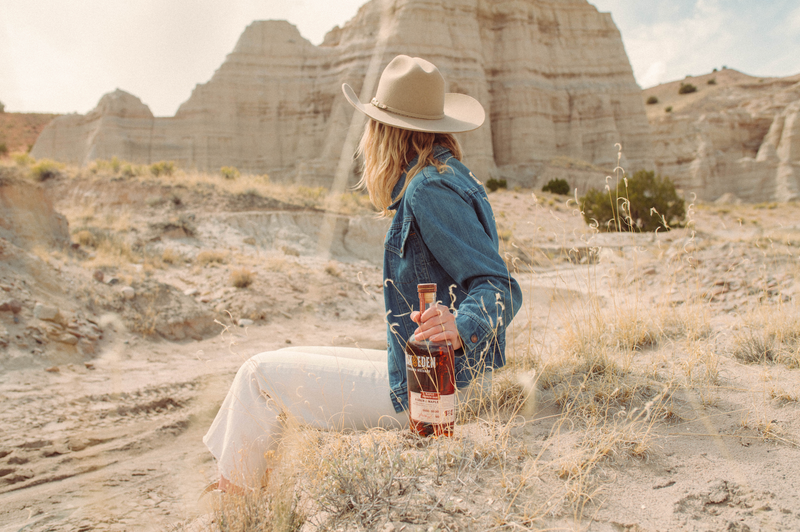
NEW: 4 GRAIN & MAPLE
Introducing 4 Grain & Maple, a four grain bourbon finished with a maple syrup infused American Oak spire.
READ THE STORY
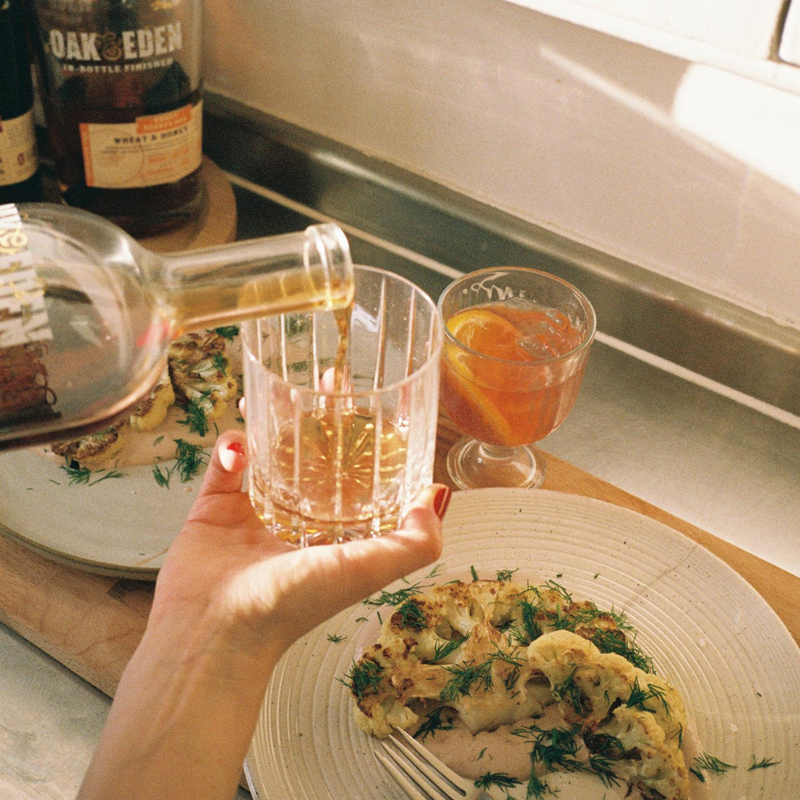
ORDER OAK & EDEN IN 60 MINUTES OR LESS ON DRIZLY!
ORDER OAK & EDEN ON DRIZLY!
Getting whiskey delivered to your doorstep has never been easier. You can order Oak & Eden in 60 minutes or less via Drizly as long as your desired product is available in your area. Simply head to this LINK to shop our collection of products.
This is a super easy and convenient solution for last-minute gifting or hosting needs, or if you just don’t have the time to run to your local retailer. Another great perk when ordering on Drizly is that you can also purchase cocktail ingredients, garnishes, and more, making it a one-stop shop.
STEPS:
Enter your zip code/address and see what products are available near you
Choose your desired product(s)
Go through the checkout process
Be ready for your delivery, you will have to present an ID and sign for the delivery
Enjoy!
READ THE STORY
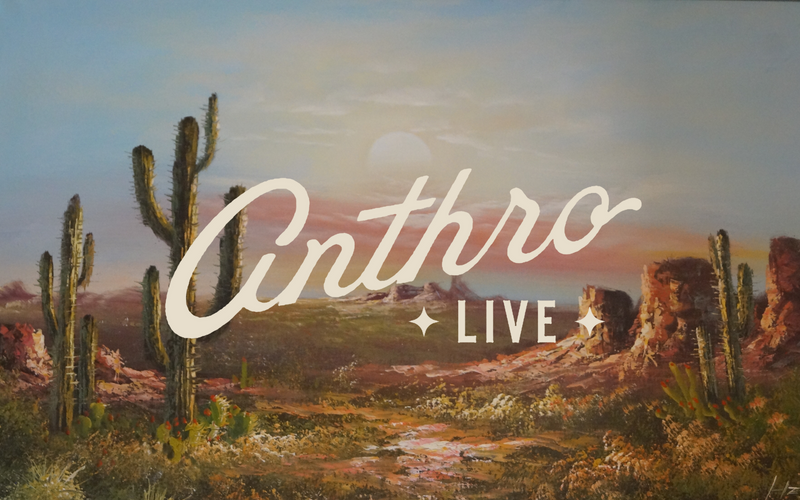
ANTHRO LIVE AT OAK & EDEN FLAGSHIP
YOU'RE INVITED!
Oak & Eden is hosting its 2nd annual roundup of Anthro Live – a meet & greet of some of the Oak & Eden brand ambassadors at Oak & Eden Flagship, coupled with an evening of live music, food and bottle signings. Bottle signings by: Forrie J. Smith - Yellowstone TV & stay tuned for the final lineup!
DETAILS:
WHEN: Saturday, December 3rd from 5 pm - 10 pm
WHERE: Oak & Eden Flagship - Oak & Eden Flagship, 1023 Halsell St, Bridgeport, TX 76426
RSVP HERE!
READ THE STORY
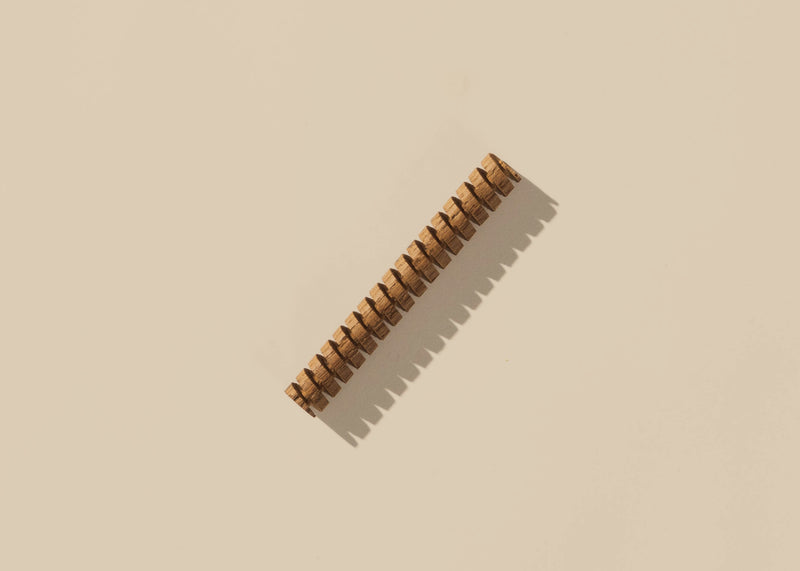
WHAT IS A SPIRE & HOW DOES IT IMPACT IN-BOTTLE FINISHING?
Introducing the lifeblood of Oak & Eden. The Spire is the tool that allows all brand innovation to exist, and it's where our story begins. In-bottle finishing is the genesis of everything we do.
What is a Spire?
The spire is a 5" long spiral cut piece of oak, made from the same species of oak as a barrel. There is a spire inside of every single Oak & Eden bottle. It's what we are proud to call in-bottle finishing™. This process allows our whiskey to "finish" or flavor naturally, producing rich, sweet flavors that could only come from the power of wood.
What is In-Bottle Finishing™?
In-bottle finishing is the process of adding flavor to whiskey after its been aged. At Oak & Eden we add flavor by adding a spiral cut piece of oak to our whiskey after aging.
How Does it Create Impact?
It allows us to further innovate and explore. The Spire and In-Bottle Finishing has enabled us to offer what we call infusions - from Cabernet to Honey to Caribbean Rum. We've crafted an entire collection of products that have rich, added flavors that create a remarkable finish and inspire creativity when it comes to how it can be enjoyed. Aside from our Infused Whiskeys, we believe there is nothing quite comparable to the impact that the wood has on our finished whiskey.
Experience In-Bottle Finishing for yourself. Shop our entire product collection or find us at a retailer near you by using our store locator. Already have your hands on our whiskey? Explore our arsenal of cocktails + more in the journal.
READ THE STORY
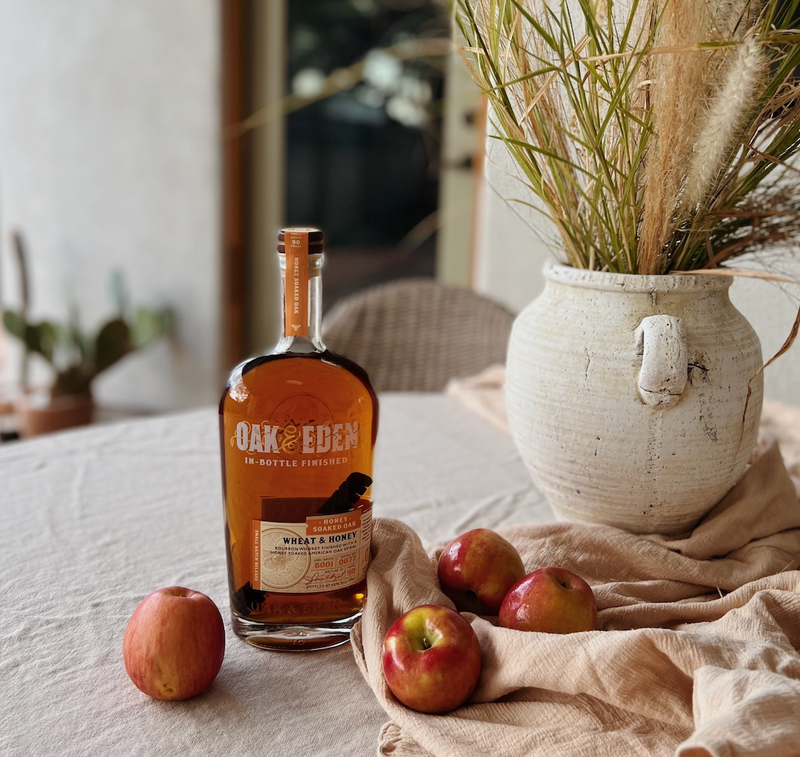
THE SWEATER WEATHER RANCH WATER
The official cocktail of sweater weather - The Gold Coast. Oak & Eden fans are calling it the “sweater weather ranch water.” It's time to put down the Topo + Tequila and pick up Whiskey + Cider!
READ THE STORY
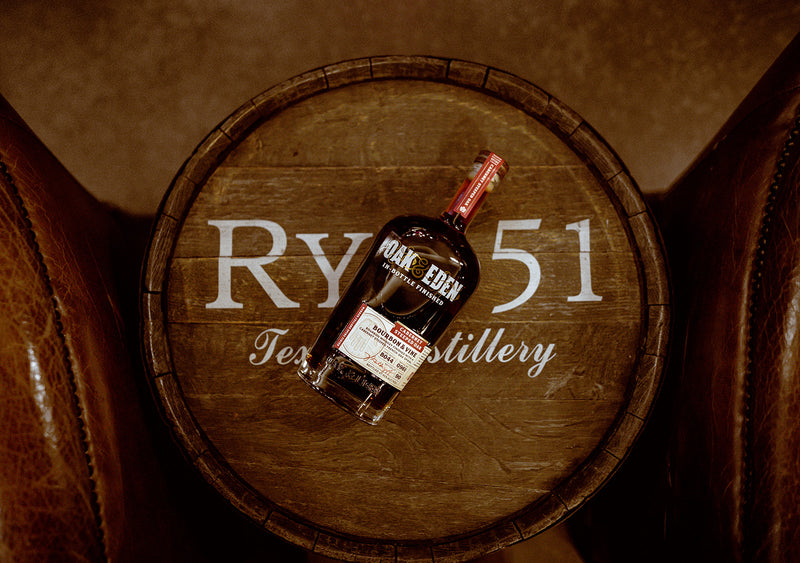
OAK & EDEN X RYE 51 ROADSHOW
Oak & Eden and Rye 51 are hosting a roadshow in the months of October and November! Oak & Eden's award-winning cabernet infused bourbon, Bourbon & Vine, is back for the season and Rye 51's fall collection is the perfect pairing.
Oak & Eden will be making an appearance at all nine Rye 51 locations over the next few weeks. We'll be kicking things off close to home, at Rye 51's Fort Worth location, but below you'll find the details for each event + location. Be sure to click on the RSVP link to let us know you're coming!
Receive complimentary neat pours, craft cocktails, and a chance to win your very own limited edition co-collaborative bottle of whiskey - Rye & Vine.
Forth Worth
Friday + Saturday, October 14-15
3p-6p
RSVP link here
Dallas
Friday + Saturday, October 21-22
3p-6p
RSVP link here
Houston
Friday + Saturday, October 21-22
3p-6p
RSVP link here
Oklahoma City
Friday + Saturday, October 28-29
3p-6p
RSVP link here
Tulsa
Friday + Saturday, October 28-29
3p-6p
RSVP link here
Little Rock
Friday + Saturday, November 4-5
3p-6p
RSVP link here
Nashville
Friday + Saturday, November 11-12
3p-6p
RSVP link here
New Orleans
Friday + Saturday, November 18-19
3p-6p
RSVP link here
Atlanta
Friday + Saturday, November 18-19
3p-6p
RSVP link here
We'll see you there!
Bourbon & Vine is available to shop now, find it here. You can also learn more about Rye 51 here.
READ THE STORY
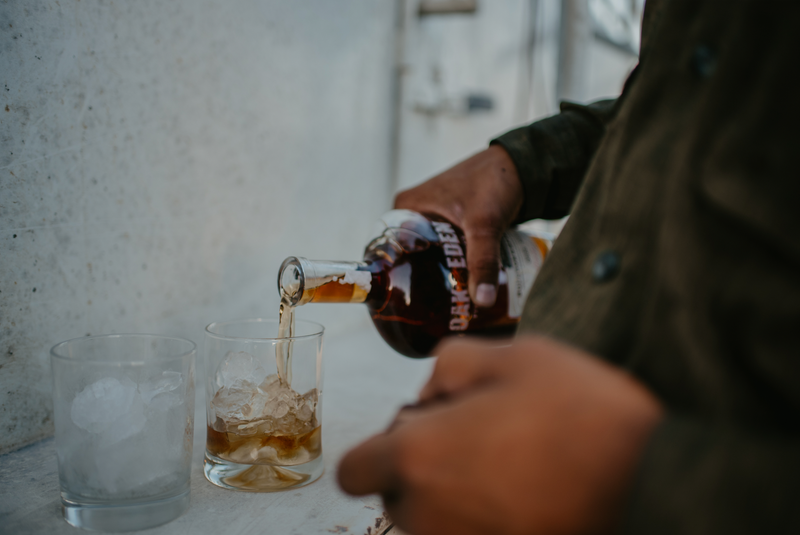
HOW TO: SHOPPING AT YOUR LOCAL RETAILER
You walk into your local liquor store and the number of choices tends to be overwhelming, especially if you are on the hunt for something new! We’ve been there too. It can make what should be an enjoyable experience, a tad bit stressful, but it doesn’t have to be. Here are a few ways we try to lessen the overwhelm.
Do a little bit of digging before you head out!
We live in a world where we truly have all of the information we’d ever need at our fingertips. If you know what type of alcohol you are going in for, give google a search to see what recommendations pop up, head to Instagram or your favorite social platform, and do that same. Which brands populate and which seems the most interesting to you? Brands live on social platforms to inspire, educate and excite - so ultimately you will find out a lot about various spirits brands just by glancing at their profile.
Determine what you are buying for.
You most likely already have this question answered, but thinking about it more intently will help you in the next step (hint: making a list). This essentially just helps you better prepare for the quantity you need, whether or not you need specific ingredients for a certain recipe (this is also a great thing to search on social), or if you are just running low on your essentials and need a restock.
Make a list!
If you’re anything like me, you will 100% forget to grab something if it isn’t on your list. Just like any normal grocery run, this will keep you on track and will allow more time for you to browse and look at products that you are interested in, without potentially overbuying.
While you are working through this list, it is also a good idea to keep in mind the price range you want to stay within for each type of product and determine the overall value of the product based on how much use you will get out of it at any given time.
Get in-store!
Once you’re in the store, you should be pretty well equipped to get all of your necessary items, but as we mentioned before, it's also a great time to explore. One thing we love looking for is products that have hang tags that include a QR code or website that you can reference. This really helps us better understand the product since many times there is not much further context included on the bottle itself.
Oak & Eden proudly lives on the whiskey aisle, but if you’ve ever been into a liquor store, you’ll find that there are countless options, and many times they may not be organized or displayed in any particular way. One thing you can identify us by is looking for the wooden spire inside each of our bottles. This is something you won’t find in any other whiskey or liquor on the shelf, making it super easy to identify our products.
If you’re still struggling to decide or just need additional assistance, don’t hesitate to ask the store clerk/assistant. They are there to share their knowledge with you and to help you in any way that they can!
Share your experience with others
Since you’ve experienced firsthand what it is like to head to store, it's a great time to share that with others, whether by word of mouth or on social media! Whether you believe it or not, word of mouth and recommendations from friends and family is still one of the largest drivers of liquor sales. There is nothing quite equivalent to hearing from someone you trust, and in return, you are helping further support your favorite brands!
Make sure to head to our store locator if you’d like to see where you can find Oak & Eden near you!
READ THE STORY
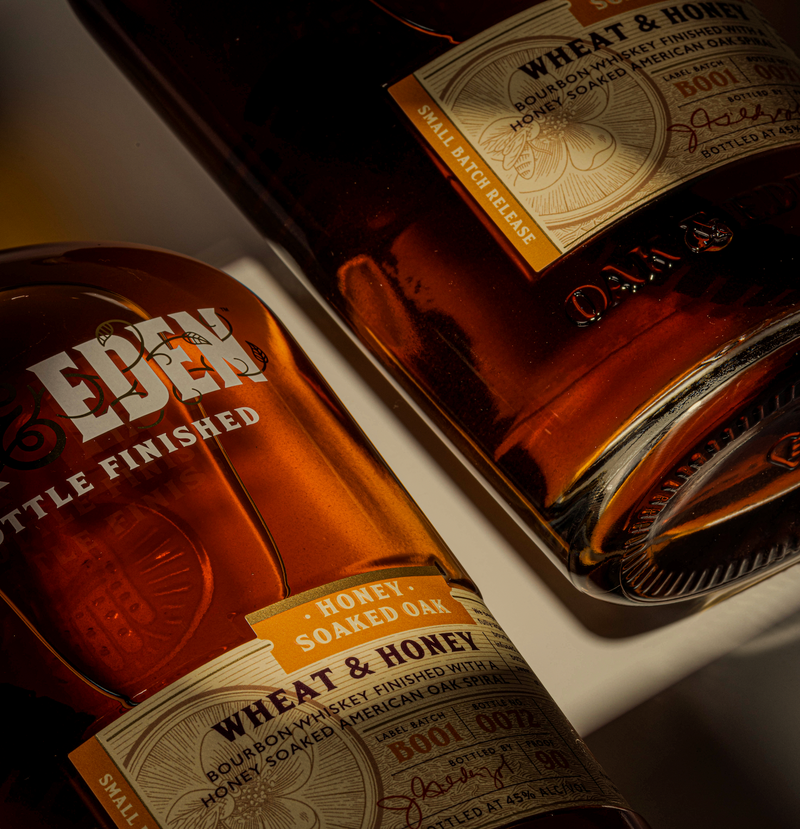
INFUSED SERIES: THE PERFECT BAR CART STOCKING OPTIONS
We are approaching the end of the year, which doubles as a time that's focused heavily on holiday festivities and celebrations with family, friends, and most importantly — good food and drinks. Whether you're hosting a party or just relaxing at home, having the perfect bar cart stocked with your favorite spirits is key. In this post, we'll show you how to stock your bar cart with the necessities and unique additions that'll ensure there is an option for every guest and their beverage preferences.
Plus, surprise — we've added a new addition to the Infused Series, Wheat & Honey! So whether you're giving thanks over a large tabled feast, toasting to the new year, or just enjoying a quiet fireside weekend at home, make sure your bar cart is ready to roll!
The Infused Series is made for entertaining; we've put a twist on the classics, making an already good spirit, better.
Bourbon & Vine: This Bourbon is finished with a Cabernet infused French Oak spire. This is for your guests who typically reach for a glass of wine or a sweeter, yet punchy cocktail. Display a bowl of lemons next to this bottle and you'll be on your way to serving up a true crowd pleaser - Mr. Evans.
Bourbon & Brew: Again, we've taken our classic fully aged Bourbon, but finished this bottle with an American Oak spire that's been soaked in cold brew coffee. This is the bottle for your guests who keep the coffee pot brewing all day and prefer their cocktails on the rich and creamy side. A cool bottle & brand to place next to Bourbon & Brew on your bar cart is Mr Black's coffee liqueur. With these two ingredients, a night cap is a no brainer. Try a West of Eden and rest your head knowing that the night was a hit.
Rye & Rumba: Because Rye not? This Rye whiskey is finished with a Caribbean Rum infused American Oak spire. For this bottle, batched cocktails are the move — the more, the merrier! Try the Coastline and pour from the beautiful pitcher that you conveniently have sitting pretty in the corner of your curated bar cart.
Wheat & Honey: New to the Infused Series family, this Wheated Bourbon is finished with a sticky American Oak spire that's been soaked in honey. This bottle is perfect for your guests who prefer something on the lighter, more refreshing side. You'll want to make sure that you have an ice mold on hand because this bottle finishes smooth, easily served neat. Also, it's a good excuse to invest in that glassware you've had your eye on.
The Infused Series is an excuse to celebrate in itself! We've taken the guesswork out of what to serve your guests, now it's up to you to build that bar cart.
Cheers!
READ THE STORY
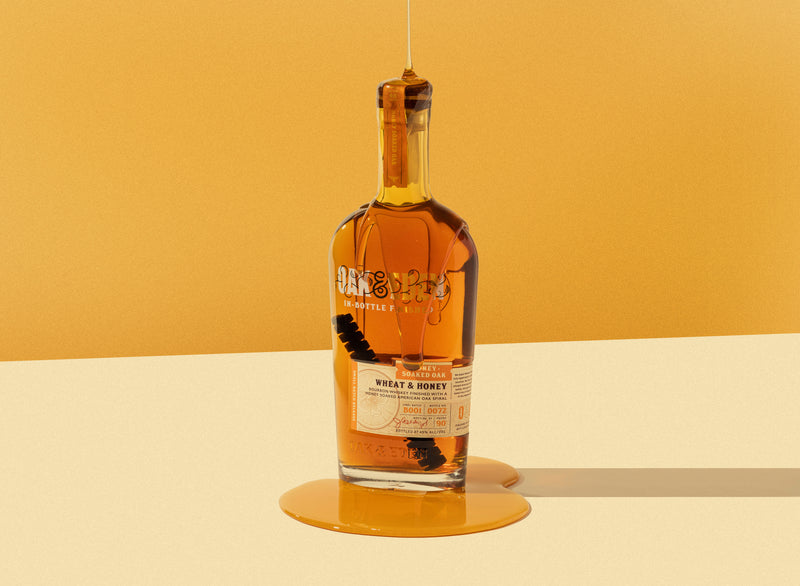
OAK & EDEN'S NEWEST LAUNCH: WHEAT & HONEY
Constantly discovering unique opportunities, taking the time to create new and fresh products, and delivering them to our incredible customers are what we are passionate about. That is why we are thrilled to be launching the fourth member of our small batch infused series lineup, Wheat & Honey. The launch of Wheat & Honey is another stepping stone in our pursuit to bring consumers a fully individualized experience, one that can only be achieved through our patented in-bottle finishing process.
This new release launches exclusively on oakandeden.com on September 29th. We can’t wait for you to give it a try. In the meantime, we want to share more about what makes Wheat & Honey special.
What is Wheat & Honey?
Wheat & Honey is the fourth release inside the Oak & Eden Infused product line. Wheat & Honey, a small batch release begins with a wheated bourbon whiskey, made of 51% corn, 45% wheat, and 4% malted barley, is finished in the bottle with an American Oak spiral that had rested in honey before being infused into the whiskey.
What makes up Wheat & Honey?
Whiskey: Wheat & Honey begins with a remarkably smooth combination of 51% corn, 45% wheat, and 4% malted barley. Once distilled, we age our bourbon in new American Oak barrels producing a rich, deep yet sweet spirit.
Wood: Containing hundreds of naturally occurring botanicals, ranging from butterscotch to vanilla to toasted marshmallows, we use an American Oak spire in Wheat & Honey, which produces a rich, velvety whiskey full of caramel, butterscotch, and allspice notes.
Fire: Before we place the spire into the wheated bourbon, we expose it to fire, technically a Medium Toast, toasting the wood to the perfect degree that will produce a finish that is deep and rich with subtle notes of candied fruit, vanilla, toffee, and caramel.
Infusion: Honey is the obvious first flavor that most people discern when drinking whiskey, making this infusion an obvious choice to take a good thing and make it better. We infuse each spire with American Honey before placing it in the bottle for that naturally sweet finish.
Proof: 90 proof/45% ABV
Why did we choose American Oak?
American Oak has a massive array of naturally occurring botanicals, from butterscotch to vanilla, and caramel to coconut, but the most prominent is honey. Additionally, Wheated Bourbon is commonly recognized for its creamy texture and sweet flavors. We wanted to accentuate the prominence of the sweet honey notes in our award-winning wheated bourbon by infusing honey in the American Oak Spire, giving it the full release of the flavor it deserves.
What are the tasting notes?
While everyone’s taste buds have different interpretations when it comes to whiskey tasting notes, we’ve found that Wheat & Honey has notes of Honey, Marshmallow, and Candied Fruit.
What kinds of cocktails can you make with Wheat & Honey?
The possibilities are endless, especially due to how versatile this whiskey is, and given that honey pairs well with an array of other ingredients, foods, desserts, and more! It is a great whiskey to have on hand at all times of the year, especially as we approach the holiday season, where hosting and gathering with friends and family are in full swing. Here are a few of the signature Oak & Eden cocktails, created by our in-house mixologist, Grace! Head to our recipes page for even more inspiration.
Cloud 9
1.5oz Wheat & Honey .5oz Drambuie 1oz chamomile cream.75oz strawberry syrup.75oz lemon juice1 egg white Angostura bittersAdd all ingredients except bitters into a shaker tin with ice and shake until chilled. Strain cocktail into back into tin, discarding ice, and dry shake for 15 seconds. Double strain into a chilled coupe. Put 4-5 drops of angostura bitters on top of the foam and drag a line through each to create your favorite design.
AMERICAN HONEY
2oz Wheat & Honey
1oz orange juice
.25oz lime juice
.25oz honey
2 dashes Angostura bitters
1 egg white
Garnish: Cinnamon
Glass: Coupe
How to make: Add all ingredients into a shaker tin with ice and shake until the tins begin to frost. Strain into the small tin and discard ice, then shake again without ice. (Reverse dry shake) Double strain into a coupe glass. Garnish with freshly grated cinnamon or a light dusting of ground cinnamon.
THE GOLD COAST
1.5oz Wheat & Honey
Sparkling apple cider (Martinelli's is our favorite)
Garnish: Apple fan or dehydrated apple chip
Glass: Collins
How to make: Pour Wheat & Honey into a collins glass and fill the glass with ice. Top with Martinelli's apple juice and apple garnish.
SOLAR FLARE:
2 oz Wheat & Honey
.75 oz Spiced Maple Syrup
2 Dashes of bitters
.75 oz lime juice
1 oz orange juice
How to make: Add all ingredients into a cocktail shaker with ice and shake until chilled. Strain into a rocks glass and fill with ice. Garnish with dried chile pepper. Enjoy!
Wheat & Honey is now available for you to shop + get shipped directly to your door. We hope you give it, plus our signature cocktails a try!
READ THE STORY
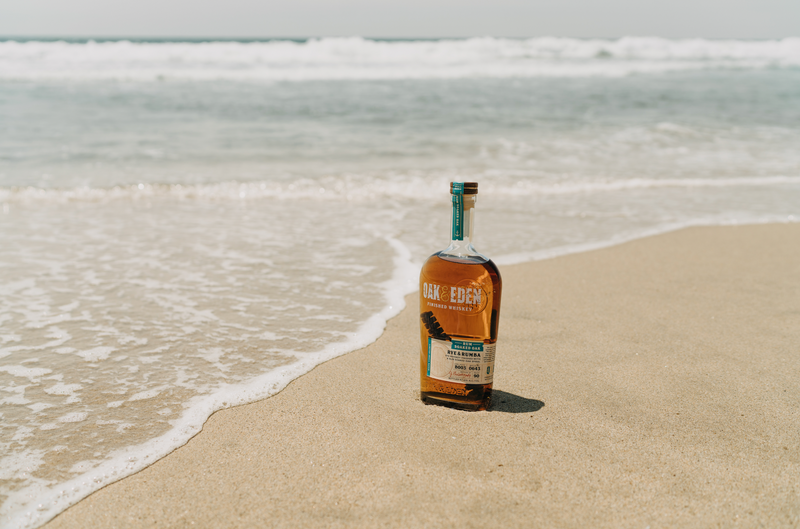
WHAT IS RYE WHISKEY? | OAK & EDEN
What Is Rye Whiskey?
When you think of just the single word "whiskey," what is the first thing that comes to mind? If you are like most people, it’s a delicious amber-colored beverage.
However, if you think about the wide variety of whiskey out there, a lot is left out in this simple definition. Different kinds of whiskey can be worlds apart depending on the ingredients, aging, distillation process, and other factors.
Once commonly misunderstood and underappreciated, rye whiskey is an American style of whiskey that’s less well known than bourbon. Rye whiskey is delicious, unique, and deserves a place in the whiskey world.
Here is an overview of rye whiskey, plus some fun background information on one of the most flavorful types of whiskey around!
What Makes Rye Whiskey Special?
Many things make rye whiskey special, but the most important thing that separates rye whiskey from every other type of whiskey is a high-rye mash bill.
Rye is a cereal grain that is particularly well adapted to growing in cooler climates.
Rye whiskey in the United States must contain at least 51% rye, although many distillers use far more rye in the mash bill. Consider how, with wines, the flavor changes when you change the grapes. The same goes for the cereal grains used in whiskey.
What Is Rye?
As mentioned, rye is a cereal grain commonly grown in northern climates. Rye has been cultivated for thousands of years, dating at least back to early Turkey in the 1800s BCE. Today, the grain is particularly popular in Russia, Germany, Canada, and parts of the United States.
You may be most familiar with rye bread, which you can find at any New York-style deli worth its salt. Rye is a more flavorful and intense grain, giving baked goods an earthy, herbal flavor that is much more earthy than white or wheat bread. This is why rye bread is often paired with very flavorful condiments like mustard — to play against the spicy earthiness of the bread.
What Does Rye Do to a Whiskey?
We know what rye tastes like when you use the grain to make bread, but if you've ever had a piece of toast and a glass of whiskey, you know they aren't all that similar.
In a whiskey, rye strongly impacts the flavor profile. Rye whiskey inherits the more intense flavors and aromatic aspects of the rye grain. This gives rye whiskey a spicy flavor — almost in the way that cinnamon is spicy, rather than the way that hot peppers are spicy.
Depending on the distiller who makes your rye whiskey, your bottle will taste drastically different. This is because a whiskey only needs to be made of 51% rye in the mash bill in order to be considered a rye whiskey.
Certain distilleries create rye whiskey has that minimum threshold, and the rest of the grains are some combination of corn, wheat, barley, or other cereal grains. Other distillers' rye whiskey is made with 100% rye (sometimes known as Monongahela style), giving you nothing but rye flavor head-on.
What Is the History of Rye Whiskey?
While bourbon may be the most popular of the American whiskies, rye whiskey is arguably the more patriotic distilled spirit.
Rye whiskey was first distilled in the United States by farmers in Pennsylvania in 1750, while bourbon wouldn't be distilled until 1783 in Kentucky. Rye continued to grow in popularity across middle America and in places like Maryland. Rye was the favorite whiskey of George Washington, and it’s the drink he made at his distillery on the banks of Dogue Creek in Virginia.
During Prohibition, both bourbon distillers in the midwest and rye distillers in the Atlantic were hit hard. However, when American soldiers returned from World War II with a taste for Scotch (which, logically, comes from Scotland) and Irish whiskey, rye never had the same bounce-back that bourbon did.
Today, you will mostly find rye whiskeys made by bourbon distillers as one of their offerings. You’ll also find that it's frequently produced in the state of Indiana. While rye may no longer have the same popularity it once was, it is still a delicious whiskey that deserves more attention and respect.
How Is Rye Whiskey Made?
Rye whiskey is made much like other American whiskies but with a few unique requirements that make it special. Here is a closer look at a few of the steps in the process.
Step One: Selecting and Mashing the Grains
The first step of making rye whiskey starts with selecting the grains for a mash bill — the recipe for the mix of grains used by each specific distiller. Depending on the distiller, the rye mash bill will have anywhere between 51 and 100 percent rye. The other 49 percent could be made up of any combination of corn, wheat, malted barley, and other cereal grains as the distiller sees fit.
Then, the grains are ground finely and mixed with water to create a porridge-like substance. This helps release the sugars in the grains so the yeast can metabolize them during fermentation.
Step Two: Fermentation
Now that the grain has been mashed, it is ready for fermentation — the part of the process that creates the alcohol. The mash is placed into a large container, and yeast is added to the mixture. The yeast eats the sugars present in the grain and, as a byproduct, creates alcohol.
The mixture will be left to ferment for anywhere from two to five days, at which point the fermentation process is complete. The liquid will have reached about 12% ABV — about that of a typical wine. This liquid is often called the distillers' beer.
Step Three: Distillation
Then, rye whiskey can finally be distilled using one of two methods: the less common column still distillation or the more common pot still distillation. Here we will take a quick look at pot still distillation and the process that makes the delicious, high ABV whiskey that we know and love.
Distillers’ beer is poured into a large copper or metal pot, which is then heated from below. Alcohol has a lower boiling point than water and the other components of the distillers’ beer, meaning that much of the vapor that burns off at a low temperature is alcohol. This vapor rises through a chamber. It is then collected in a condensing chamber, which cools the gas back to a liquid with a higher alcohol concentration than before.
What is leftover is discarded, and the remaining purified liquid repeats the process until it gets to the proper alcohol content, often as high as 160 proof, or 80% alcohol.
Step Four: Aging
This step is where the real magic happens when making rye whiskey (or any type of whiskey). The distilled whiskey is poured into new, charred American oak barrels, which are liquid-tight but not airtight. This means that the oak can expand and contract with the changing temperatures, which changes the porousness of the wood.
This pulls the whiskey in and pushes it out of the wood cask, and along with it, the whiskey takes the botanicals and natural color and flavor elements present in the charred wood. This is responsible for most of the flavor and color in a whiskey — when it enters the barrel, it is usually clear.
The whiskey is aged for a minimum of two years and typically four or more years before it can be bottled. Straight rye whiskey will be aged for at least two years and won’t contain any other spirits, but there are other options out there as well, like “bottled-in-bond.”
Step Five: Bottling
The final step of the process is bottling the whiskey. Most rye whiskeys will be a blend of many barrels in one single bottle, which helps to deliver a consistent taste and flavor across bottles and batches.
Single barrel offerings are composed of a rye whiskey from a single barrel — which means it will have all the unique characteristics of that particular barrel.
The Bonus Step: In-Bottle Finishing
Here at Oak & Eden, we take our rye whiskey (and all of our whiskies) through one more step: in-bottle finishing. Each bottle of our whiskey is bottled with a spire, a spiral-cut piece of wood that is carefully chosen and toasted or charred for each whiskey we make. These spires help deliver additional flavor notes while your whiskey rests in the bottle.
How To Enjoy Rye Whiskey
When people (and even bartenders) who aren't used to drinking rye whiskey first start to incorporate it into their repertoire, they often aren't sure if they can use it just like they would a bourbon whiskey.
Luckily, rye is a very versatile drink, and so long as you enjoy the flavor and know the best ways to tame the rougher edges of rye, you can make tons of delicious drinks:
Whiskey Sour or Whiskey Smash
Whiskey sours and whiskey smashes are both lemony whiskey cocktails. That additional acid from the lemon and sugar in the cocktail helps mellow out the rough edges for a smooth cocktail.
Manhattan
The Manhattan cocktail is a classic, and for good reason. American rye whiskey is always at home in this adaptable Prohibition-era cocktail, which is completed by a touch of bitters.
Toronto
Canadian whisky is its own particular type of rye, so we couldn't leave out Toronto. The drink combines Canadian rye whisky with Angostura bitters, Fernet-Branca, and simple syrup for a delicious Manhattan/Old Fashioned crossover.
Once you’ve mastered the classics above (and other options like the Sazerac), you can experiment with using rye in new, interesting ways. Perhaps you want to make a take on the mint julep using rye, or maybe you’ll swap rye into a Tennessee mule for a unique take on a classic.
What Is Rye Whiskey: Takeaways
Rye whiskey is a delicious option that every whiskey lover should at least try once. You may just find you enjoy the spicy sweetness of a rye whiskey just as much as the mellow caramel of bourbon.
Rye whiskey must contain a minimum of 51% rye if it is made in the United States, although it can be as much as 100% rye. The whiskey must also be aged in new charred oak barrels for a minimum of two years and cannot be distilled to more than 80% ABV or 160 proof.
If you are looking for a delicious rye whiskey to try, we have a few options at Oak & Eden. Our Inspired Series is our classic take on rye whiskey, with an emphasis on pure rye flavor — our mash bill is 95% rye. If you want a more adventurous concoction, our Infused Series takes our classic rye and swaps out our spire for a rum-soaked spire, giving you a rum-infused rye. Lastly, if you want something on the wild side — our Anthro Series is our barrel-proof rye with a French Oak spire.
Whatever you like to drink, give it a try with rye.
Sources:
10 Things You Didn't Know About Rye, The World's Most Underrated Grain | Food Republic
Rye: America's almost-forgotten whiskey | TBR News Media
Distillation Glossary: Pot Still Terms You Should Know | Serious Eats
READ THE STORY
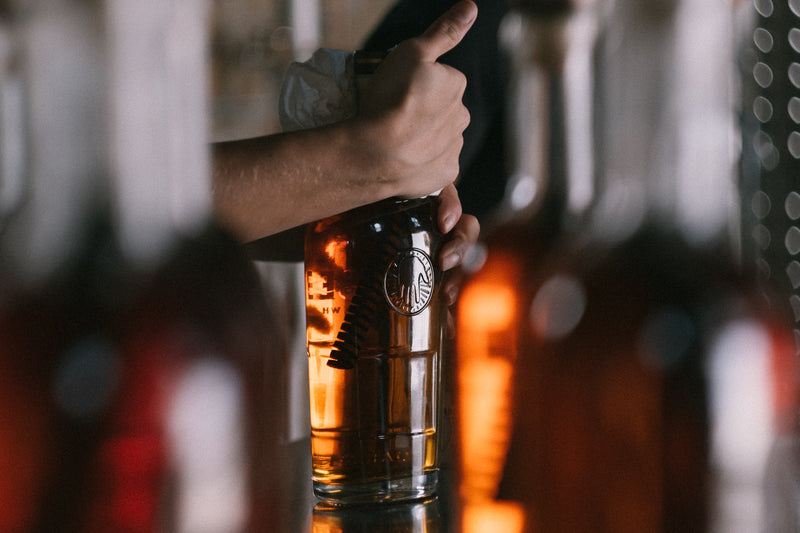
HOW LONG IS BOURBON AGED? | OAK & EDEN
How Long Is Bourbon Aged?
Bourbon is a drink that we all know and love. For us, it’s our favorite spirit. Bourbon is the official distilled spirit of America, and as such can be found on the shelves of nearly every bar stateside.
Bourbon is aged alcohol, meaning it must be aged in order to legally be considered a bourbon. In fact, aging is one of the most important aspects of making bourbon and whiskey in general.
But how long is whiskey aged for? There are some scotch and Irish whiskies that are aged for decades, but what is the standard here in America?
Here’s a full breakdown of the aging process of bourbon so that you know the truth about how long bourbon is aged.
What Is Bourbon?
Bourbon whiskey is a type of American whiskey that is made predominantly from corn. It’s the first corn-based whiskey that the world became familiar with. Bourbon whiskey gets its name from Bourbon County in Kentucky, where it was first produced. Despite its popularity, Bourbon has only been labeled as such since 1840, meaning bourbon is less than 200 years old.
Bourbon is made of fermented grains, a majority of which has to be corn and the rest of which can be any combination of cereal grain, often including wheat, rye, and barley. Bourbon is also an aged liquor, just like all whiskey.
Whiskey gets its color from the aging process, and a majority of its flavors are developed during aging as well. This makes the aging process perhaps the single most important part of the bourbon-making process.
The result of this long-term aging is a smooth, amber-colored spirit with a distinctively sweet flavor. Today, bourbon is enjoyed all over the world, and it is one of the most popular types of whiskey. Whether you enjoy it neat, on the rocks, or in a cocktail, there’s no doubt that bourbon is a truly unique and delicious spirit.
How Long Is Bourbon Aged?
The question at the heart of this is how long bourbon is aged, and the answer is that it depends. But, we can get a bit more specific to give you the ideas of the age range that is common for bourbon makers.
The legal requirement (yes, there are legal requirements for the aging of a bourbon) is that every bourbon must be aged two years before it can be bottled. But, just because that is the legal minimum doesn't mean that all bourbons are only two years old.
In fact, a vast majority of the bourbons that you come across are aged for at least four years, and any bourbon that is aged less than four years must state the age of the whiskey in the bottle. There is no upper limit to whiskey aging — many distillers use a seven-year, while others offer premium or select agings that are as much as several decades old.
What Is the Bourbon Aging Process?
The aging process is the longest part of the bourbon-making process. Here is a deeper dive into the aging process and how aging impacts bourbons.
The Rules of Bourbon Aging
All bourbon has to be aged in new, charred oak barrels. What this means is that the wood has to be new and it can't have been used in a barrel previously. It also means that the inside of the barrel has to be exposed to fire before the barrel can be filled (that’s what the char is). Depending on the distiller and the whiskey the char level can range from a light toasting to a complete blackening of the interior of the barrel.
Bourbon also has to be aged for a minimum of two years, and most will be aged for four years or more. This is because the longer a whiskey is left to age, the more flavors will be imparted to the whiskey — but how?
How Bourbon Aging Works
As we mentioned earlier, the whiskey barrels are liquid-tight, so the whiskey stays in them, but they are not airtight, so they are susceptible to the temperature and humidity changes of the aging chamber. Another important thing to understand is that wood is porous, meaning it can be permeated by liquids.
As the bourbon whiskey rests in the barrel, the whiskey permeates the charred wood on the interior of the barrel. As the barrel expands and contracts with the temperature and humidity changes of the seasons, the wood pulls in and pushes out whiskey accordingly. When the whiskey is pushed out of the wood it brings with it botanicals and other flavor and coloring agents with it, which provide the flavors for the whiskey.
The longer a whiskey ages, the more time it has for this process to repeat over and over again. This makes a difference, but up to a point. Think about it like a bag of tea — the longer you steep the tea the stronger the tea will be. But if you were to leave the tea bag in there for two minutes compared to three minutes it would make a much bigger difference than one hour compared to five hours.
What Is the Angel's Share?
There is one more element of the aging process that is critical to mention: the angel's share. The angel's share is a phenomenon that was first noticed and named by the Christian monks who first distilled whiskey, and always has been a part of whiskey making.
When the whiskey is aged in barrels that are not airtight, this means that liquid can escape if it turns into a gas. Over the aging process, a portion of the whiskey in the barrel is lost by evaporation. The longer the whiskey is aged, the more is lost in the process.
The angel's share does cause one pretty cool side effect: the alcohol vapors are very noticeable in the aging room, giving the room the sweet smell of caramel whiskey. When the monks who first aged whiskey realized this, they called it the angel's share, explaining it as the portion the angels drink.
It’s also a part of the reason why bourbon which is aged longer typically costs more — it requires more raw product to get the same amount of liquid the longer you age the whiskey.
What Is Finished Bourbon?
The final element of bourbon aging that you should know about is finished bourbon — a type of bourbon you have likely come across before. A finished bourbon or finished whiskey is just a bourbon or whiskey that has been aged for the legal requirement of two years in new, charred oak barrels which then goes through one more step.
Instead of going into the bottle, finished bourbon goes into another barrel. This time, this barrel can be any kind of wood that the distiller would like to flavor the whiskey as seen fit. Here at Oak & Eden, we have our own unique spin on the finishing process.
Every bottle of Oak & Eden whiskey contains a wooden spire, a spiral-cut piece of wood that has been selected and toasted or charred to order for each different whiskey that we make. This means that your Oak & Eden whiskey gets a finishing touch while it rests in the bottle on your bar shelf.
The Legal Requirements for Bourbon
Before we finish, here is a quick final overview of the legal requirement for a whiskey to be labeled a bourbon in the United States of America:
Bourbon must be made and aged in the United States, and if it is to be labeled a Kentucky bourbon, then it must be made and aged in Kentucky.
Bourbon must be made with a mash bill of 51% corn or more.
Bourbon cannot be distilled to more than 160 proof.
Bourbon cannot enter the barrel at more than 125 proof.
Bourbon must be aged for a minimum of two years in new, charred oak barrels. If aged less than four years, the age must be printed on the label.
Bourbon may not be bottled below 40% ABV.
How Long Is Bourbon Aged: Takeaways
Bourbon whiskey, and all other whiskeys are aged. That is where they get a majority of their wonderful flavors and all of the beautiful amber color. The aging process is one of the most important and most regulated portions of the whiskey-making process.
Bourbon is aged for a minimum of two years in new, charred oak barrels. If bourbon is aged for less than four years, then it must say the age on the label. The aging process is a complex and long process that uses the temperature and humidity changes of the seasons to create delicious bourbon.
At Oak & Eden, we take things one step further with our spires. These spires are at the heart of our in-bottle finishing technique, which gives a finishing touch to our bourbons and whiskeys while they rest in the bottle.
Check out our bourbons, ryes, and other whiskeys here.
Sources:
What is Kentucky Bourbon Whiskey? | BourbonCountry
How A Distillery Ages Bourbon In Days, Not Years | NPR
What is Bourbon | American Bourbon Association
READ THE STORY
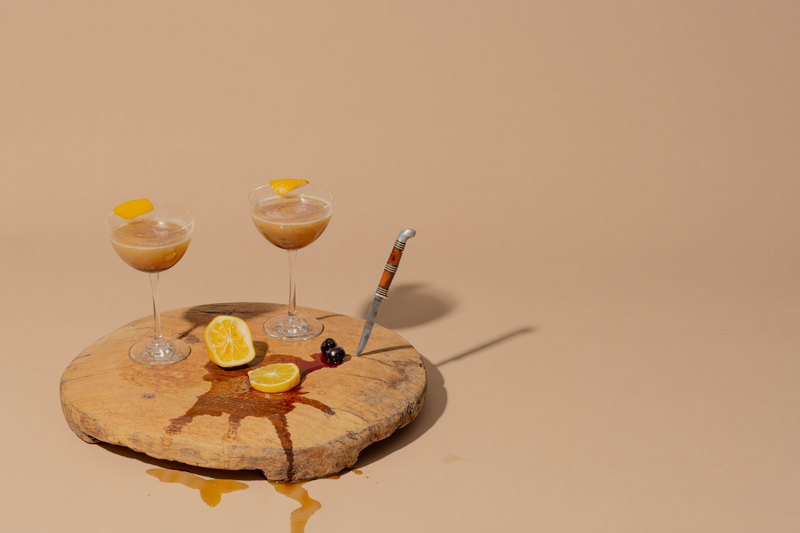
HOW TO ORGANIZE A HOME BAR: THE ULTIMATE GUIDE | OAK & EDEN
How To Organize a Home Bar: The Ultimate Guide
Everyone likes a drink here and there, especially when having guests over for dinner or a game night. Whipping up delicious and inventive cocktails can take any night to a whole new level.
A home bar is a great way to entertain guests, have fun with friends, and make sure everyone always has their favorite drink on hand. But before you can start serving drinks, you must ensure your home bar is properly organized.
In this ultimate guide, we'll show you how to organize your home bar for maximum efficiency, style, and ease of use. We'll also cover the essential items every home bar needs, so you can be sure you have everything you need to get started.
So whether you're a seasoned professional or a total novice, read on for everything you need to know about organizing a home bar that will keep your guests and your taste buds happy.
Here is the Oak & Eden ultimate guide to organizing your home bar.
The Things Every Home Bar Needs
The first things to get squared away for your home bar are the essential items every home bar needs. A home bar needs several crucial items to be functional — but once you have these items, a whole world of possibilities opens up to you.
Bar Equipment
The first few things you need to have are your key bar equipment. Here is a list of the most important items:
Cocktail Shaker: You need a cocktail shaker to make any sort of shaken drink, which is most cocktails. You can choose between a Boston shaker and a cobbler shaker; whatever you are most comfortable with is best. Just make sure your cocktail shaker has a good seal and is easy to open when you are done shaking.
Citrus Press: In order to have fresh fruit juice, you will need a press to juice it.
Knife and Cutting Board: A knife and cutting board are essential if you plan to use fresh fruits in your cocktails (which you should). Your knife should be sharp and easy to use.
Jigger: A jigger is the special measuring device bartenders use to measure their pours for cocktails. Jiggers have two sides, one that is two ounces or one and a half ounces and one that is 1 ounce. They also have markings on the inside for smaller incremental measurements.
Strainer: While not essential for every cocktail, a Hawthorne or fine mesh strainer can be useful for certain cocktails.
Mixers
You will need several important mixers — the non-alcoholic components of your cocktails.
Simple Syrup: Simple syrup is arguably the most important mixer for your bar. It’s a 1:1 combination of sugar and water that’s used to sweeten up cocktails as needed. You can make it at home by combining a cup of sugar with a cup of water in a pot on your stove on medium heat. Stir to combine. Heat until the sugar is fully dissolved, and then take it off the heat and allow it to cool. Store it in a squeeze bottle.
Lemons and Limes: The most commonly used fruit juices in cocktails are lemons and limes, which add a sharp punch to any flavor combinations. It’s smart to always have a few fresh on hand for squeezing.
Anything Else: There are thousands of cocktail recipes out there, so you may want to have other mixers in your bar. It might be club soda, cranberry juice, pineapple juice, or anything else. Your home bar can be personalized for you.
Liquors and Liqueurs
Last but certainly not least, you need a wide variety of liquors and liqueurs to make the drinks you like.
Cardinal Liquors: The five most commonly used liquors in cocktails are: vodka, gin, rum, whiskey, and tequila. Mezcal is gaining popularity but is not essential. Use quality spirits that will elevate your cocktails rather than take away from them.
Anything Else: Stocking your home bar with as many bottles as a professional bar is impractical, especially to start. Just get the bottles you need for your favorite drinks and slowly expand from there.
It may sound like a long list, but don't be frightened. It’s much more manageable than you might think.
How To Organize Your Home Bar
Now that you have assembled your necessary equipment, you are finally ready to organize your home bar to make it easy to use and pleasant to look at.
Deciding a Style
Home bars can come in all shapes and sizes. Some home bars are designed as 1600s wardrobe chests, and there are other minimalist-style carts with just enough room for a bottle or two.
Whatever style you choose should match and work seamlessly with the room it’s in. If your home bar is in your living room, it should match your living room. If it is in your home office, it can match the style of your office. Your bar should enhance the look of your space, not detract from it.
Practical Essentials
Every bar has to meet a few qualifications for usefulness. It needs enough space to hold at least your five most regularly used bottles. The rest can go in a cabinet or on a shelf near the bar, but your most essential bottles should be within reach.
You will also need enough workspace to mix and prepare your drinks. This means enough room to cut fresh fruits, mix your cocktails, and serve. If your bar doesn't offer this, consider getting an island to serve as a workspace next to your bar.
Ingredient Organization
You need to organize the ingredients at your bar. The most important part of any organization system you have is that it should make sense to you — there is no use following an organization system that doesn't fit you.
Set up your bottles so that it is easiest to reach the bottles and ingredients you use the most and the hardest to reach ingredients you use the least. In general, this will mean keeping your main liquor of choice right where it can be grabbed and featuring your shaker and jigger in a prominent place.
Everything should have a place it returns to, and when possible, keep clutter away from your space. Your bar is a food prep area and needs to remain clean and sanitary.
Final Tip: Beware the L-Shaped Home Bar
If you aren’t interested in a bar cart and instead want a fully functional home bar that is built into the room, you might need to put in a bit more work. These are nice, especially if you are a professional bartender yourself and can really utilize the space.
However, if you are a novice, and want your home bar to mainly serve entertaining purposes, then an L-shaped pro bar has a major drawback. They are designed to have one entrance and exit point, far away from the crowd to avoid people getting behind your bar.
When you are working in a real bar, this can give you some much-needed distance from your customer. When you are hosting a party, however, this can get in the way of interaction with your friends and guests.
How To Organize a Home Bar: Takeaways
Organizing your home bar doesn't have to be difficult, and with a little forethought, you can create a space that is both stylish and functional.
Remember first and foremost that you need the essential equipment. This includes everything from your shaker and jigger to your liquors. Every good bar needs a great whiskey, and if you are looking for a great option, consider our offerings at Oak & Eden. Our Inspired Series of whiskeys covers everything from rye to bourbon and beyond.
When setting up your bar, keep in mind the look you are going for and the practical essentials you need for prep and serving. Make sure that everything has a place and that your most essential ingredients are within easy reach.
If you can manage these few things, you are close to having a fully functional home bar to wow your guests with inventive cocktails and delicious mixes.
Sources:
6 Reasons Why Everyone Should Own a Cocktail Shaker | The Spruce Eats
Ergonomics and How to Organize Your Home Bar | Serious Eats
The key differences between liquor and liqueur, plus common types to know | Insider
READ THE STORY
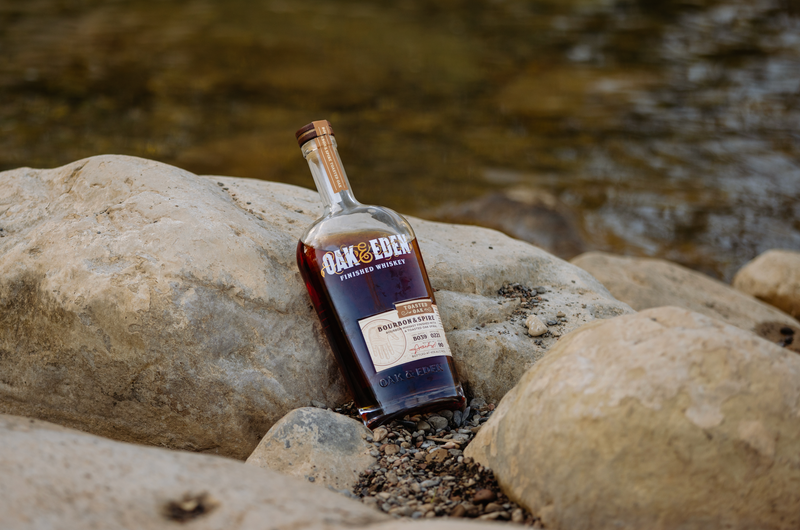
HOW MUCH ALCOHOL IS IN WHISKEY? | OAK & EDEN
How Much Alcohol Is in Whiskey?
When it comes to alcoholic beverages and distilled spirits, there are quite literally hundreds, if not thousands, of different options depending on how you lump or divide categories. From cognac to tequila to regular beer, there are plenty of options. While there are many ways to think about alcoholic drinks, one important aspect to consider is alcohol content.
Alcohol content, or alcohol percentage, can range from three to five percent in the lightest beers to 80-90% in the strongest pure alcohol moonshines. The alcohol content of a drink is one of the major elements that help divide the different types of alcohol as well as separating beer, wine, and liquor.
Whiskey is our alcohol of choice, and if you're here then it's probably yours too. So let's take a deeper dive into our favorite liquor and discuss just how much alcohol there really is in whiskey.
What Is Alcohol Content?
Alcohol content is simply the measurement of how much alcohol is actually in a given liquid. This is usually expressed as a percentage of the amount of alcohol relative to the total volume of the liquid, which is expressed as ABV, or alcohol by volume.
The ABV of a drink greatly impacts the amount of alcohol that is actually in a given drink. This is why the standard pours for beer, wine, and liquor are different. While the size of each pour may be different, the actual amount of alcohol in each is relatively similar, giving you a general idea of the amount of alcohol you are consuming.
The standard drink serving sizes are 12 ounces for beer, five ounces for wine, and one and a half ounces for hard liquor. The average ABV for these drinks is five percent for beer, 12 percent for wine, and 40 percent for liquor. This gives each standard drink about 14 grams of alcohol.
How Much Alcohol Is in Whiskey?
The alcohol content of alcohol is a seemingly simple question but the reality is there is no simple answer. Or perhaps a more accurate way to say it is that there are many different answers that could be correct for how much alcohol there is in whiskey.
At different points during the whiskey-making process, you may have very different answers. Here is a deeper dive into the alcohol content of whiskey as it moves through the process from grain to bottled liquor.
Fermenting The Grains: Seven to 10 Percent ABV
The first step where alcohol is produced in the whiskey-making process is during fermentation, where the grain mash is ground, mixed with hot water and yeast, and then left to ferment. This allows the yeast to consume the sugars, leaving behind alcohol over the course of several days.
When the fermentation process is complete you are left with a liquid which is called the distillers beer, which has higher alcohol content than, say, a weak port wine.
Distillation: 80 Percent ABV
The very next step in the process takes our whiskey-in-the-making to its highest alcohol content overall. Distillation is the process that allows for the creation of high-proof alcohols. Distillation involves at its core the boiling of the alcohol.
Because alcohol has a lower boiling point than water and other liquids, it will evaporate first. By collecting this gas and condensing it you can get a more concentrated, purer alcohol. There are two main ways that this is done in the world of alcohol making — pot distillation and column distillation.
With modern distillation techniques, it is possible to get very close to 100 percent alcohol, however, few liquors are ever distilled to that level. Whiskey can typically only be legally distilled to 160 proof, or 80% ABV. The less you distill, the more flavors from the original grain mash or whatever was fermented are present in the final liquid.
In To The Barrel: 62 Percent ABV
While whiskey can be distilled to up to 160 proof or 80% ABV, it cannot legally enter the oak barrels with that much alcohol. It must be watered down to no more than 62.5% ABV, or 125 proof before going into the barrel. This means that the very most alcoholic whiskey that you can buy is 62.5% ABV. If it is more than that it is technically a moonshine or other type of liquor.
Into The Bottle: 40 Percent ABV
Finally, the whiskey is ready to enter the bottle, where it is often watered down yet again. The crucial key is that it cannot be watered down too far at this stage, to fit your minimum bottling requirement.
Whiskey may not be bottled at less than 40% ABV, or 80 proof. This means that every bottle of whiskey lies somewhere in the range of 40 and 62 and a half percent ABV.
There are some whiskies available that are labeled as "barrel proof", which usually means the whiskey is around 60 percent ABV, and there are other whiskies that usually hover right at the lower limit.
Why Is Alcohol Content Important?
By this point with all of these numbers and different alcohol contents, you're probably starting to wonder why alcohol content is even important. Does it really matter if my whiskey is 60% ABV or 40% ABV?
Well, the answer is a resounding yes, it does matter. The alcohol content of the beer, wine, liquor, or mixed drink that you are consuming plays a major role in the impact the alcohol will have on you. It’s important to avoid alcohol poisoning and keep your bodily limit in check.
ABV and BAC
The ABV of alcohol by volume of your drink plays the most important role in determining your BAC, or blood alcohol content. Your BAC is a measurement of the alcohol to blood in your body, which serves as a measurement of the level of impairment caused by the alcohol.
The ABV of alcohol is typically pretty simple; it can be found on the label of any alcohol bottle you purchase. Your BAC is difficult to estimate, as it is based largely on your height, weight, fitness level, the amount of food you've eaten, sex, and other variables. That being said, the standard drinks are useful in estimating the impact that each drink may have on you, as long as you know your approximate height, weight, and sex.
There are plenty of calculators available online which will tell you an estimate of your BAC based on the drinks you've consumed, their ABV, the time over which they were consumed, etc. Knowing this information, as well as the effects of alcohol on different blood alcohol contents, you can achieve the right amount of buzz for you.
ABV Increase = BAC Increase
While it is not always true that drinking higher ABV drinks will cause you to have a higher BAC, a single shot of whiskey that is 40% ABV will not cause your BAC to rise the same amount as a single shot of 60% ABV whiskey.
This is because the alcohol content of the two shots is different, despite being the same volume of liquid. So, if you are drinking whiskey that is a higher ABV, or any liquor that is a higher ABV than is standard, you should consider that when determining your consumption.
How Much Alcohol Is in Mixed Drinks?
The final consideration to make in our discussion of the alcohol content of whiskey is the alcohol content of mixed drinks. Figuring out the alcohol content of a mixed drink or cocktail is a real challenge unless you know the exact recipe of the cocktail. Unless you are ordering a standard bar classic, you likely won't know the exact recipe.
That being said, most mixed drinks contain one to two standard drinks. Feel free to ask your bartender for an estimate and they are almost certain to be able to give you an idea of the ABV of any cocktail on the menu. Using your taste buds is not a great way to estimate ABV, as cocktails can often mask the flavor of the alcohol content better than traditional alcoholic drinks like beer, wine, or hard liquor.
This is because most cocktails contain sugarcane sugar, and some cocktails contain a lot of sugar, which helps to cover the taste of the alcohol. In most recipes, the cocktail will have more sugar than alcohol by volume, which can give you a false sense of security. If you aren't sure, just ask.
How Much Alcohol Is in Whiskey: Takeaways
Whiskey is hard liquor, making it one of the stronger types of alcohol available. But that being said, there is plenty of variation in the alcohol content of whiskey both throughout its production and in the final product.
Through production, whiskey varies from as little as seven percent alcohol when the yeast first produces alcohol in the mash all the way to 80 percent alcohol at the end of distillation. Once it is in the barrel and finally the bottle the liquid must be between 40 to 62.5% ABV.
When drinking, it is best to keep in mind ABV and the standard drinks so that you can maintain and manage your level of intoxication as you see fit. Make sure to drink responsibly.
Here at Oak & Eden, we have both standard whiskey and barrel strength whiskey available for your consideration. You can check out our fine whiskey offerings here.
Sources:
An Intro to ABV, ABW, and High-Point Beer | The Spruce Eats
How to make whiskey in six easy steps | We Are Chefs
Blood Alcohol Content (BAC) Calculator | Alcohol.org
READ THE STORY
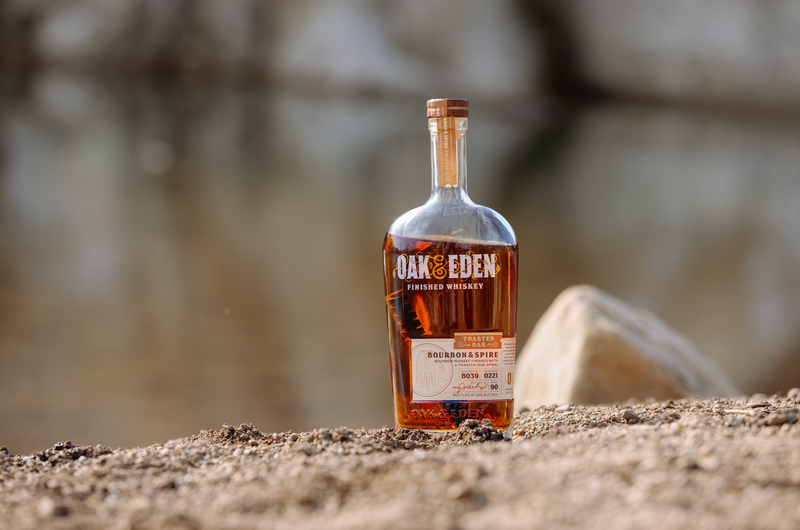
WHO INVENTED BOURBON? | OAK & EDEN
Who Invented Bourbon?
There are few styles of whiskey that are as notorious and widely available as bourbon. This American style of whiskey is truly one of a kind and is the type of whiskey most widely available at bars and liquor stores in the United States. There’s also French style and New Orleans style (made popular on Bourbon street).
But bourbon wasn't always America’s native spirit. So how was it that bourbon made its way to celebrity status and became the whiskey of choice in the USA?
We dug a little deeper into the backstory behind America's favorite whiskey so that we can give you the cut-and-dry answers to the origins of the bourbon industry and bourbon production. Here is the true story of the invention of bourbon whiskey.
How Did Whiskey Get Started?
The history of bourbon really traces itself all the way back to the birth of whiskey, the larger group to which bourbon belongs. Whiskey was amongst the first distilled alcoholic beverages in the world, some few thousand years after the invention of distillation by the Egyptians to produce perfumes and concentrates.
Whiskey was first distilled by monks in the Middle Ages in Ireland in the 11th century. They made a liquid that they called Aqua Vitae in Latin, or the water of life. This later became whiskey and is written about in documents as early as the 1400s in Northern Europe.
The Spread of Whiskey
Whiskey continued to grow in popularity amongst the nobility and later the common people of Europe. This was bolstered when King Henry dissolved the monasteries after separating from the Catholic Church, leaving former monks requiring a new source of income.
The Old Bushmills Distillery in Northern Ireland was the first licensed whiskey distillery in the world when it got licensed in 1608, and it is still operational today. These Irish and Scottish distillers came with other European settlers to the American Colonies and set up new distilleries here in the United States.
The Growth of American Whiskey
Whiskey was distilled across the colonies and was even of such value to the American colonists that it was used commonly as a form of currency during the American Revolutionary War. In fact, George Washington himself owned a very successful whiskey distillery.
The first commercial distillery in America was founded in Louisville, Kentucky by Evan Williams, a brand you likely still recognize today. But the role of whiskey in bolstering infant America wouldn't last long.
In 1791, a tax on domestic distilled spirits was levied to help pay off some of the debts taken on during the Revolutionary War, commonly referred to as the "Whiskey Tax". The grain farmers in the farmlands didn't take well to this, and for several years there was unrest between these farmers and the government called the "Whiskey Rebellion".
The rebellion ended unsuccessfully in 1794, and the tax eventually died in 1801 when Tomas Jefferson took on the presidency.
The Continued Development of American Whiskey
American Whiskey at this early stage of development was what would now mostly be considered rye whiskey, or at the very least whiskey with a very high rye content. George Washington's distillery mostly produced rye whiskey.
Before bourbon was technically invented yet, sour mash whiskey would be invented in Kentucky. Dr. James C. Crow invented sour mash by combining some of the spent mash into the new batch of mash and adding yeast from the previous batch to the new batch. This was revolutionary for making consistent batches of whiskey and is the legal requirement for Tennessee Whiskey today.
Bourbon Is Born
Finally, in 1840 when what has previously been known as " Old Bourbon County Whiskey" became officially known and labeled as Bourbon whiskey thanks to Elijah Craig. Old Bourbon County Whiskey was the first corn whiskey that the world was widely introduced to, which differentiated it from competitors.
This corn whiskey quickly became more popular than the standard rye for its sweeter, milder, and less spicy flavor profile, which made it more palatable to the average person. This style of whiskey grew in popularity until the 1920s.
Prohibition
In 1920 the United States ratified the 18th amendment, which officially prohibited alcohol in the country, especially at small batch places. This prohibition would ultimately last for 13 years, and in that time, it would do much damage to the traditional distilleries in Kentucky and Tennessee. There was only one exception to the prohibition, those with a prescription for medicinal whiskey, which could be purchased at a licensed pharmacy or from a doctor.
This medicinal whiskey program was partially responsible for the rapid growth of the pharmacy chain Walgreens, which grew from only 20 stores to almost 400 during the prohibition years.
After prohibition came to an end in 1933 when the 21st amendment was ratified, although the previous strength of rye distillers wouldn't rebound as fast as bourbon distillers in the midwest.
Bourbon continued to grow in popularity as the country expanded west, and became the quintessential whiskey of choice for most of the country by the midpoint of the 19th century.
Bourbon Becomes a Celebrity
Just three decades after the end of prohibition, the American Congress would officially declare bourbon the official distilled spirit of the country. This is also where the official requirements for a bourbon whiskey would be written into law, which we will discuss in more depth later.
Bourbon continued to grow in popularity, and today there are many popular large-scale and small-craft bourbon distilleries across the country. To celebrate the many distilleries located in the American midwest and the Smoky Mountains, the American Whiskey Trail was launched, marking a path across historical distilleries from Pennsylvania and New York down to Tennessee and Kentucky.
What Is Bourbon?
Now that you have the full bourbon history, you deserve a clear-cut answer about what bourbon is exactly. In 1964 when Congress named bourbon the official distilled spirit, it also laid out the regulations for what a bourbon whiskey is, and those rules are as follows.
51% Corn
The first rule for bourbon is that the mash bill must contain a grain mixture with a minimum of 51% corn. The remaining grains can be made of any combination of cereal grains like rye, wheat, and barley.
Distilled to No More Than 160 Proof
Bourbon may not be distilled any more than 160 proof, or 80% alcohol by volume during the distillation process. This stands out against the much higher standards for clear and neutral liquors like vodka, which are usually in the 90% range.
May Not Be Barreled at More Than 125 Proof
When the whiskey enters the barrel, it has to be watered down to a minimum of 125 proof or 62.5% alcohol by volume, meaning that you cannot get a bourbon whiskey any higher than around 60% ABV.
Several Aging Requirements
Bourbon whiskey must meet several requirements during its aging process, including that it has to be aged in new charred oak barrels or casks, and it must be aged for a minimum of two years to be called straight bourbon. Charring helps with the flavor. Furthermore, if bourbon is less than four years old, then it has to label its age on the bottle.
If the whiskey is a blend, then the age labeled has to be that of the youngest whiskey used in the blend.
Made in the USA
The final requirement for bourbon whiskey is that it has to be made right here in the United States. That’s right — it can’t be made in other countries like Scotland, France, or anywhere else for that matter. No importation allowed. In order to be labeled a Tennessee or Kentucky whiskey or bourbon, then that product has to be made in that state. However, whiskey made anywhere in the country can be called bourbon.
Who Invented Bourbon: Takeaways
Bourbon is a distinctive product and the official distilled spirit of America, and it has a long and interesting history. From the first distillation in Ancient Egypt all the way to the invention of distilled alcohol in the form of whiskey, and into the current world of whiskey, bourbon has played a critical role in the world of alcohol.
Old-fashioned bourbon was first made in Bourbon, Kentucky, but the first man to label his whiskey as a Bourbon Whiskey was Jacob Spears in 1840, the first corn-based whiskey that many people had ever tried.
Through prohibition and afterward, bourbon became more and more popular and eventually well outpaced the rye distillers on the East Coast of the United States, eventually becoming the official distilled spirit in 1964, when the official regulations were also laid out.
We make the best bourbon whiskey made by the books here at Oak & Eden. Our bourbon whiskey serves as the basis for many of our whiskies across all of our series, offerings, infusions, and collaborations. Check out some of our favorite bourbons and see which bottle you should try next.
Sources:
What is Kentucky Bourbon Whiskey? | BourbonCountry
What is Sour Mash? (with pictures) | Delighted Cooking
George Washington's Rye Whiskey | Mount Vernon
READ THE STORY
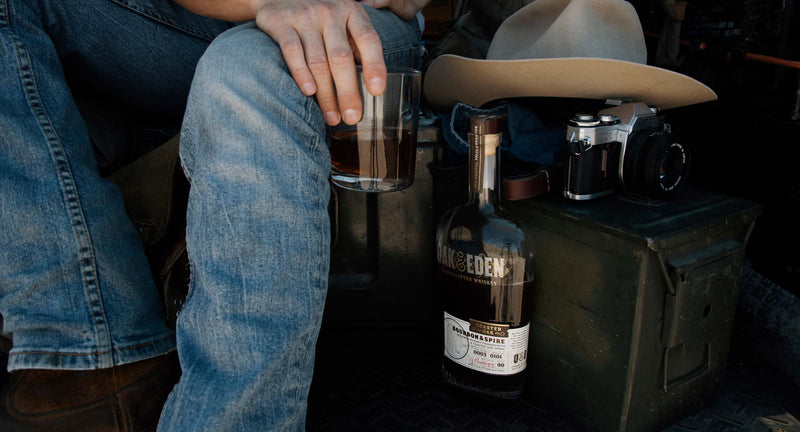
DOES WHISKEY GO BAD? EVERYTHING YOU NEED TO KNOW.
It's a common question asked by whiskey lovers everywhere: does whiskey go bad? The answer, as with most things in life, is – it depends. We get the question often enough, especially with a spire of wood in our bottle, so we figured we'd give you a definitive answer. Here's everything you need to know about whether or not your precious whiskey could go bad.
Whiskey is a distilled spirit made from fermented grain mash. It typically has a high alcohol content, and is aging in wooden casks (usually oak). Because of its high alcohol content, many people believe that whiskey can't go bad. However, this isn't actually the case.
While it's true that the alcohol content in whiskey acts as a preservative, there are still some conditions under which whiskey can go bad. If whiskey is exposed to too much oxygen, for example, it can start to oxidize and develop a rancid taste. Additionally, if whiskey is stored in a hot or humid environment, it can begin to grow mold or mildew.
Another factor to consider is if the bottle has ever been opened. Most of us are familiar with wine oxidizing within the first several hours of a bottle being opened. However, whiskey oxidizes at a much slower rate. It will take years, as opposed to days or hours, for whiskey to develop that sour flavor after being opened. If left unopened, however, a bottle of whiskey can virtually last indefinitely.
One question we often receive at Oak & Eden is "Will the spire ever over-oak the whiskey," or "Will the spire ruin the whiskey after being in the bottle for months or years?" The short answer is no, and here's why. Unlike a barrel, which interacts with oxygen, humidity, barometric pressure, temperature changes, etc. the Oak & Eden spire is fully submerged in a closed glass bottle and often stored in a cool, dark, temperature controlled environment, so once the spire has expressed all of its flavor, it cannot “breathe” the way a barrel would. After about 6 weeks, the spire exhausts and has no flavor left to express. Additionally, because the spire is made of American white oak, a closed-grain wood, and stored in a high proof alcohol, it is impossible to harbor bacteria or mold.
For most of us who store our whiskey in cool, dim environments, however, the spirit will remain perfectly fine to drink for years – even decades. If you're ever concerned that your whiskey has oxidized, or gone bad, the best way to test it before trying it is to give it a smell. If it smells like vinegar, or anything other than whiskey, it's probably best to pour it out. More often than not, it'll be just as delicious as the day you bought it.
READ THE STORY
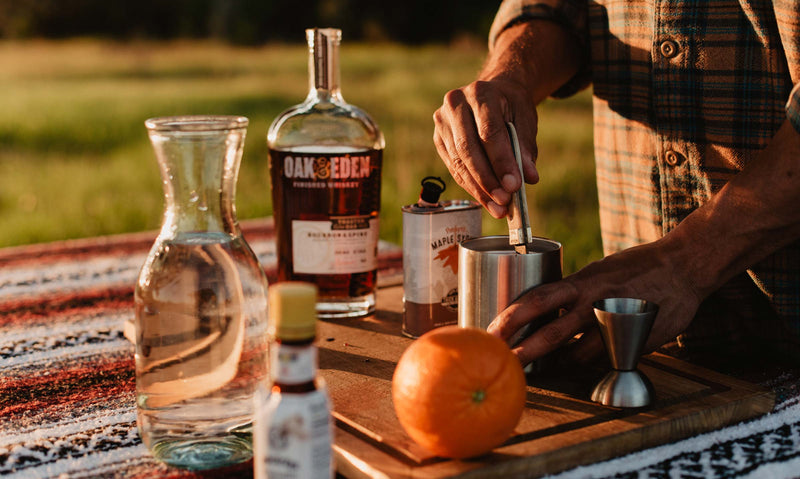
TOP 5 FALL TRANSITIONAL WHISKEY COCKTAILS
We're on our way to saying "So long" to summer and "Hello, fall!" The air is still warm, but the end is in sight and we are beginning to put the refreshers away and break out the bolder, warmer, richer cocktails. Whether you're new to mixing cocktails at home or a seasoned mixologist, we've put together a list of 6 whiskey cocktails we are mixing up that are perfect for the transition from summer to fall.
Coffee Fizz
DIFFICULTY LEVEL: EASY // PREP TIME 3 MINUTES
There’s just something about whiskey and coffee that makes a perfect match. This whiskey cocktail is both refreshing and rich, making it the perfect drink to enjoy as we transition from summer to fall. Whether you’re winding down after a long day or just want to enjoy a unique cocktail, the Coffee Fizz is sure to hit the spot. This simple whiskey cocktail features Oak & Eden's cold brew coffee infused Bourbon & Brew, simple syrup, heavy cream, and soda water. Simple & balanced, it's the ideal whiskey cocktail for any coffee lover.
Click here to see the recipe
Gengine Risk
DIFFICULTY LEVEL: MEDIUM // PREP TIME 6 MINUTES
We all take risks every day, but sometimes it's the calculated ones that pay off the most. Tangy and spicy, this fall transitional whiskey cocktail is an intelligible balance between coastal living and refined luxury. This cocktail features Oak & Eden Rye & Spire, allspice dram, pineapple syrup, lime juice, and chocolate bitters. Perfect for whiskey lovers who enjoy a little bit of everything, the Genuine Risk is a delicious way to transition from summer to fall.
Click here to see the recipe
Mr.Evans
DIFFICULTY LEVEL: MEDIUM // PREP TIME 15 MINUTES
When it comes to whiskey cocktails with complex ingredients, sometimes less is more. A tried and true whiskey cocktail, the Mr. Evans is perfect for summer days that are still warm but with a hint of autumn in the air. For those who can't decide whether they like bourbon or Cabernet better, Mr.Evans is your cocktail. This whiskey cocktail features Oak & Eden's Cabernet infused bourbon, Bourbon & Vine, cabernet syrup, lemon juice, and egg white.
Click here to see the recipe
Espresso Martini
DIFFICULTY LEVEL: EASY // PREP TIME 5 MINUTES
Another coffee cocktail, the Espresso Martini is on the bolder, sweeter side of the spectrum than the Coffee Fizz. The Espresso Martini whiskey cocktail is perfect for those who want to enjoy a delicious dessert and a whiskey cocktail all in one. This whiskey cocktail features Oak & Eden Bourbon & Brew, coffee liqueur, chocolate liqueur, and heavy cream. A delightful way to end any meal or get a little pick-me-up, the Espresso Martini is a must try for whiskey lovers and new whiskey whiskey drinkers alike.
Click here to see the recipe
Old Fashioned
DIFFICULTY LEVEL: EASY // PREP TIME 3 MINUTES
It may seem like a no-brainer, but the Old Fashioned is the whiskey cocktail that typically takes the back burner during the spring and summer seasons. For this reason, it's the perfect whiskey cocktail to transition into fall with. The Old Fashioned whiskey cocktail is simple, bold, and classic. This whiskey cocktail features Oak & Eden Rye & Spire, Angostura bitters, and demerara syrup. If you're looking for a whiskey cocktail that is sure to please, look no further than the Old Fashioned.
Click here to see the recipe
READ THE STORY
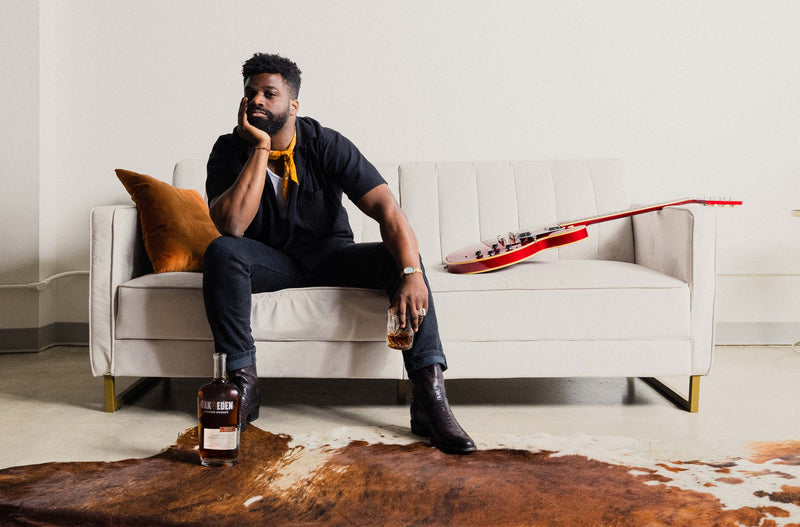
ABRAHAM ALEXANDER X OAK & EDEN WHISKEY
A compilation of heartaches, memories, and faith is what makes Abraham Alexander the man that he is today. Although a young musician, Alexander has gone through life experiences that most will never encounter in a lifetime. Born in Greece to parents of Nigerian descent, Alexander moved to Texas when he was 11. Shortly after the immigration, he tragically lost his mother to a drunk driver, which he describes as the pivot point in his life. Now, he tours with acclaimed artists, such as Leon Bridges and Gary Clark Jr. and has embarked on a solo career that most aspiring musicians could only dream of.
While revered for his musical intellect, his gift for music was actually a recent discovery. Growing up, sports were a universal language for Alexander. In particular, soccer was the sport that truly broke barriers for him. Alexander played Texas Wesleyan, but after an injury permanently sidelined him, he was left wondering what was next. He picked up a guitar and began gigging, recognizing he had a knack for performing. His iconic balance between soul, hip-hop, and blues will make you feel his music, more than you hear it, and others took notice.
In 2015, Alexander bumped into Texas legend, Leon Bridges while Bridges was setting up to record his first album Coming Home. After hearing Alexander humming and noticing his vocal range, Bridges asked Alexander to sing harmony in the album, which charted at number six on the US Billboard 200, and was nominated for Best R&B Album at the 2016 Grammy Awards. From that point moving forward, Alexander’s career has skyrocketed, taking him on tours across the world and growing a cult following, but it’s not his music that draws such attention. Alexander carries a supernatural peace and clarity with him that would calm a storm. He describes his various life trials as the springboard moments that were used for an undefeatable joy that he carries. This joy is unmistakable whether listening to his music, watching him on stage, or enjoying a shrimp basket at Coco Shrimp in Fort Worth.
We collaborated with Abraham to make his custom bottle of bourbon finished with a vanilla infused American Oak spire. The vanilla finish imparts a warm, steady, and nostalgic note to our award winning bourbon. It’s the feeling of coming home after a lifetime of labor and, similar to Abraham’s experience, it’s worth the wait.
READ THE STORY
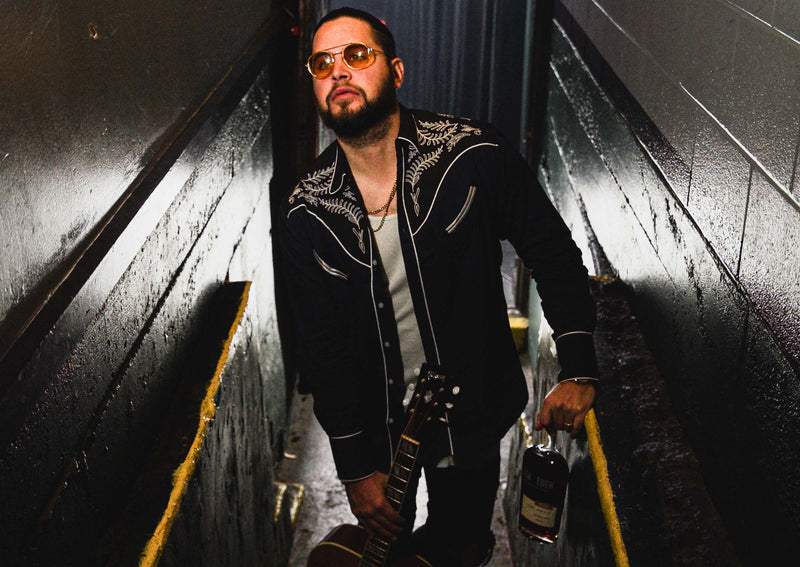
FILMORE X OAK & EDEN WHISKEY
Rising Nashville country music singer-songwriter, Tyler Filmore, better known as ‘Filmore’ is anything but typical when it comes to fashion, sound, and career building. The Nashville musician was born in Wildwood, Missouri, where suburbia touches cornfields. He quickly developed a passionate grassroots following after debuting his single, ‘Slower’ in 2018. Since then, he has taken a “yes” approach to his career, accepting every performance opportunity that came his way, which ultimately led him to performing alongside Sam Hunt, Russell Dickerson, Brett Young, Carrie Underwood, Jon Pardi, and Dan + Shay, as well as performing at venues like Grand Ole Opry, Watershed, CMA Fest, Stagecoach, Country Thunder USA, SXSW, and Faster Horses.
Growing up in Wildwood forced him into a life full of diverse activities, from building forts in the woods to performing in musicals, which influenced his decision to pursue music as his final passion. At the helm of that decision, he made the move to Nashville, where he would find his true, distinctive sound. He recalls moving to Nashville solely because it was the closest place to Missouri that he could afford to drive to and make music. On his relocation journey to Nashville, he performed at every coffee house and venue that would take him, which launched his career into touring, and eventually writing and performing on Broadway.
Alongside a very loyal fanbase, Tyler has built an incredibly loyal team of musicians who have performed together since the very beginning. They have built traditions and routines that make for a very healthy band of brothers. From gathering to pray before shows to, vocal checks, to toasting over a glass of whiskey before shows, the rhythm of their routine has instigated a posture of respect and admiration for one another, making for a one-of-a-kind experience at every performance.
Tyler has always considered himself a coffee connoisseur and appreciates a fine, craft coffee. He has also been a long-time bourbon enthusiast and enjoys a strong bourbon whether at performances or sitting on the porch at his house. We collaborated with Filmore to create a barrel strength bourbon finished with an American Oak spire steeped in cold brew coffee. It is a truly remarkable, bold, rich bourbon that is truly anything but typical.
READ THE STORY
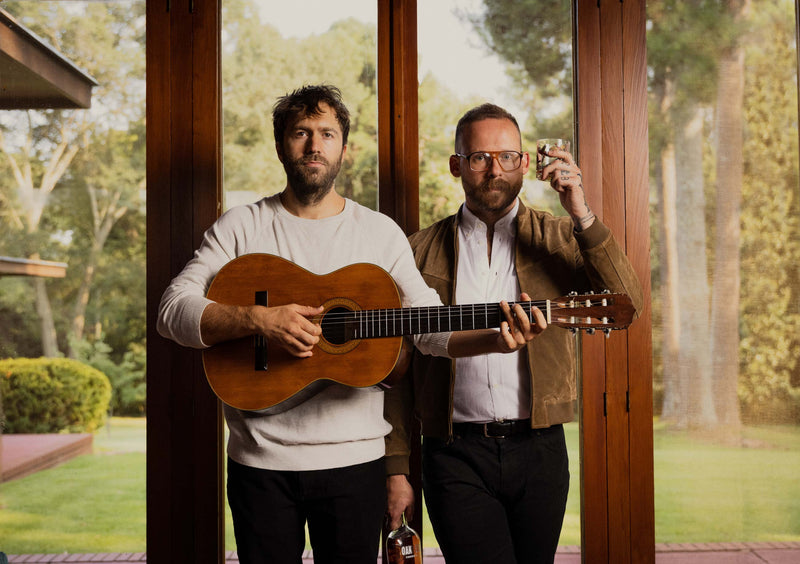
PENNY & SPARROW X OAK & EDEN WHISKEY
Kyle Jahnke and Andy Baxter, or better known as Penny & Sparrow are an iconic Yin and Yang. This musical duo is as playful, authentic, and care-free as it comes. They grew up in different parts of the world, but came together during their time at the University of Texas and began writing and performing shortly after that.
Their music is intimate, personal, magnificent, even cinematic. Deeply vulnerable, and perhaps even emotional, their songs blur the lines between indie-folk and alt-pop. When we first met Andy and Kyle, we immediately picked up on the deep brotherhood and love they have for each other. There is a mutual honor, respect, and support for each other, which compounds the sincerity in their songwriting. “Essentially, we have the same DNA,” shared Baxter, “but different genetics.” Professionally and personally, they share one heartbeat. It’s absolutely mesmerizing.
In 2014, the two quit their day jobs and took on careers full of bookings, tours, and songwriting. After their fourth album, Let a Lover Drown You, they had quite the following and the critics started speaking up. NPR praised the band’s songwriting as a “delicate dance between heartache and resolve,” while The World Café raved that they’ve “steadily built a sound as attentive to detail as Simon & Garfunkel and as open to the present day as Bon Iver.” Rolling Stone hailed their sound as “folk music for Sunday mornings, quiet evenings, and all the fragile moments in between.”
Jahnke is a gifted guitarist with a keen ear for melodies, whereas Baxter is a talented lyricist with a haunting voice and can steer an unmistakable falsetto harmony into any tune. Baxter’s mind swirls around words, books, and stories that form within. Jahnke, on the other hand, is unapologetically more simple. “It’s coffee, the excitement to drink it, and quality sleep for me,” Jahnke says. “When you dive into the details and emotional bearings of these traits, they’re quite similar, just articulated with a twist.”
We partnered with Penny & Sparrow in the Anthro Series to create a bottle of cask strength bourbon finished with a charred American Oak spire. This composition of ingredients is a perfect go-to when it comes to writing and performing. And on that note, we suggest that you listen to their newest single, Adeline, a song crafted out of pieces from years spent learning, hoping, and dreaming, all distilled into one love song.
READ THE STORY
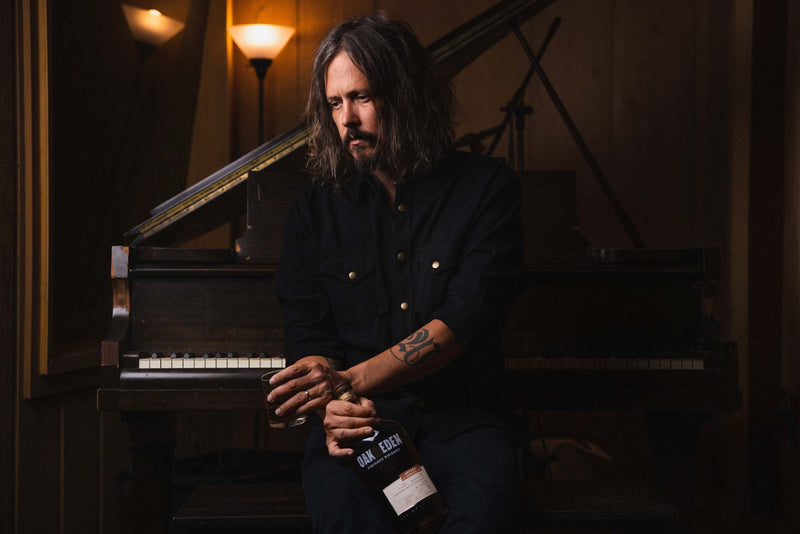
JOHN PAUL WHITE X OAK & EDEN WHISKEY
John Paul White is a classic, idealistic Americana dream. Many would recognize White’s haunting harmonies and undeniable lyricism from his days as one half of the heavily decorated Americana duo, The Civil Wars, but the man behind the melody is as charming as the music he creates.
White was raised on a chicken farm in the tiny town of Loretto, TN. He turned his humble passion for music into a career that would lead him to becoming a four-time Grammy Award winning musician. His interest in music sparked when he and a group of friends performed at their high school talent show, where they would lip sync Back in Black by AC/DC. White was the vocalist for the sheer fact that he was the only one who could recite all of the lyrics. This early introduction to music would plant the seed for a career that would help shape the future of Americana music as we know it.
Throughout the years, he leaned into timeless musical influences such as Merle Haggard and Johnny Cash, who were the inspiration that would help shape his voice. He would go on to cultivate a career throughout the Nashville scene for two decades, first as a singer/songwriter, and then as a publisher. In 2008, he released the album The Long Goodbye. The very next year, he teamed up with Joy Williams to form The Civil Wars. The duo would go on to win four Grammy Awards between 2011 and 2013.
White made home in Florence, Alabama, not too far from Muscle Shoals, where he would continue his solo career, releasing Belulah in 2016 and The Hurting Kind in 2019. While he continues to write and perform, he admits he enjoys being home more often with his wife and children. He currently teaches two classes at the University of North Alabama, and recently started a band with his son. “It makes me feel like a young, passionate musician all over again,” White said.
We partnered with John Paul White to craft his very own custom bottle of whiskey. He selected a barrel strength 4 Grain Bourbon, finished with a charred American Oak spire. It is a bold, smooth, and legendary bourbon, just like the legend himself.
READ THE STORY

JAMESTOWN REVIVAL X OAK & EDEN WHISKEY
Texas native Americana rock duet, Jamestown Revival, made up of Jonathan Clay and Zach Chance, developed a lifelong friendship at an early age, writing music together when they were kids. The two, along with their band, have made quite a splash in the music scene with their haunting, Simon & Garfunkel-esque harmonies and their huge stage presence.
In 2014, they release their first album ‘Utah,’ and were immediately named iTunes’ Singer/Songwriter of the year and have since had over 55 million streams. They have performed at festivals such as Coachella, Stagecoach, Lollapalooza, Farm Aid 2019, Willie Nelson's Outlaw Music Festival, Austin City Limits and Bottlerock, among others. They’ve performed on Conan, had music featured on NBC’s hit show, ‘This is Us,’ as well as a national Dodge Ram commercial. This duo has earned the love of thousands, and we figured it was high time to create a whiskey together.
In 2020, we released ‘Round Prairie Rye’, a signature exclusive collaboration with Jamestown Revival. The level of demand of Round Prairie Rye led us to develop a reprise with Jamestown Revival under Oak & Eden’s Anthro Series.
The name pays homage to Round Prairie Road, which leads to Jonathan’s family ranch near Houston, TX, where Zach and Jonathan grew up playing and writing music. On their 2019 album ‘San Isabel,’ they wrote a song called ‘Round Prairie Road,’ which is about the ranch and how over the years, oil companies have moved in to exploit mineral rights, fences began going up around them, and their little piece of paradise began to lose much of its holiness. The song is passionate, raw, and soul shaking, which inspired us to name the collaborative barrel proof rye blend release, ‘Round Prairie Rye’.
Keeping in line with the personality of the band, we realized that we needed to keep this whiskey as pure and unaltered as possible. Being rye drinkers themselves, Jonathan & Zach began with Oak & Eden’s award winning rye whiskey, at 116 proof (58% ABV), making for a robust, yet surprisingly smooth finish. We then finish this barrel strength rye whiskey with a toasted French Oak spire, imparting a rich, creamy finish.
You can your very own bottle of their signature whiskey here.
READ THE STORY

FORRIE J SMITH X OAK & EDEN WHISKEY
It all started when six-year old Forrie J Smith fell off of his horse in front of his mother and immediately told her he wanted to be a stuntman. Forrie is a seasoned cowboy and legacy Hollywood stuntman, but is most known for his role as Lloyd Pierce on Paramount Network’s hit TV show, Yellowstone. Luckily for him, growing up in Helena, Montana was the ideal scenery for him to learn the ropes of the rodeo and master his horsemanship. He was introduced to the rodeo by his father and grandfather and caught rodeo fever early on. At eight years old and on his second pair of chaps, Forrie began competing in rodeos.
After 52 years in the rodeo, Forrie stopped competing. He describes this as a time that his “mind was writing checks that his body couldn’t cash”. After his rodeo life came to an expiration, he pursued a career as a stuntman in Hollywood where he would spend the next 25 years working on sets for films like Rambo III, Desperado, Tombstone and Hell or High Water. Forrie credits much of his rodeo experience to his success as a stuntman, namely the thought disciplines that come with the territory of competing with such intensity.
His stuntman career would ultimately lead him to landing a spot as a series regular on Paramount Network’s hit TV show, Yellowstone. After appearing as a recurring character for the first two seasons, he was brought on as a full-time character in Yellowstone season three. Forrie compares rodeo competitions to filming, describing the similarities of riding an adrenaline rush until you’re finished, completely diminishing any nerves that may have creeped in initially.
As far back as he can remember, Forrie recalls enjoying a bold cup of cowboy coffee every morning before jumping on his horse, which made it fitting to create his very own cowboy coffee-infused bourbon. We collaborated with Forrie to create a barrel strength bourbon finished with an American Oak spire steeped in cold brew coffee. It is a remarkable, bold, rich bourbon that is truly one-of-a-kind.
READ THE STORY
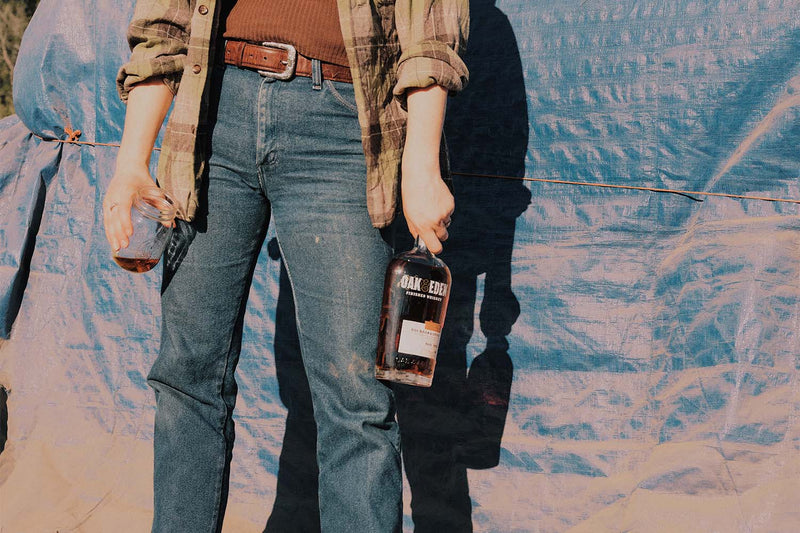
WHISKEY AGING BARREL: WHAT TO KNOW
There are many elements that go into crafting a delicious whiskey.
Every great whiskey starts with a unique mash bill: the grains that are fermented to start the whiskey-making process by turning sugars into alcohol. From wheat to corn, barley, and malt, each whiskey has its own specific blend and grains sourced from unique locations granting their flavors to the blend.
Then, there are the fermentation and distillation processes, both of which create and increase the alcohol content of the liquor. A distiller's skill is showcased here in their ability to create a smooth and clean product from the distillation of alcohol. Aging spirits is an art form, whether it’s tequila, Irish whiskey, or bourbon coming out of the distillery.
Of course, there is still much left to be added to the whiskey. Specifically, there’s one final step that practically every single whiskey goes through: aging. Not only is the age of a whiskey important, but how whiskey is aged impacts the quality, flavor, and depth that a bottle achieves.
The aging process is a complicated part of whiskey-making that is absolutely critical for a rich and complex spirit. Here’s a brief guide to help you understand everything that you need to know about the whiskey aging process and how it impacts your drink.
What Does Barrel Aging Do To Whiskey?
Let’s start by tackling what is probably your biggest question: what aging actually does to a whiskey. While there are many facets of a whiskey that impact its flavor, by far the most important one is the aging process. This starts with American White Oak wood staves, which help to give the whiskey its distinct bitter flavor.
When a whiskey reaches maturity in American oak aging barrels, something truly magical takes place. As the whiskey sits in the barrels through the seasons, the temperature and humidity of the storage room will change, which causes the wood to expand and contract. This causes the wood to almost breathe the liquid as the surface area broadens. As the whiskey is breathed back out, some of the wood sugars, tannins, and vanillin compounds stay in the liquid, adding flavor and color.
The longer a whiskey is aged, the more flavors it can absorb from the wooden barrels it is placed in. The aging process is also responsible for all of the color that you get from a high-quality whiskey. When whiskey enters the barrel, it’s clear like any other neutral grain spirit. Through this aging process, the whiskey takes on the dark colors of the wood. The longer a whiskey is aged, the darker the color will be.
It is critical that whiskey be aged in wood, not metal. Metal does not impart flavor characteristics when you age alcohol in it. Many cheap wines are aged (briefly) in metal casks to keep them fruity and bright without dark woody flavors, but that’s not the norm for whiskey. Aging in wood adds flavor and depth, while aging in metal does not.
How Does Aging Work?
The heart of the aging process comes from the porousness of wood and temperature fluctuations.
When whiskey was first distilled and aged, there were no temperature-controlled aging rooms where they could control the climate for the aging of liquor and alcohol. Because of this, the temperature would invariably change from summer to winter and back year after year, causing the wood to expand and contract over time.
As the wood expands, it becomes more porous and allows the whiskey to enter the wood, where it mixes with the natural botanicals and elements of the wood. These botanicals and elements add flavor and color to the whiskey before it’s dispensed from a spigot or other dispenser.
During the cooler months when the wood contracts, the whiskey is pushed out of the wood along with some of the botanicals and colors, creating a darker, more flavorful product.
What Is Angel’s Share?
If you’re familiar with the whiskey-making process, then you may have heard of the inside term “angel’s share.” The angel’s share is a part of the whiskey-making process which has been acknowledged by whiskey makers since the drink’s earliest days.
As whiskey ages, it naturally loses some of its volume to evaporation. This means that the air in a room with whiskey barrels aging is more alcoholic than normal, giving the air a very nice smell. This does, however, mean that whiskey is lost over time due to oxidation.
Monks were among the first people to have written records of making and drinking whiskey. They called the portion of whiskey lost in aging the “angel’s share,” as it floated up to heaven as an offering in their logic. However, this whiskey was probably closer to moonshine than the whiskey of today.
The longer a whiskey is aged, the more is lost to the angel’s share. This is part of the reason why whiskey that is aged longer is more expensive — it takes more whiskey in the barrel to get the same amount out at the end.
Are There Requirements for Aging Whiskey?
Now that you know just how important aging is to a whiskey, you may wonder if there are certain requirements, limitations, and restrictions that your own whiskey must follow during its aging process. Yes, but it depends: different types of whiskey have their own specifications for aging requirements.
For instance, Bourbon whiskey has to be made and aged here in the United States, and it must be aged for a minimum of two years in new, charred American White Oak bourbon barrels. This is what gives bourbon its characteristic oaky, vanilla, and caramel nose. If you plan on making your own spirits using a small barrel, you’ll need to meet these standards for it to be considered bourbon.
Other whiskeys can be aged for much, much longer, like many Scotch and Irish whiskeys, which are regularly aged for decades before being bottled in the most expensive bottles. These handcrafted drinks are best enjoyed straight out of a decanter rather than used to create an aged cocktail.
The type of wood, size of the barrel, location where the barrels are stored for the aging process, level of care on the barrel, and previous uses of the barrel all impact the flavors that can be added and imparted to the whiskey in the barrel.
What Does a Whiskey Age Statement Mean?
When you look at a bottle of whiskey (or any bottle of liquor for that matter) and you see that its age advertised on the bottle, you may think that this means the liquid in the bottle is exactly that many years old. Well, this isn’t quite so: the age statement is only the age of the youngest whiskey included in the blend at the time it was bottled.
This means that if you have a fifteen-year aged bottle of whiskey from Scotland, you have a bottle of different whiskeys blended together of which the youngest whiskey was fifteen when it entered the bottle.
What Happens as a Bottle Ages?
Once the whiskey enters a bottle, you might hope that it continues to get better with age and improves over time just as it would in the barrel. However, once most whiskeys enter the bottle, the aging process is over and no additional flavors are added.
This isn’t the case with Oak & Eden Whiskey. Our whiskeys use an innovative new technology that turns the whiskey world on its head: in-bottle finishing. Every single bottle of Oak & Eden whiskey contains one of our Spires.
These Spires are expertly crafted spiral-cut wooden spires which are charred and selected specifically for each blend of our whiskey. These spirals add a finishing touch to our whiskey while it sits in the bottle waiting for you to drink. Each bottle of Oak & Eden gets a spire to add just a bit more depth and complexity that you can taste in every drop.
Takeaways
There are a lot of aspects of a great whiskey, but one of the most important is the aging process. How whiskey is aged is responsible for all of the color in a whiskey and many of the complex flavors as well.
The aging of a whiskey in American White Oak barrels works because of temperature variations over time. This causes the wood of the barrels to expand and contract, allowing whiskey in and out of the wood. This allows the whiskey to grab on to some of the colors and natural botanicals in the wood, which then stay with the liquid when it is pushed back out of the wood in the winter.
Different types of whiskey need to be aged for different lengths of time. For instance, bourbons have to be aged for a minimum of two years in new barrels, while other kinds of whiskey require different types of wood and different age requirements.
The age statement that you see on a bottle of whiskey when you buy it is actually only the age of the youngest barrel of whiskey included in the blend. This means if you have a five-year-old whiskey, it could contain whiskeys older than five years, but not any younger.
Once a whiskey enters the bottle, it is normally no longer able to age and mature. Oak & Eden whiskey uses state-of-the-art in-bottle finishing techniques that we innovated to add depth after bottling. These techniques also make our bottles phenomenal picks for father’s day gifts or groomsman gifts, as well as for toasting at your next special occasion.
Aging whiskey is a crucial step in the process. With this knowledge, you will better be able to enjoy and appreciate a finely aged whiskey.
Sources
Distillation | Organic Chemistry CU Boulder
What Is the Effect of Aging on Liquor? | The Spruce Eats
What Is the Angel's Share? | The Whiskey Wash
READ THE STORY
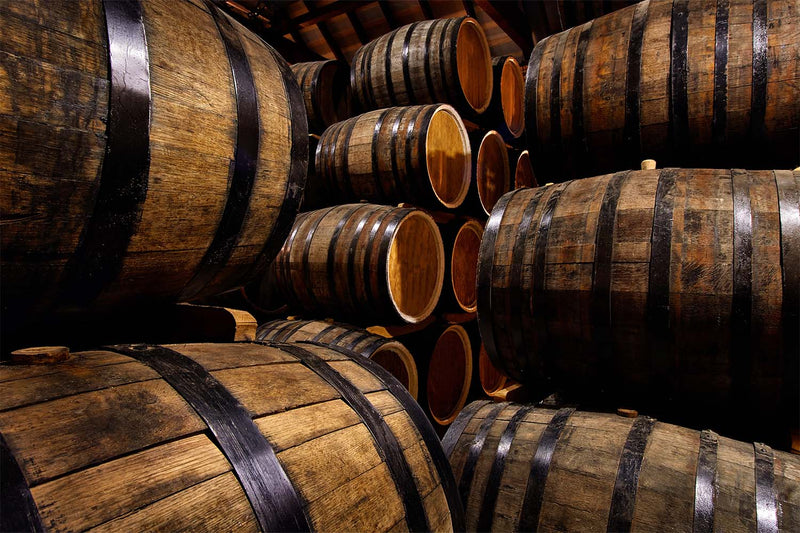
BOURBON AGING BARREL: WHAT YOU NEED TO KNOW
Oak is the key to aging bourbon.
Oak barrels are essential to the bourbon aging process because they impart flavor and color to the spirit as it matures. The type of oak, how long the barrel is charred, and where the barrel is stored all play a role in the final flavor.
A bourbon barrel is charred to create a surface that will interact with the spirit and help impart those flavors we all know and love. There are different types of oak, each lending its own nuance to the process. Let's take a closer look at what goes into making a bourbon barrel and how it affects the taste of one of America's most popular spirits.
What Is Bourbon?
Bourbon is a type of American whiskey that is made from corn and other grains.
Bourbon's main ingredient is corn, and the mash bill must be at least 51% corn to be a true bourbon. Other grains that can be used to make bourbon include rye, wheat, and barley.
Bourbon must be aged in new oak barrels for at least two years. The barrels must be made of American oak that has been charred on the inside. These barrels give bourbon its characteristic amber color and unique flavor.
Bourbon must also be bottled at 40% ABV, or alcohol by volume, in order to be considered authentic. You can find many "cask strength" whiskies available that feature ABV of up to 60% or more. We offer some higher-proof bourbons and whiskies in our Collaborations Series.
What Do Barrels Do for Bourbon?
Beyond serving as a vessel to hold the whiskey while it ages for a minimum of two years, the bourbon barrel serves another important purpose. When the whiskey enters the barrel it is clear, and when it is ready for the bottle, it is a deep, rich amber color, full of flavor and depth.
All of the color and a majority of the flavor in any bottle of whiskey comes from the barrel, with the rest coming from the grains in the mash bill.
So, what does the barrel do for your bourbon? It takes a nearly neutral grain alcohol and turns it into delicious, caramel-colored whiskey.
How Are Bourbon Barrels Made?
The bourbon barrels that any distillery uses have to be brand new barrels, meaning they all start out at the cooperage. At the cooperage, they receive shipments of American Oak. All bourbon must be aged in American oak, which has been cut into staves — the technical term for the planks of wood that make up each barrel.
The barrel heads are then made, and the staves are put together and held in place with metal hoops. This is done so so that the barrels are completely liquid-tight, but not so that they are completely air-tight. That extra airflow is what allows for the flavor to get in.
Next, the barrel is filled with water to soak for several days. After the barrel has soaked, it’s time to char the inside.
Charring is done by setting the barrel on fire and letting it burn for about 30 minutes. Every whiskey and bourbon barrel has to be charred, but the level of char is left up to each distiller. Charring can be a major difference-maker for the flavors of different distilleries' whiskies.
Once the barrel has cooled, it is then filled with bourbon and sealed. The barrel will sit for at least two years and usually for longer — up to decades. During this time, the bourbon will take on the flavors of the wood, creating a unique and delicious taste.
How Does Barrel Aging Work?
When you put a whiskey or bourbon into a barrel, the barrel is liquid-tight but not airtight. This means that the barrel is susceptible to temperature and humidity changes.
Wood is porous, meaning that it has pores that liquid can fill. This is why wood stays wet longer than a metal pole. As the temperature changes through the seasons, the wood that makes up the barrels expands and contracts, affecting the wood's porousness.
This expanding and contracting of the wood pulls in and pushes out the whiskey, and along with the whiskey, botanicals, flavor notes, and coloring agents leave the charred wood and enter the whiskey.
These additions mellow out the harsh flavors of the liquor and impart the rich color and deep vanilla, oak, and caramel flavors that bourbon whiskey is known for.
What Types of Wood Are Used for Whiskey Barrels?
While bourbon has to be made in new, charred American oak barrels, not all types of whiskey are limited in this way.
Across the globe, whiskies are made using all sorts of different kinds of wood, and we even make several whiskies here at Oak & Eden that utilize woods other than American oak for finishing.
The most common types of wood used in whiskey barrels are:
American Oak
American Oak barrels give whiskey a rich, deep flavor with notes of vanilla and caramel. American Oak is the most common type of wood used for bourbon whiskey, as well as other types of whiskey, such as rye.
Rye whiskey tends to have a spicier flavor profile, and the American Oak helps to mellow out those flavors and add depth to the drink.
French Oak
French Oak barrels tend to impart a fruitier flavor to whiskey, with notes of citrus and stone fruits.
French Oak is less common than American Oak in the world of whiskey, but it is sometimes used for a higher-end, premium whiskey. French Oak is more common in the world of Scotch whisky, where it is used to give the drink a more complex flavor.
Japanese Oak
Japanese Oak barrels are a newer addition to the world of whiskey, and as such, not much is known about them yet.
Japanese Oak imparts a very unique flavor to whiskey, with notes of green tea and bamboo. This Oak is very rare, and it is only used for special releases and limited editions.
Sherry Oak
Sherry Oak barrels are most commonly used in the world of Scotch whisky, where they impart a rich, fruity flavor to the drink. Sherry Oak barrels are made from Spanish Oak that has been seasoned with sherry.
Chestnut
Chestnut barrels are not as common as other types of wood barrels, but they can give a whiskey a unique flavor.
Chestnut barrels tend to impart a nutty flavor to the whiskey, with notes of hazelnut and almond. Chestnut is also a very hard wood, so these barrels can last longer than other types.
Chestnut barrels are most commonly used for premium and limited edition whiskeys.
Barrels Mean a Lot to Us
Here at Oak & Eden, we love the wood that we use for our whiskey because our whiskey is built on wood. Every bottle of Oak & Eden whiskey gets one of our expertly-crafted wooden spires.
These spires are made from different kinds of wood, toasted and charred to match each blend of whiskey we offer. The spires help achieve our in-bottle finishing approach to whiskey, which lets us continue to add depth and flavor to our whiskey after bottling.
We’re committed to using only the highest quality oak barrel available on the market today. We utilize both American and French oak from the best suppliers in the world to make wooden spires for our in-bottle finishing technique.
The result? Whiskey that you have to try to believe.
Why Does Bourbon Have To Be Aged for So Long?
Bourbon has to be aged for at least two years, but most bourbons are aged for four years or longer. The aging process is what gives bourbon its distinct flavor and color. The longer a bourbon is aged, the more mellow and smooth it will become.
Bourbon has to be aged for a long time because of the reactions and processes that happen over time. These reactions can’t really start until about eight months of aging have occurred.
In general, whiskey that is aged longer is more expensive — it’s going to taste better since it has had longer to age.
At the end of the day, the speed of the aging process is actually relative; the more flavor you can pull from the barrel to the whiskey in less time, the faster you can age a whiskey. However, speeding up the process has proved difficult for distillers.
The speed of the aging process is determined by the volume of liquid and the surface area of the wood. That means a smaller barrel will age whiskey faster. Of course, that requires more wood for smaller barrels, which eventually cancels out the effectiveness of this technique.
Bourbon Aging Barrel: Takeaways
The barrel that your bourbon is aged in is a major player in the flavor components that get into your whiskey.
Bourbon barrels must be made of American Oak, but other styles of whiskey can use barrels made with one of several types of wood, including American, French, Japanese, or Sherry Oak. The type of Oak used will impart different flavors to the whiskey.
Bourbon must be aged for at least two years, but most are aged for longer. The aging process is what gives bourbon its distinct flavor and color.
While aging bourbon in smaller barrels can be a way to get high-quality flavor faster, this technique is a bit of a paradox. It ages the bourbon faster, but it also gives distillers less capacity in each barrel. Ultimately, it’s up to the distiller to decide how big their barrels will be.
At Oak & Eden, we use carefully aged whiskey in our blends before using our secret element - wooden spires for in-bottle finishing. These wooden spires help unlock additional depth of flavor in all of our whiskies, and each one has its own distinct taste and aroma.
Sources:
What's the Difference Between Bourbon and Whiskey? | Food & Wine
What Is the Effect of Aging on Liquor? | The Spruce Eats
How Fire-Charred Whiskey Barrels are Made | Eater
READ THE STORY
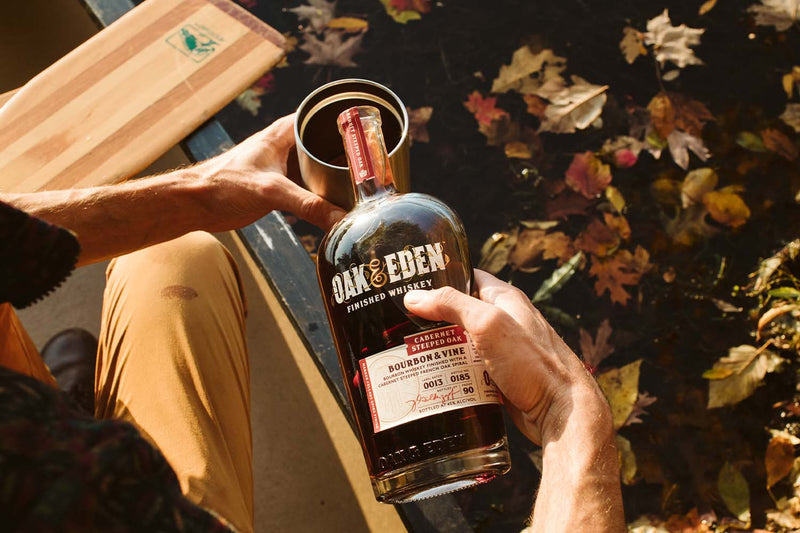
WHAT IS BLENDED WHISKEY?
If there is one thing we all know, it’s that whiskey is delicious. Still, there’s one other thing we all know about whiskey: it can be confusing for newcomers and experts alike.
There’s a lot of terminology in the whiskey world — everything from the malt to the mash bill, the angel's share, and small-batch — it can be a lot to follow. One of the terms that get thrown around a lot is blended whiskey.
What is blended whiskey? Many people have never even heard of it, let alone know what it is. Even the most experienced whiskey-drinker may not be able to answer that question off the top of their head.
That’s why we’re here to help you out and give you a better understanding of what a blended whiskey is and how it compares to the other whiskies you have tried.
What Are the Different Types of Whiskey?
Whiskey is a type of alcoholic beverage made from fermented grain.
There are many different types of whiskey, plus a plethora of sub-types to explore. For Scotch whiskey, as an example, these subtypes include single malt, single grain, blended malt, blended grain, and blended whiskey:
Single malt whiskey is made at one distillery from 100% malted barley and is distilled in pot stills.
Single grain whiskey is made at one distillery from various grains such as wheat, corn, or rye and is distilled in column stills.
Blended malt whiskey is made by blending different single malt whiskies, which can be from the same or different distilleries.
Blended grain whiskey is made by blending different single grain whiskies, which can be from different or the same distillery.
Blended whiskey is made by mixing both single malt and single grain whiskies.
All types of whiskey are aged in barrels for a specific amount of time. This amount changes based on the type of whiskey and the distiller.
The length of time that the whiskey is aged will impact the flavor profile, producing different notes and aromas. Bourbon whiskey, for example, must be aged for a minimum of two years in new charred oak barrels, while Scotch whisky must be aged for a minimum of three years in used oak barrels.
There are dozens of other ways to break down a type of whiskey into its subtypes, but when dealing with Scotch whiskey, this is the preferred method.
What Is Blended Whiskey?
Blended whiskey is a combination of two or more different types of whiskeys. The whiskeys used can be from the same distillery or different distilleries, and they can be made from any grain — but usually corn, rye, wheat, or barley.
These different whiskeys are mixed together in various proportions to create a unique flavor profile that is typically lighter and smoother than other types of whiskey. Because blended whiskey is a mixture of several drinks, there are endless possibilities for variety and flavor.
Why Blend Whiskey?
Let’s say you have the option to go for a single malt or single grain whiskey that you know is one recipe of grains or malts in the bottle. If so, why would you bother with blended whiskey instead?
As it turns out, there are a few reasons, but it starts with accepting the fact that single malt or single grain whiskies are not naturally better than blended whiskies.
This is because phenomenal whiskey is about the flavors and aromas that a distiller can create during fermentation and distillation. That’s the case for single grain, single malt, and blended whiskies alike. Combining the flavors of several different whiskies — even whiskies made in different distilleries — can even give you more flavor in one bottle.
Another reason you may want to reach towards a blended whiskey is that they are typically cheaper than single malt or grain whiskey. This gives whiskey drinkers a more affordable option in the world of Scotch, where single malts and blends are most common.
A Brief History of Blended Whiskey
Blended whiskey has a long and storied history, dating back to the 19th century.
Once upon a time, blended whiskey glass was expensive. So, when your whiskey bottle ran dry, you simply took it to your grocer, who would fill it directly from a cask.
When these casks began to run low, many grocers started putting in whatever whiskey they could get to keep the supply going — inadvertently creating blended whiskey.
The first intentional blended whiskey was created by a Scottish doctor named Johnnie Walker, who blended together different single malt Scotch whiskies to create a smoother, more consistent product.
The technique proved popular, and soon other distillers began creating their own blends. To this day, Johnnie Walker's Red Label is the most popular blended whiskey sold in the world.
In the early 20th century, blended whiskey became the preferred choice of American drinkers, thanks to its mellower flavor and lower price point. Today, blended whiskey is the most popular type of whiskey in the world, enjoyed by millions of people every day.
Thanks to its rich history and unique flavor profile, blended whiskey is sure to remain a favorite for years to come.
Why Is American Whiskey Not Labeled as Blended or Single Malt?
In most cases, the only whiskey you’ll see labeled “blended” or “single malt” is Scotch. Why?
This is because, in American regulation, the term “single malt” is unregulated. This means distillers can use it without verifying anything. For Scotch whiskey, which is only made using malted barley, single malt means more. However, American blends typically use multiple cereal grains, like corn, wheat, rye, and barley, in the mash bill.
Is Single Malt or Grain Whiskey From One Barrel?
While it might surprise you, single malt or grain whiskey isn’t from one barrel.
The word "single" in this context refers to the fact that the whiskey is made from a single type of grain. For a whiskey to be considered a single malt, all of the grains used in fermentation must be malted barley.
For a single grain whiskey, the only requirement is for the whiskey to be made at one distillery using other grains in addition to malted barley in the mash bill for fermentation.
Most whiskey, both here in the United States and the rest of the world, is made with a blend of grains from countless different barrels. So, why do distillers mix the grains like this?
The most important reason is simple: consistency.
How Does Mixing Barrels Give Whiskey Consistency?
When you drink whiskey, the flavor that you are getting is not primarily from the grains that were used to distill the liquid, but rather from the barrel that your whiskey was aged in. Whiskey would be almost entirely clear if you were to drink it without aging it, and it would be hard to tell it apart from vodka or another neutral-colored spirit.
Something special happens when the whiskey is placed in a wooden barrel for years. As the temperature and humidity in the aging room change with the seasons, the wood expands and contracts.
This pulls whiskey into the wood as it expands and pushes it back out when it contracts. While pushing out the whiskey, the wood leaves behind elements that give you the flavors we know and love.
This is why there are so many rules and regulations around the globe dictating how long whiskey should age. As the whiskey ages, each barrel becomes slightly different. This means that two barrels of whiskey made from the same batch of distillate and stored next to each other during years of aging may end up tasting completely different.
Blending different barrels of whiskey together helps minimize these flavor differences between barrels and bottles. That way, when you buy a certain whiskey, you know what to expect.
Single barrel whiskey is any whiskey that only has the liquid of one barrel in the bottle. These bottles tend to be unique, and they can be more expensive. However, there is always a risk that that one barrel isn't going to be as delicious as the next.
How Expensive Is Blended Whiskey?
As we mentioned earlier, the biggest reason blended whiskey has become so popular is that it is more affordable than single malt whiskey.
You can get a high-quality bottle of blended whiskey in the $50-60 range. On the other hand, most single malts will cost you at least twice that number and can total well into the tens of thousands for the rarest bottles.
However, blended whiskey can get just as expensive. There have been blended whiskies that have sold for well over 100,000!
Blended Whiskey: Takeaways
Whiskey is a delicious alcoholic beverage that can be enjoyed in many different ways. Blended whiskey is any whiskey that is made by combining multiple barrels together to create a more consistent flavor.
This process is different from distilling single malt or grain whiskies, which have to be produced by a single distiller.
Although blended whiskey is typically less expensive than single malt whiskey, it can still be pricey in some cases.
When enjoying whiskey, it is essential to be aware of the different types in order to choose the best one for your tastes and budget.
If you want some fantastic American whiskey to add to your collection, consider any Oak & Eden offerings. Our Finished Whiskeys series features some classic American styles, including bourbon, rye, and even a four-grain that is to die for.
In our Infused Whiskeys series, you will find more adventurous whiskies with added flavor elements like rum, wine, and coffee. Last but not least, in our Collaborations series, you’ll find our bottle collaborations with remarkable ramblers, showcasing the uniqueness of the American spirit.
Whatever you like to drink, we have a whiskey that you’ll love.
Sources:
What's the Difference Between Bourbon and Whiskey? | Food & Wine
What Is the Effect of Aging on Liquor? | The Spruce Eats
Coffey still | Whisky Advocate
READ THE STORY
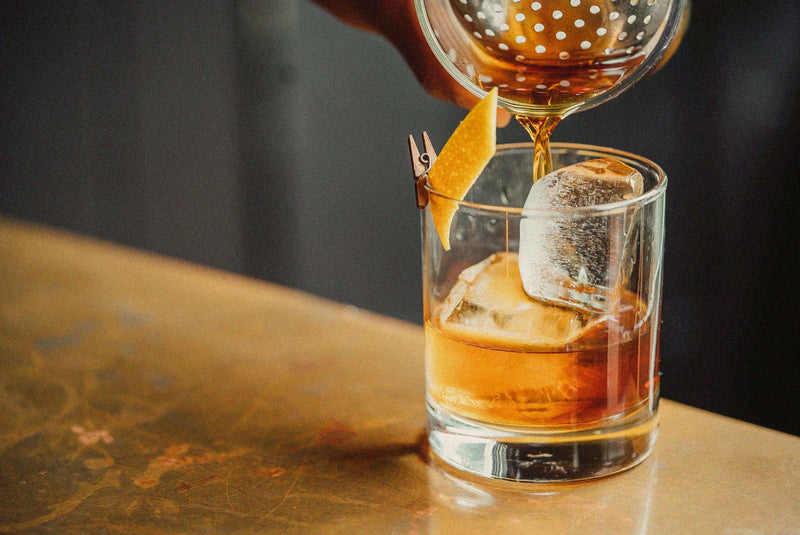
WHAT DOES ON THE ROCKS MEAN?
There are many different ways to enjoy a great whiskey. We have an entire collection of great recipe ideas for delicious whiskey-based cocktails that taste great with our Oak & Eden whiskies. You can check out a few of our favorites like the Sazerac and West of Eden here.
However, drinking whiskey in a cocktail is not your only option. As any whiskey lover will tell you, really great whiskey shines clearest when it is served straight up. But even here, you have the option of ordering your whiskey "on the rocks".
But what does "on the rocks" really mean? Here is a look at what "on the rocks" means when you are ordering at the bar, and how drinking whiskey on the rocks informs the experience. Let's get into it!
What Is Whiskey on the Rocks?
While the phrase "on the rocks" is used frequently at the bar and in popular culture, it means one very simple thing — with ice. The "rocks" are just cubes of ice.
This is as opposed to another phrase that you have probably heard before: "neat". When you order a whiskey "neat", what you are ordering is a glass of whiskey with no ice and no mixers. This makes sense when you think about it; your whiskey is served "neat" without anything else to dirty it up.
The final ordering phrase you should get familiar with so that you can order at the bar like a pro is "straight-up". If you want your drink served "straight-up" you want it chilled, but you don't want any ice in the drink. You might order a martini, for instance, neat.
Here's a fun last one for you: "with a twist" can be added at the end of any drink order to ask for a lemon twist in your drink as a garnish.
Can Cocktails Be Served on the Rocks?
Yes! Any drink that you order at the bar can be ordered on the rocks to ensure that there will be ice in your cup. You can order whiskey, or any other hard liquor, "on the rocks", as well as any cocktail.
Keep in mind, however, that some cocktails are meant to be served with ice and others are not. If you don't want to look like a confused 21-year-old at the bar, make sure you aren't ordering a drink on the rocks that no one would drink on the rocks — like a martini.
Does Ice Change the Way Whiskey Tastes?
By this point you're probably asking yourself if there is a difference between whiskey served neat versus on the rocks, and if one is superior to the other. Well, the answers might surprise you.
Having a whiskey on the rocks versus neat will provide you with a different experience, and help you identify different flavor notes, aromas, and hints that the distiller worked hard to infuse into your whiskey.
This is for two reasons, the first being temperature.
How Temperature Affects the Flavor of Whiskey
We have already written extensively on how temperature affects the flavor and shelf life of whiskey while it is in storage. If you want to read more about how to store your whiskey effectively to preserve its flavor you can check out our articles on the topic here in our Journal.
But here we're going to talk about temperature in relation to whiskey that is poured for drinking. The temperature of the liquor when it touches your tongue absolutely changes and alters the flavors that you are going to get.
The ideal temperature for whiskey to be drunk at is about room temperature, between 60 and 65 degrees Fahrenheit. This is also the ideal long-term storage temperature for whiskey, so usually, you will get the most expressive flavor from whiskey at room temperature.
Serving your whiskey on the rocks is going to chill the liquid down quite significantly, which will give you a subtler, less aggressive flavor. This can be a shame for some connoisseurs who want to get every flavor note from a whiskey, but for people looking to acclimate to the flavors of whiskey, this can be a great way to adjust to the flavors.
But temperature isn't the only way that drinking whiskey on the rocks impacts the flavor, there is also the process of dilution.
How Dilution Affects Whiskey
The other way that serving your whiskey on the rocks impacts the flavor is by dilution. Dilution is making a liquid weaker, or less concentrated, typically by adding water. When you serve your whiskey on the rocks, as the ice in your glass melts, it will combine with the whiskey, giving you a less strong glass of alcohol.
Most people think that the more alcohol in their whiskey, the better. However, there is such a thing as too much alcohol, and it can actually impact the flavor of the whiskey. When whiskey is diluted, the alcohol content is lowered, which can make it smoother and more palatable.
The downside is that dilution can also make the flavor less intense. For some aficionados, this is a good thing, as it allows them to enjoy the subtle flavors of the whiskey. Others prefer a more full-bodied flavor and find that dilution just waters down their experience.
Ultimately, it's up to you to decide whether or not you want dilution in your whiskey. If you're looking for a more mellow flavor, then go for it. If you want something with a little more kick, then you might want to stick with a higher-proof whiskey.
How To Taste Whiskey Properly
If you are ordering your whiskey neat or on the rocks, then you are likely tasting your whiskey, not drinking it, and there is a difference. When you are drinking whiskey, you are trying to get the liquid down. But when you are tasting a whiskey, you are focusing very closely on the entire sensory experience of a particular whiskey (aroma, color, texture, and flavor notes).
In order to taste a whiskey to the fullest, you have to take an organized approach that allows you to identify all the senses a whiskey exposes you to. Here is a brief guide to help you taste your whiskey to the fullest, whether you prefer it on the rocks, straight up, or neat.
Step One: Observe
The first hint you have about a whiskey's flavor profile is going to be the appearance of the whiskey. What color is your whiskey? Is it light or dark? This can give you a clue as to how long it has been aged. The longer it has been aged, the darker it will be.
The longer a whiskey is aged, the more woody flavors you should expect from the whiskey. In a clearer whiskey, you may have more flavor notes from the mash bill present, showing off the flavors of the grains.
Step Two: Sniff
Now you should give your whiskey a sniff and enjoy the aromas that the whiskey is giving off. Unlike when you are tasting wine, you should not swirl the whiskey in your glass before sniffing. This is because the swirling helps to release the flavor compounds in a drink, but also releases the alcohol vapors.
While in a wine, the added aromatics from swirling are helpful and the alcohol vapor is not too overwhelming, because of the higher alcohol content in whiskey, swirling will release an unpleasant amount of alcohol vapor.
Rather than swirling, simply take the glass near to your nose, gently take a deep breath through your nose, and see what aromas you can pick up. Is it woody? Fruity? Spicy? These aromas will give you an idea of the flavor profile of the whiskey.
Step 3: Take a Sip
Take a sip and let it linger on your tongue. Pay attention to the texture and the taste. Is it smooth or harsh? Sweet or smoky? Do you taste caramel? Or maybe vanilla?
Pay attention to everything you taste in your whiskey, and try to make connections with how other foods and drinks taste to identify interesting notes.
Step 4: Dilute Your Whiskey
The final step to a whiskey tasting is an optional one but one that most whiskey tasters choose to make. By purposefully diluting your whiskey with a few drops of water, you may be able to identify notes that were previously hidden from your palate.
If you are tasting at a distillery, oftentimes they will provide a dropper bottle with distilled water for this purpose. However, if you are tasting at home, you may find that putting an ice cube in your drink and letting it melt is the best way to dilute it for a tasting.
By taking the time to really observe your whiskey, you'll be able to appreciate all that goes into making this delicious spirit.
Is Whiskey Supposed To Be Ordered on the Rocks?
There are many ways to enjoy whiskey, and there is no one right way to drink it. Whether you prefer your whiskey neat, on the rocks, or in a cocktail, the important thing is that you enjoy it.
Whiskey can be served neat, which means it is poured into a glass with no ice. This is the best way to experience the flavor of the whiskey, as ice can dilute the taste.
Whiskey can also be served on the rocks, which means it is poured over ice. This is a popular way to drink whiskey, as it helps to mellow out the flavor.
If you want something more festive, you can make a whiskey cocktail. There are many delicious recipes to choose from, so you can find one that suits your taste. Whether you like your whiskey sweet or sour, there is a cocktail that will be perfect for you.
On the Rocks: Takeaway
There is no one right way to drink whiskey. Whether you prefer it neat, on the rocks, or in a cocktail, the important thing is that you enjoy it. Whichever way you choose to drink it, be sure to take the time to appreciate the flavor of the whiskey.
On the rocks simply means served with ice. Your alternatives are served neat (without ice) or straight up (chilled, but still without ice). There is no shame in ordering your whiskey exactly how you like to drink it.
If you're looking for a new whiskey to add to your collection, consider our offerings at Oak & Eden. All of our whiskies use our special in-bottle finishing technique, which helps layer flavors and complexity into the drink while it rests in the bottle.
Give it a try today, and enjoy it neat, straight up, or on the rocks.
Sources
Dilution of whisky – the molecular perspective | Scientific Reports
Should Whiskey Be Chilled or Drunk Straight? (2022 Updated) | Liquor Laboratory
Do You Really Know "What On the Rocks" Means? | Thrillist
READ THE STORY
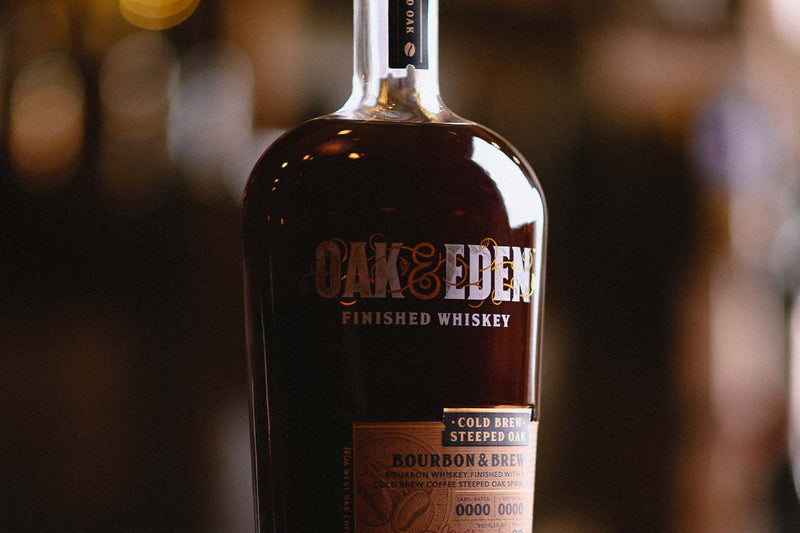
HOW TO STORE WHISKEY: A COMPLETE GUIDE
If you are a whiskey lover, then you know that proper storage is key to enjoying your drink. Whiskey can be expensive, so it's important to make sure that you store it in a way that will preserve its flavor and quality. In this article, we will discuss the different ways to store whiskey and the best practices for each method.
We will also provide tips on how to choose the right whiskey storage for your needs. So whether you are just starting out in the whiskey world or you are an experienced connoisseur, read on for information on how to store whiskey like a pro!
Does Whiskey Go Bad?
Does whiskey ever really go "bad"? Strictly speaking, no — as long as the bottle is unopened and stored properly, your whiskey will be just fine. However, that's not to say that it won't change over time. Whiskey is a complex spirit, and its flavor can be affected by everything from the type of barrel it was aged into to the length of time it spends in the bottle. So if you're wondering whether that dusty old bottle of bourbon is still any good, the answer is probably yes.
But, when you leave a bottle of whiskey that has been open in less than ideal conditions, it can absolutely start to taste wrong. This is for a few reasons, which we will get into just a bit later on.
How Whiskey Goes Bad
Whiskey will never truly spoil — as in you will not get ill because you consumed whiskey that has been stored in poor conditions. However, the flavor notes will start to deteriorate, as well as the color in less than ideal conditions. Here is a look at the two biggest culprits: sunlight and oxygen.
Whiskey and Sunlight
Once opened, a bottle of whiskey exposed to direct sunlight will begin to lose its flavor and lighten in color. This is due to the fact that sunlight breaks down the molecular structure of the liquor, causing it to evaporate and become less potent. As a result, it's important to store your whiskey in a dark place, such as a cabinet or closet, to ensure that it remains flavorful and potent.
Whiskey and Oxygen
Oxidation is the enemy of flavor in whiskey. When oxygen interacts with the whiskey, it begins to break down the molecules that give whiskey its distinct taste and smell. After a few months, oxidation will have a noticeably negative impact on the flavor of your whiskey.
The best way to prevent oxidation is to keep your opened bottles of whiskey sealed properly. You can also pour your half-empty bottles into a smaller decanter or bottle to decrease headspace in the bottle and prevent exposure to oxygen. If you take these steps, you can enjoy your whiskey for months after opening the bottle.
How To Store Open Bottles of Whiskey
Once you open a bottle of whiskey, it's important to take steps to preserve its flavor and freshness.
1. Prevent Exposure to Direct Sunlight
Whiskey should be stored in a dark place, such as a cabinet or closet, to prevent the whiskey from being exposed to direct sunlight. Sunlight can break down the molecular structure of whiskey and cause it to evaporate and become less potent.
To keep whiskey away from sunlight, you can store the whiskey bottle in a box or wrap it in foil or paper. You should also avoid storing whiskey near windows or in rooms with strong sunlight.
If you are going to drink whiskey that has been stored in direct sunlight, you should check the color of the whiskey before drinking it. If the whiskey has lost its color, it may have also lost some of its flavors.
2. Prevent Oxidation
To prevent oxidation, whiskey should be stored in a cool, dry place. The best way to keep whiskey from oxidizing is to keep the bottle sealed. You can also pour your half-empty bottles into a smaller decanter or bottle to decrease headspace in the bottle and prevent exposure to oxygen. If you take these steps, you can enjoy your whiskey for months after opening the bottle.
3. Store Bottles at a Consistent Temperature
Whiskey should be stored at a consistent temperature in order to preserve its flavor and freshness. The ideal storage temperature for whiskey is between 55-60 degrees Fahrenheit.
Storing whiskey at a higher or lower temperature can cause the whiskey to evaporate and become less potent. If you are going to drink whiskey that has been stored at an inconsistent temperature, you should check the color of the whiskey before drinking it. If the whiskey has lost its color, it may have also lost some of its flavors.
You can store your whiskey bottles in a wine fridge or cooler to keep them at a consistent temperature. You should also avoid storing whiskey near heat sources, such as radiators or stoves.
4. Store Bottles in the Upright Position
And finally, you have to store your whiskey bottles in upright positions. If you have a wine collection, then you know those bottles are meant to be stored horizontally. This is to keep the cork moist which keeps the seal.
Whiskey, on the other hand, needs to be stored upright. This is because the alcohol content is so high that if the cork were to be in constant contact with the whiskey, it would begin to deteriorate. So keep those bottles standing upright if it's the last thing that you do.
How To Choose the Right Whiskey Storage Solution for Your Unopened Bottles
Now that we've gone over some of the basics of whiskey storage, let's talk about how to choose the right storage solution for your unopened bottles and collectibles. There are many different types of whiskey storage, but here are a few ideas you can use.
Display Them Behind Your Home Bar
One of the best ways to display your whiskey collection is on a home bar. This way, you can show off your bottles to your guests and impress them with your knowledge of whiskey. Home bars come in many different styles and sizes, so you can find one that fits the aesthetic of your home. If you don't have a lot of space for a home bar, you can also use a liquor cabinet or cart.
Get a Display Case
Another great way to display your whiskey bottles is on shelves or in a glass-fronted cabinet. This way, you can see your collection and admire it, but it is also protected from dust and sunlight. If you choose this option, be sure to arrange the bottles so that they are not touching each other.
This will prevent the labels from being torn or ruined. You should also keep your bottles in their box if they came with one to prevent damage or dust from collecting.
Consider Off-Site Storage
Finally, if you have too many bottles to keep track of and not enough space at home for them all, you should look into off-site storage. Just make sure you are choosing an off-site storage facility that offers temperature-controlled units, as well as units without sunlight.
You will also need to keep checking in on your collection regularly in off-site storage, maintaining a thorough inventory so that if anything goes missing you know right away.
What To Do With Whiskey That Is About To Go Bad
If you've got a bottle of whiskey that's about to go bad, don't worry — there are still plenty of ways to enjoy it. One option is to use it as a cooking ingredient. Whiskey can add a unique flavor to sauces, marinades, and desserts. If you're feeling adventurous, you can even try your hand at making your own whiskey-infused dishes.
Another way to make use of old whiskey is to create homemade cleaning solutions. Mixing whiskey with vinegar or baking soda can produce an effective cleaning agent for everything from countertops to jewelry. And if all else fails, you can always pour your whiskey into an empty bottle and give it away as a quirky gift.
You can also throw a party, where you invite your friends to bring their half-drunk bottles and everyone finishes the alcohol that is going to go bad. Or if you want to try your hand at blending, you can pour all the remaining whiskey drams into one decanter, bottle, or even just a mason jar.
Let the flavors meld for a week or two before tasting and adjusting your blend. Or continue to add the drams of bottles you finish for an ever-evolving blend that is purely your own.
So next time your whiskey starts to turn, don't head for the nearest drain — there are still plenty of ways to enjoy it.
How To Store Whiskey: Takeaways
In conclusion, whiskey should be stored in a cool, dark place away from any sources of heat or light. The best way to store whiskey is upright, in a glass-fronted cabinet, or on shelves. If you have whiskey that is about to go bad, there are still plenty of ways to enjoy it, such as using it as a cooking ingredient or making homemade cleaning solutions.
If you are looking for some new bottles to add to your collection, look no further than Oak & Eden. Our whiskies have been shaking up the whiskey world thanks to our special in-bottle finishing technique.
Each bottle of Oak & Eden whiskey contains a specially selected and toasted wooden spire, which adds depth and flavor notes to your Oak & Eden whiskey while it sits in the bottle.
Furthermore, if you have a more adventurous palate for whiskey, consider a bottle from our infused series of whiskey. Our infused whiskies take our spires one step further, infusing them with other flavors like rum, coffee, wine, or vanilla, giving you a whiskey with a unique depth and character that you have to taste to believe.
Whether you like bourbon, rye, or anything in between, we have a bottle that you are going to love right here at Oak & Eden.
Sources
How Best to Store Your Whisky | Whisky Analysis
Whisky oxidation | Alcademics
How to Store Whiskey At Home: Things To Know (2022) | Liquor Laboratory
READ THE STORY
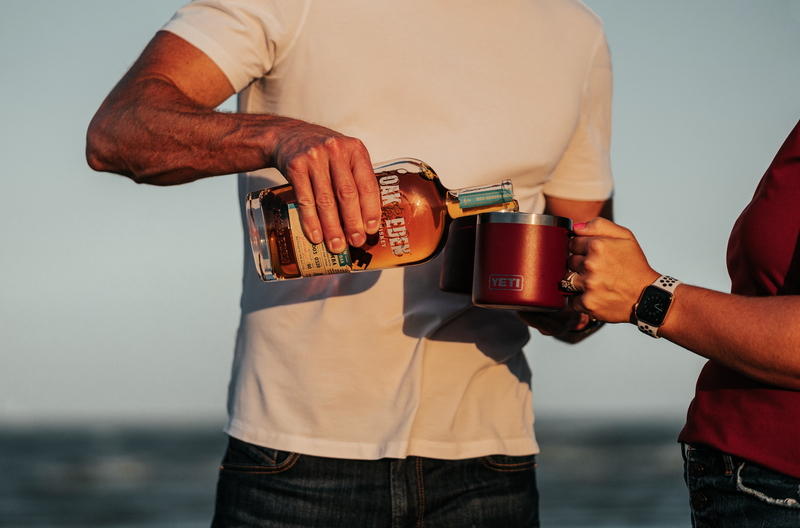
RUM VS. WHISKEY: WHAT YOU NEED TO KNOW
There are many liquors out there lining the shelves of bars, restaurants, and home bars around the world. While there are dozens of liquors to choose from, these five that rule the roost: vodka, gin, tequila, rum, and whiskey.
Vodka and gin serve as the clear spirits, tequila can be clear to pale amber, rum can be clear to dark brown, and then (of course) there’s whiskey, which always carries a golden amber to dark woody brown color.
As you might be able to tell, dark rum and whiskey carry different flavors than the clear spirits. So, what really is the difference between rum and whiskey? Here is a guide to help you keep them straight.
What Is Rum?
Let's set sail for the Caribbean to learn about one of its most famous exports: rum. This spiced spirit has been used to fuel many a pirate adventure, and it's no wonder why.
Rum is the perfect drink for a hot summer day, and it can be enjoyed in a wide variety of cocktails. Still, what exactly is rum?
Rum is a distilled spirit made from sugarcane juice or molasses. It gets its distinct flavor from the addition of spices like vanilla, cinnamon, and nutmeg. The best rums are aged in oak barrels, which gives them a smooth and mellow flavor.
Rum is typically drunk neat or on the rocks, but it can also be used in cocktails like the Piña Colada or the Mojito. So, the next time you're in the mood for something sweet and tropical, reach for a bottle of rum and raise a glass to the good life.
How Is Rum Made?
Here is a closer look at the rum-making process:
Step One: Harvesting Sugarcane
Sugarcane is harvested for rum production by cutting down the sugarcane and transporting it to a processing facility. The Caribbean is a popular area for sugarcane and rum production because of its warm climate and rich soil.
Step Two: Extracting Juice From Sugarcane
Sugarcane is then chopped up and crushed in order to extract the juice. Sugarcane juice contains a high concentration of sugar, which is necessary for the fermentation process.
If the sugar is not extracted from the sugarcane, the fermentation process will not yield the desired results.
Step Three: Fermenting the Juice
The next step in the rum-making process is fermentation. In order for fermentation to occur, the sugarcane juice is placed in a tank where it is mixed with yeast. The yeast breaks down the sugars in the juice and turns them into alcohol over the course of several days.
The fermentation process is relatively simple and only requires a few ingredients. First, the sugar cane juice is mixed with water and yeast. The mixture is then left to sit for a period of time, during which the yeast will consume the sugar and produce alcohol. Once the fermentation process is complete, the resulting liquid is known as wash.
The wash is more alcoholic but not as alcoholic as rum or other hard liquors. To get that higher proof, the fermented sugarcane juices have to be distilled.
Step Four: Distilling the Juice
The distillation process is an essential part of making rum, and it yields some pretty amazing results. There are two main methods of distillation: using a pot still and using a column still. For rummaging, pot stills are most common.
Using a pot still distillation method, first, you pour the fermented sugarcane juice into the pot still, which is then heated to boiling. The alcohol vapors boil before the water, meaning the vapor is more alcoholic than the liquid with fewer of the mash’s impurities and other ingredients.
The vapors are then collected and condensed into liquid again, where the process can be repeated until the rum is as pure as the distiller wants.
Step Five: Aging
Not all rum is aged. Clear rum is not aged at all and can be bottled right after distillation. Some dark rums are also not aged but instead have added colors, caramel, and spices which can change the colors and flavors.
Still, many darker rums are, well, dark because they have been aged in wooden barrels. When a liquor of any type is aged in wood, as the wood expands and contracts it pulls in and pushes out the liquid, imparting some of its natural botanicals, flavors, and colors.
Over time, the spirit absorbs the unique flavors of the wood, giving it a smooth, mellow taste.
The length of time that rum is aged also plays a role in its flavor. For example, light rums are typically aged for around one year, while dark rums may be aged for up to three years or more.
What Is Whiskey?
Whiskey is a distilled alcoholic beverage made from fermented grain mash. The grains used can include barley, rye, wheat, and corn. Whiskey is typically aged in wooden barrels, which give it its distinctive color and flavor.
The word "whiskey" comes from the Gaelic phrase uisce beatha, which means "water of life." Whiskey has been around for centuries, and its popularity has only grown over time. Today, there are many different kinds of whiskey to choose from, each with its own unique flavor profile.
In the United States, the most popular types of whiskey are bourbon and rye. Bourbon whiskey must be made in the United States and contain at least 51% corn. Rye, on the other hand, must contain at least 51% rye to be considered rye whiskey.
There are other requirements as well, including aging restrictions and minimums.
How Is Whiskey Made?
Whiskey is made using a very similar process to rum. The basic steps of harvesting, fermenting, distilling, and aging are almost identical.
The main difference is in the fermentation process for whiskey. Instead of crushing and juicing, the grains are milled and mixed with hot water to create a porridge type of mixture for fermentation. This process is more effective at relieving the sugary starches in the cereal grains so that the yeast can convert them to alcohol.
Beyond that, the process is quite similar to run — even down to pot distillation and aging. Most whiskeys have stricter aging requirements that they must follow, but the basic principle remains constant.
What Are the Differences Between Rum and Whiskey?
In summary here is a brief overview of the differences between rum and whiskey:
Main Ingredient: Rum is made from sugarcane, while whiskey is made from cereal grains including corn, wheat, rye, and barley.
Aging: All whiskey must be aged, but not all rum must be aged.
Color: Rum can be clear or dark. Meanwhile, whiskey is typically amber or brown.
Flavor: Rum is typically sweet, while whiskey is typically smokey or peaty.
Added Spices: While any rum can be spiced rum and contain added flavorings and spices, most whiskeys do not have flavor additives. In fact, many types of whiskey are prohibited from adding flavors.
So, there you have it! These are the basic differences between rum and whiskey.
What Are the Similarities Between Rum and Whiskey?
Even though rum and whiskey are made from different ingredients and have different flavor profiles, there are some similarities between the two.
Here is a closer look at a few of these similarities:
Distilled: Both rum and whiskey are distilled spirits. This means that after fermentation, the liquids are purified and the alcohol content is amplified. This is as different from beer and wine, which are fermented but not distilled.
Aged: While rum does not have to be aged, aged rum shares many similarities with whiskey. The aging process can be responsible for much of the flavor and color of a good rum or whiskey. The longer a liquor is aged, the darker it will be.
Wood Flavors: Because both dark rum and whiskey are aged in wooden barrels, they can share similar flavor profiles. All sorts of woods are known for giving a caramel and vanilla type of flavor to liquors that are aged in them.
Rum vs. Whiskey: Takeaways
Whiskey is a distilled alcoholic beverage made from fermented grain mash. The most common grains used are barley, rye, wheat, and corn. Whiskey is typically aged in wooden barrels, which contributes to its flavor and color. The United States produces the most whiskey in the world, followed by Ireland and Scotland.
There are many different types of whiskey, each with its own unique flavor profile. The two most popular types of whiskey in the United States are bourbon and rye. Bourbon must be made in the United States and must contain at least 51% corn. Rye must contain at least 51% rye. Other requirements for both include aging restrictions and minimums.
The main difference between rum and whiskey is in the fermentation process. Rum is made from sugarcane, while whiskey is made from cereal grains including corn, wheat, rye, barley, and others.
Rum can be clear or dark, while whiskey is typically amber or brown in color. The flavor of rum is typically sweet, while the flavor of whiskey is smoky or peaty.
If you are a rum drinker, then whiskey might be more up your alley than you think. Give Oak & Eden whiskey a try, and you may find a whiskey you like better than rum.
You can also check out our Infused series for our rum-infused whiskey, the Rye and Rumba.
We've got whiskey that you’re bound to love… So, what are you waiting for?
Sources
What's the Difference Between Bourbon and Whiskey? | Food & Wine
What Is the Effect of Aging on Liquor? | The Spruce Eats
Coffey still | Whisky Advocate
READ THE STORY
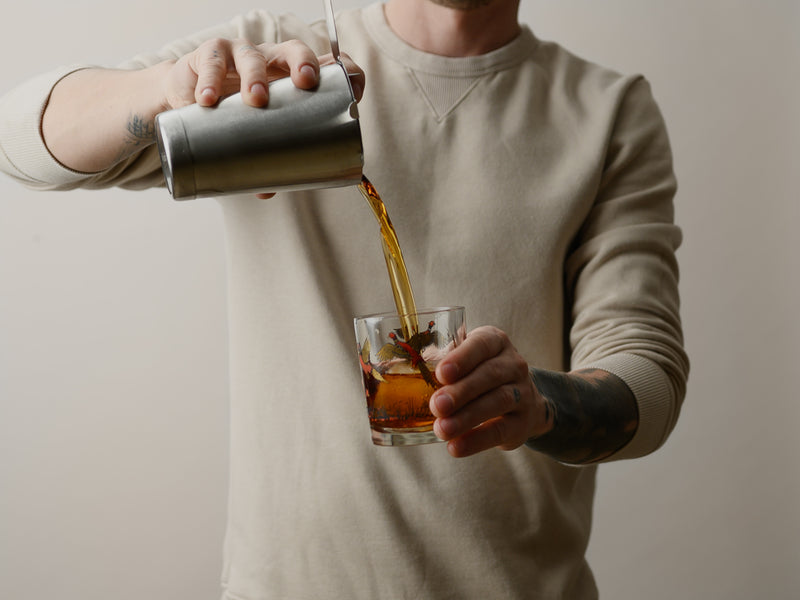
HOME BAR SETUP: THE COMPLETE GUIDE
Everyone enjoys a delicious cocktail when they go out. There’s something special about an expertly crafted cocktail made with fresh ingredients and creative liquors, liqueurs, fruit juices, herbs, mixers, and more. Of course, these delicious and yummy drinks come at a cost — literally.
When you go out to the bar, you can easily end up spending fifteen to twenty dollars on any good cocktail that isn’t just a shot of well liquor mixed with a shelf-stable margarita mix. Making drinks at home can be cheaper and just as delicious, especially if you can perfect your setup.
Without a stocked home bar, you might find yourself going back time and time again to the same old boring drinks, having your favorite beer or wine every night, and never really branching out. A thought-out home bar can shake up your evening routine, so every night feels like a night out.
Getting your home bar set up nicely takes just a little bit of effort at the beginning. Once it’s ready, upkeep is easy — just replace any bottles and ingredients you use up! To help you get your home bar set up just how you like it, we’ve put together the complete guide for a home bar setup you will love.
What Are Home Bar Essentials?
There are a few different categories of essential bar tools, glassware, garnishes, and more that we need to assemble the ultimate bar and boost your mixology skills.
A Bar Cart - You can’t have an at-home bar without a bar area. This doesn’t necessarily mean buying a bar cart if you have a built-in bar already or have repurposed a bookshelf into a bar area. If your space is slightly smaller, a bar cart is an easy way to keep your essential bar items together.
Bartending Tools - It’s impossible to make full use of your home bar without the proper tools. You’re going to need a cocktail shaker, tongs, ice, a jigger, a citrus juicer, a knife, a peeler, a cutting board, a muddler, and a cocktail strainer to make any drink you could imagine.
Mixers - While the Long Island Iced Tea is a special drink that has its merits, most other cocktails require some non-alcoholic components. Most importantly, you have your simple syrup, but you should also have a variety of fruit juices on hand for mixing. Fresh is always best, so consider stocking fruits you can juice yourself when inspiration strikes. A skilled mixologist keeps Angostura orange bitters, tonic water, and other essential mixers nearby, along with a bar spoon and cocktail shaker in the bar cabinet.
Glassware - No wet bar is complete without rocks glasses, wine glasses, highball glasses, and other essential barware.
A Cocktail Book - Everyone needs to know how to make classic cocktail recipes like the Manhattan, old fashioned, Mojito, and more. Plus, it’s helpful to get a general sense of how to use unique ingredients like vermouth, Campari, or white rum to make your own great cocktails at home. A cocktail book can give you all that knowledge and more.
Alcohol - Last but not least, a home bar could not be complete without alcohol. You should start with a bottle of each of the five cardinal liquors and branch out from there.
Together, these four components make up the essential at-home bar. Now, we’re going to take a closer look into each area with tips and tricks to get the best home bar setup imaginable.
What Should I Look for in a Bar Cart?
Like we said earlier, you don’t need to go out and purchase some crazy expensive bar cart — all you need is a dedicated area to store your bottles and equipment where you can mix your drinks with ease.
If you have some counter space that you can dedicate to mixing drinks or shelves nearby to store ingredients, then you are set. However, if you are quite serious about your cocktails, having a dedicated bar cart can be a nice addition to your living room, kitchen, or wherever you decide to put it.
For a perfect at-home bar cart, look for something with wheels that lock to avoid your cart running away without you. Other than that, there are bar carts available for any need, any style, and any budget.
What Bartending Tools Do You Need?
We gave a brief list of bartending tools that you should have for your at-home bar, but without any explanation, this list may have just sparked more questions rather than answers. You should start with a nice cocktail shaker that you trust (Boston shakers or cobbler shakers are both fine).
Most cocktails you meet will be shaken, but stirred drinks can be mixed in the cup you are serving in or a mixing glass.
Next, you are going to need a jigger. A jigger is a bartending measuring device. They are equipped with two sides that are each a measure: one ounce and 1.5 or two ounces. They also have lines to show different measures for mixing. You should at least choose a jigger with measure markings at the half, one, and 1.5-ounce line for ease of use.
A cocktail strainer is an optional choice for many drinkers. For the ideal smooth drink, it really does come in handy. Having both a fine mesh strainer and Hawthorne strainer can be smart but a fine mesh strainer alone is enough as well. If you are serving fresh juice, then a citrus hand juicer, a knife, and a cutting board are going to be essential as well.
Lastly, bobbles like ice, straws, cups, tongs, a muddler, and a peeler can come in handy. Ice is a necessity as well as cups. Everything else is optional, so long as you are willing to make do with what you have.
What Mixers Do You Need for a Home Bar Setup?
There are a few delicious cocktails out there that call for only alcoholic ingredients, but most drinks will call for some sort of mixer. Most important amongst the group is your simple syrup.
You can make your own simple syrup by combining equal parts water and granulated sugar and heating until it is completely dissolved. Then, take it off the heat and let it cool. You can also buy simple syrup in-store!
Citrus juices are an important addition to any bar setup, whether you squeeze fresh juice or buy it bottled. If you’re someone who likes White Russians, then consider adding heavy cream to your mixer list, as well as tomato juice for Bloody Mary drinkers.
What Alcohols Do I Need for a Home Bar Setup?
Finally, on to the most important topic of discussion: Which bottles of alcohol do you need to set up a successful home bar?
For starters, you’ll need the five cardinal liquors: whiskey, gin, vodka, tequila, and rum. These five liquors stand apart as the most commonly used liquors in cocktails. With them at your disposal, you can make next to anything.
Choosing the right brands is also important for your home bar setup. While you can save money with bottom-shelf liquor, your cocktail quality will suffer. While buying nice liquor can be an upfront cost, buying by the bottle saves you tons over what you would pay during a night out.
You should aim for bottles that are of high quality but aren’t so expensive that you’re going to be hesitant to drink them. There is certainly room for a few incredibly expensive bottles on your bar, they shouldn’t make up your staples.
Oak and Eden Whiskey is the perfect whiskey for every at-home bar. Our whiskeys are all expertly crafted and delicious enough to drink neat, but they aren’t so expensive that you’ll be tortured pouring them into mixers. Oak and Eden whiskey is made with our distinct in-bottle finishing technique, giving our whiskeys a unique flavor you won’t find anywhere else.
Other important bottles to consider are a few of your favorite aperitifs, liqueurs, and flavored liquors for cocktails.
Feel free to start with only the ingredients you need for one of two simple cocktails, like a bottle of Oak and Eden, lemon juice, simple syrup, and some bitters. Then, slowly add bottles to your bar as your budget allows — low pressure, high reward, lots of fun.
Home Bar Setup Takeaways
Enjoying delicious cocktails doesn’t have to be a 20-dollar experience that you only get when you go out. Enjoying cocktails at home is cost-effective and just as good (if not better) than what you can get from bartenders during a night on the town. The key is creating a well-stocked home bar setup.
No at-home bar is complete without a bottle of Oak and Eden. Our whiskeys are all expertly made to give you a whiskey experience that you won’t forget. Whether you prefer bourbon, rye, or wheat whiskey, we have a bottle that you are going to love.
Now sit back, relax, and enjoy a delicious bourbon cocktail right in the comfort of your own living room. It’s really as simple as that.
Sources
Cocktail Science: 8 Tips and Tricks For Getting the Most Out of Citrus | The Spruce Eats
Essential Liquors and Mixers to Stock in Your Home Bar | The Spruce Eats
Shaken, not stirred | Feature | Chemistry World
READ THE STORY
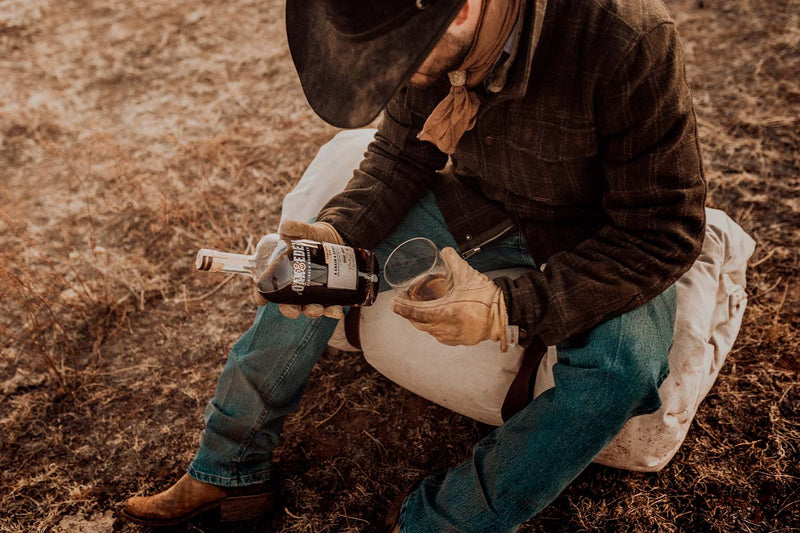
WHISKEY FATHERS DAY GIFT: 6 EXCITING IDEAS
There’s no role model in a person’s life quite like their father. In a world that’s constantly changing, fathers stand as a model for steadfastness, courage, determination, and hard work. It is because of the great examples of the fathers that came before us that we are where we are today, and because of that, we should show them how much we care.
Father’s Day is a holiday like no other, giving everyone the chance to show their father how much they have meant to them. Still, Father’s Day can also be a tricky holiday, particularly if you aren’t fond of gift-giving.
Getting your father a gift he will love that tells him you care is difficult, especially if you have a father who tends to just go buy the things he wants for himself.
If there is one thing that most fathers love, it’s whiskey — and the great thing about whiskey is you can always use more. There are also plenty of other whisky-related gift ideas that can tell your father how special he is and give you the opportunity to bond over a glass.
No more scrambling at the last minute for a Father’s Day gift idea. Here are six exciting whiskey gift ideas for your dad this Father’s Day
#1) A New Cocktail Shaker
If your father is someone who prefers his whiskey in a Whiskey Sour or Mint Julep, then a new cocktail shaker will be a wonderful gift for him. For shaken cocktails, having the right type of shaker makes all the difference in achieving the proper dilution and texture in your drink.
There are all sorts of shakers out there, but they mainly fall into two main categories: the Boston shaker and the Cobbler shaker. You should figure out your dad’s preference before diving in because some people have very strong opinions about which style is “better.”
If you want to make this gift truly special, consider shopping through a service that can offer an engraved shaker with a Father’s Day message he will read every time he shakes up a drink. You could also go for a themed shaker that celebrates a hobby, interest, or theme in your father’s life.
#2) Customized Old Fashioned Glasses
Whether your father drinks his whiskey straight or in cocktails, he needs an Old Fashioned glass. The feeling of a high-quality piece of drinkware in your hand as you sip a delicious whiskey cocktail can elevate your drinking experience quickly.
Consider getting your father a customized set of Old Fashioned glasses for his bar. Think about his interests and hobbies. For instance, if he likes sports, consider getting him glasses themed after his favorite team. If he loves to travel, maybe get him a few glasses themed after his favorite destinations.
Get creative, because a custom Old Fashioned glass is something your dad will actually use all the time. If you gift him a basic, boring, or low-quality piece of drinkware, he won't actually get much use out of it. If you are going for a glassware present, you need to make it special so that it doesn’t end up at the back of a drawer somewhere for all of eternity.
#3) A Nice Bottle of Whiskey
At the end of the day, a bottle of whiskey is still one of the best and easiest gifts that you can give to your father on Father’s Day. The best part is that your father is going to love it. Whiskey, like a father, grows better with age — what better gift could there be?
If you’re searching for a bottle to give your father for Father’s Day, Oak & Eden has the perfect selection for you to choose from. Starting with our classic Inspired Series Whiskeys, you have the choice between expertly crafted bourbon, rye, wheat, and four-grain whiskeys. No matter your father’s taste, we have a traditional blend right up his alley.
If your father is of the more adventurous type, then he may be more intrigued by the offerings in our Infused Series of whiskeys, featuring intense and inventive flavors. From our Bourbon & Brew coffee-infused whiskey to our Rye & Rumba Caribbean rum-infused rye whiskey, we’ve got options that will pack a flavor punch your dad will love.
Of course, all of our whiskeys use innovative in-bottle finishing techniques. We place a hand-toasted wooden spire in every bottle of our whiskey to continue infusing botanicals and flavor notes into your whiskey while it sits on your shelf. Your father is going to love Oak & Eden.
#4) Whiskey Tumblers or a Whiskey Flight Set
If your father is more of a whiskey connoisseur, then getting your dad his very own set of whiskey tumblers to serve flights of whiskey is a thoughtful Father’s Day gift.
Whiskey tumblers (sometimes called Glencairn glasses) are the small glasses that whiskey is served in when you are tasting it. A Glencairn glass has a wide base and a taller, slimmer body and lip that’s almost shaped like a tulip. These glasses help concentrate the aromas of the whiskey upwards to your nose and make whiskey more fragrant (and easier to taste).
#5) Ice Ball Molds
One thing that usually separates homemade cocktails from the delicious (and expensive) cocktails that you get when you go out is the ice. Oftentimes, you find at bars the ice in your cocktails — especially your whiskey — are these large single perfect cubes of ice. Other times, you get even more inventive single giant chunks of ice, like circular ice cubes.
Making these kinds of decorative giant ice cubes for serving cocktails and whiskey is more than doable from the comfort of your home: All it takes is a simple silicone ice mold. You can get creative shapes like balls, which tend to look cool. There are also cubes, pyramids, and other fun and wacky shapes that you can try out.
If your father is someone who likes to host cocktail parties or make cocktails for friends, then ice cube molds (spherical or otherwise) can take his presentation skills to a whole new level.
#6) Oak & Eden Anthro Series Whiskey
The final great gift idea that any father will be excited about receiving this fathers day is a bottle of any of our Oak & Eden Anthro Series whiskeys. Our Anthro Series of whiskeys are crafted in collaboration with popular ramblers and creators to showcase unique and interesting flavor profiles.
With blends and recipes blended in collaboration with such celebrities as prolific western actor Forrie J. Smith’s barrel proof bourbon with coffee-infused American oak spire to Americana duet Jamestown Revival’s blend of barrel proof rye whiskey with a toasted french oak spire, the Anthro series are top of the line, flavorful, and creative blends that your father will get a real kick out of.
The Antro Series of Oak & Eden whiskey is a celebration of individualism and the unique approaches that make each of us one of a kind. Give your one-of-a-kind father a bottle of our Anthro Series whiskey to show him just how special he is to you.
Takeaways
Father’s day is the perfect time of year to show your father how much his support and care have meant to you. Giving him the perfect gift is the best way to show you care. But shopping for a Father’s Day gift gets challenging year after year. How do you find something he’ll love that represents his worth to you?
If you have a father who likes whiskey, then you have a great solution. There are truly dozens of great gift ideas for anyone who loves whiskey, including fathers. The key is of course finding the gifts that will actually make a difference.
A new cocktail shaker is a solid option for dads who enjoy shaken cocktails. Some customized or special cocktail glasses are also always smart.
Oak & Eden whiskeys also make an ideal present for any father, showcasing the brilliant flavors of American-made whiskey while also presenting first-of-its-kind in-bottle finishing to give your father a whiskey that is layered and complex like him.
Whiskey tumblers or a set of flight glasses is a good gift for the whiskey connoisseur fathers out there, and creative and fun-shaped ice cube trays are a smart present idea for dads who like to serve nice drinks.
Whatever you decide to give your father this year, make sure he knows how much he means to you. Sometimes, all that takes is two glasses, a bottle of whiskey, and a little quality time.
Sources:
In Defense of the Cobbler Shaker | PUNCH
7 types of glasses to enjoy scotch, whisky and bourbon | Architectural Digest India
What is an Old Fashioned Glass? | Thrillist
READ THE STORY
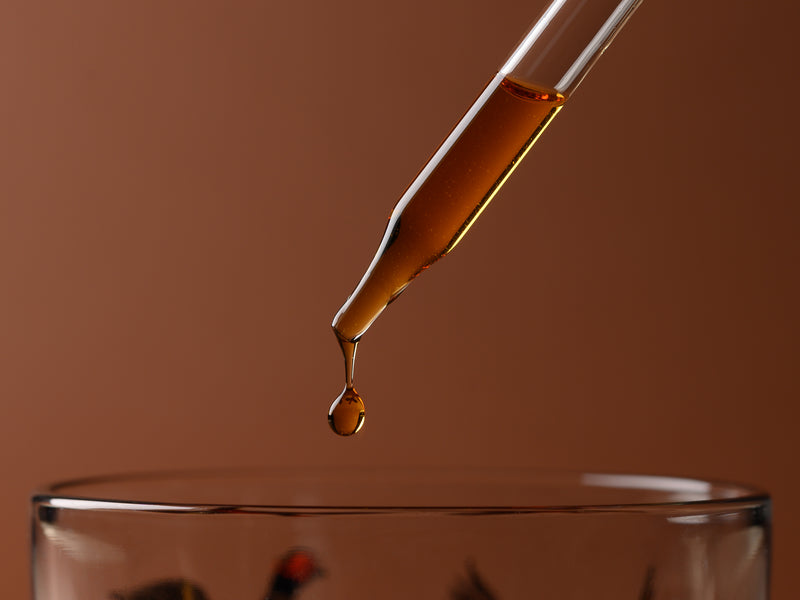
HOW TO STOCK A HOME BAR
Not everyone is a cocktail or hard liquor person. Believe it or not, there are plenty of people out there who would much rather drink beer and wine forever rather than experiment with the delicious flavors, mixtures, and elements of spirits and mixed drinks.
For those individuals, life is incredibly easy. At every party, every restaurant, every picnic, every fishing trip, and every family reunion, they know that they will have their drink of choice on offer. If you’re a spirit lover, well, you may need to do some advance planning to ensure your drink of choice is on hand.
Enter: the home bar. Having a home bar was once an essential aspect of entertaining, allowing you to pour drinks for visitors at a moment's notice. As time has gone on and beer and wine have grown more commercially available, home drinking habits have changed.
When you have a home bar, you are able to easily prepare hundreds of craft drinks from home at a fraction of the price you’d pay at a bar. Imagine how much better your drinks could be at home for guests and for yourself!
Here’s a starter guide to stocking your home bar so that everyone can have a drink that they love, quickly and easily.
What Are Home Bar Essentials?
There are many items you’ll need to complete your home bar so that you can make any drink you could dream about. These include tools and equipment, mixers, alcoholic ingredients, and bottles of spirits. Together, these elements make up your home bar.
Keep in mind that you don’t need to start your home bar off right away with everything in the entire world. Trying to cover all of your bases at once can be a big (and expensive) project. Instead, make sure that you start off with the essentials for a few drinks that you like
You can slowly expand outward from there as you see how fun mixing drinks can be. This will give you access to what you like first on an affordable basis while leaving you room to complete your bar over time.
Let’s take a closer look at these primary categories and what you need to make your home bar functional.
What Are Essential Home Bar Tools and Equipment?
While you can have a home bar that is simply glasses and bottles of liquor, you’d miss out on the joys of mixed drinks. In order to make drinks in a sanitary, fun, and safe way you’re going to need the right tools and equipment.
Your most important element is a cocktail shaker. Not every cocktail is shaken — some are simply stirred — but some cocktails need that shake to develop the right texture and dilution.
There are two types of shakers that you’ll see most commonly: cobbler shakers and Boston shakers. Some people have strong opinions about which is better, but whichever you find easiest and most enjoyable to use will be the best choice for you.
You should also have a jigger, a specialized measuring tool for bartending. A jigger is a double-sided measuring cup, with one side measuring an ounce and the other two ounces of one and a half ounces (depending on the style and manufacturer).
You don’t need to have a jigger specifically, but you should have measuring devices that can measure half, quarter, three-quarter, and ounce liquid measurements.
On top of this, it’s helpful to have a citrus juicer if you plan to juice fruits fresh for mixed drinks. A cutting board and knife can also be juicing essentials.
Ice is a must-have, and you’ll want several different-sized glasses. While you don’t need to have a set of bar glasses with every shaped cocktail glass, it can be fun to up your presentation — but any cups will do.
What Are Essential Home Bar Mixers?
Now that you have the equipment you need for your home bar, it’s time to add mixers. While there are plenty of delicious cocktails that are made without mixers — and you can always enjoy nice liquor on the rocks — most cocktails are going to require some sort of non-alcoholic ingredient, known as a mixer.
The most important of these non-alcoholic ingredients is simple syrup, a one-to-one syrup of sugar to water. You can make this at home or purchase a store-bought variety, but simple syrup is going to be used in most cocktails you mix up as a sweetener.
You should also prepare to go through a lot of citrus juices. Squeezing your lemons and limes fresh for every drink is ideal but a lot of effort. Still, if you are going to buy a bottle at least be sure to get a high-quality, natural lemon or lime juice. It’ll make a big difference!
Beyond those basics, the only mixers you need to have at your bar are the ones you need to make the drinks you like the most. The more extensive your mixers are the more creative your drinks can be, but oftentimes the classic mixers have become classic because they taste the best when mixed with alcohol. It can be as simple as that for a delicious cocktail.
What Bottles Do I Need to Stock My Home Bar?
The final question left to answer for your home bar is which bottles of liquor and alcohol you need to have a stocked home bar. For the most basic beginning setup, your bar should include at least three or four of the five most popular liquors: vodka, gin, rum, tequila, and whiskey.
With one bottle of a nice (but not super expensive) bottle of each, you have the ingredients necessary to make many of the classics.
If you’re looking for a delicious whiskey to stock your home bar with, Oak & Eden should be the first place you look. Our Inspired Series of whiskies is a collection of classic whiskies from bourbon to rye and even four-grain whiskey — with a twist.
Oak & Eden uses first-in-the-industry technology through our in-bottle finishing technique in every bottle of whiskey. Each bottle contains a Spire, a specially selected and toasted spiral cut piece of wood that finishes the whiskey in the bottle, adding flavors and notes to your whiskey. Any of our Inspired Series whiskies will make a wonderful addition to your home bar.
Beyond basic liquors, some popular liquors and other alcoholic ingredients to grab include bitters, sweet and dry vermouth, Aperol, curacao, a triple sec, and whatever else you like to drink. Think: flavored liquors and all sorts of schnapps and liqueurs.
At the end of the day, your home bar should cater to your personal tastes and the general tastes of the public. When you are first starting out, it is okay to have a limited bar selection. As you continue to invest in expanding your home bar you’ll have more options to experiment. It can be expensive all at once, there’s nothing wrong with starting off small.
Takeaways
If you want to enjoy delicious cocktails and liquor straight or on the rocks at home, then a home bar is the right move for you. If you want to start a home bar, however, you may have a lot of confusion about how to get yourself started.
Getting your home bar started and stocked is simple, all you need to do is gather three things: your equipment, your mixers, and your bottles. If you get all three of these set up to your liking, you have a functional home bar.
Make sure you have the essential equipment like a cocktail shaker and jigger, as well as a juicer for citrus and a cutting board. You’re also going to need to get the essential mixers, like simple syrup as well as lemon and lime juice. Beyond that, consider anything non-alcoholic that you might like to put in a cocktail as a potential candidate to stock for your bar.
Finally, bottles of alcohol should start with a few of the five cardinal liquors - vodka, gin, rum, whiskey, and tequila. A delicious whiskey option for your home bar is our Oak & Eden Inspired Series of whiskies. Whether you prefer bourbon, rye, wheat, or four grain as your go-to whiskey, we have options that you will love on their own or in a cocktail.
Stocking your home bar doesn’t have to be complicated, and it doesn’t have to be expensive or overwhelming. Start small with the ingredients for a few drinks you like, and slowly expand your bar outward. Cheers!
Sources
Cocktail Science: 8 Tips and Tricks For Getting the Most Out of Citrus | The Spruce Eats
Essential Liquors and Mixers to Stock in Your Home Bar | The Spruce Eats
Shaken, not stirred | Feature | Chemistry World
READ THE STORY
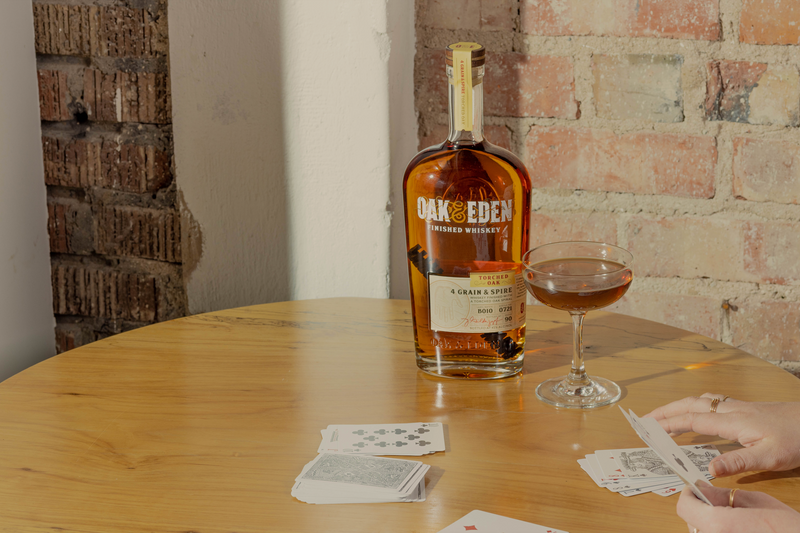
COCKTAIL PARTY AT HOME: 7 THINGS YOU SHOULD KNOW
Throwing a great cocktail party is a delicate (and fun) balance. Semi-casual mixers thrown at friends’ homes are a wonderful opportunity to mingle with pals old and new for a good time, no matter the time of year or occasion.
If your only exposure to cocktail parties has been work functions that are less than fun, allow us to open your mind to everything a cocktail party has to offer. A well-thrown cocktail party can help you meet new people, make stronger connections with friends, and enjoy some delicious homemade cocktails.
Cocktail parties have been around for decades, and for good reason — they’re a blast!
Hosting a fun cocktail party that you and your guests love is easier than you may think. As long as you’re ready to do your research, you can make your cocktail party a major success.
This guide of helpful tips and must-know information will give you all the answers you need to plan your next cocktail party with ease.
1. Plan Your Invite List
The first step of throwing a cocktail party at home is understanding the importance of the perfect group. If you have too many or too few guests at your cocktail party, it could throw off the group dynamic.
With fewer than five guests at your cocktail party, it will feel like more of a cocktail hangout. Any more than 15 people, and you’re getting closer to a regular party where mingling can become challenging across circles.
You should aim for a group size of around ten to promote conversation and sidebars while providing enough entertainment for the entire evening.
2. Choose Your Cocktails
Another crucial consideration is which cocktails you plan to serve throughout the evening. You want to offer drinks that are fun, unique, and familiar. Striking the perfect balance can be a blast if you’re up to the challenge.
You should always make sure to serve something simple like an Old Fashioned or a Manhattan that most everyone will know (and like). Oak & Eden whiskeys are a tasty choice for any classic or adventurous whiskey drink. Our whiskeys are smooth and flavorful while still being approachable, subtle, and delicious straight or in a mixed drink.
Plan for just two or three cocktails to make life easier for yourself as a host, but try and offer at least two different types of liquor. You should also serve some wine and beer for any guests who prefer other alcoholic drinks.
Of course, don't forget guests who may not want to drink! Having a non-alcoholic drink or cocktail on offer for them can be a thoughtful way to keep them involved in the action.
3. Serve Up Appetizers and Snacks
Just as important as your drinks are your appetizers, snacks, and other food offerings. You aren’t expected to serve a full dinner or even a substantial food spread, but it’s always nice to have finger foods for guests to munch on.
The key is picking foods that are easy to eat, small enough to serve in one to three-bite portions, and pair nicely with the cocktails you’re serving. You should also try to serve foods that won’t make anyone’s breath smell, as cocktail parties are mainly about talking to other people.
To keep things simple, one homemade appetizer is more than enough. Then, offer a cheese board of some sort and perhaps a few store-bought snacks like a veggie spread or a bowl of nuts.
As long as your food is yummy, your guests will be happy.
4. Pre-Batch Your Cocktails
Another planning secret that can make cocktail parties so much easier is to pre-batch your cocktails before your party. When you’ve got house cocktails on offer, you're going to have a lot of drinks to mix. If you don’t want to be stuck behind the bar all night, you’re going to need an inventive solution.
The best way around this issue is to pre-batch your cocktails so that they are easier to serve. Batching cocktails involves scaling up the recipe and mixing some beforehand. This way, it can be easy to pour, stir/shake, and serve instead of building drinks from scratch all night.
You can even just put out your cocktails premixed in a pitcher or punch bowl with glasses and ice as another option to simplify your evening.
5. Decorate Your Space
You can’t have a great cocktail party without a little bit of decoration thrown into the mix. Whether you are hosting a cocktail party to celebrate an anniversary, birthday, milestone, or holiday or you’re just feeling inspired, putting extra thought into the decorations at your party can provide a sense of festivity.
For birthdays, you should focus on decorations centered around the honoree. For holidays, decorating in the theme of the season can add a fun and festive element. You can even theme your cocktail offerings if you want to go the extra mile.
6. Plan Some Games
Even the best cocktail parties can have a pause in the conversation or a moment where the energy dips. Having a few games in your back pocket can help revitalize your cocktail party and bring the fun to a new level. Not all party games are created equal, however, and having the right games can make or break your evening.
Murder mysteries were a hit in the nineties and are coming back around as a trend now. These can be super fun for cocktail parties and help get people mingling.
If you’re just trying to break the ice for a cocktail party with guests who are meeting for the first time, then getting to know your style games like two Truths and a Lie or Never Have I Ever can be fun ways to get the party started, too. As long as you have two or three games ready, then you should be good to go.
7. Don’t Neglect the Music
The final piece of must-know information to help you throw the perfect cocktail party at home is to be sure you aren’t forgetting about music. Every restaurant or bar you go to has music in the background — it helps cut awkward dead noise that can kill conversation.
Be sure to curate a playlist themed around the party, the holiday, the theme, or just music that you and your guests enjoy and can listen to passively in the background. You want your music to be fun but not distracting or so loud that it limits your ability to hear each other. Think of it as an accompaniment to your conversation when selecting songs.
Cocktail Party at Home: Takeaways
Throwing a cocktail party at home can be a super fun way to get to know your friends and mingle with new people.
Start by inviting the ideal number of guests so that you have enough people for fun but not too many to cause chaos. You should also plan out cocktails you plan to serve in advance.
Oak & Eden whiskey is a great choice for your cocktails, for its smooth taste and robust flavors. Oak & Eden whiskey is made with our first in its industry in-bottle finishing technique, which allows our whiskey to continue developing and improving its flavors while it sits in the bottle.
Make sure you have planned some food for your party as well. If you want to enjoy your party yourself, pre-batch your drinks so you have time to spend with your loved ones. Decorate for your cocktail party to set the mood and try and have a couple of games ready to go in case there is a lull in the conversation or you need an icebreaker.
Last but not least, think about your music choice. If you can do these three things, then you are ready to throw the best cocktail party possible. Cheers!
Sources
How to Batch Cocktails for a Crowd | Serious Eats
Cocktail History in America: The Age of Entertaining (1933-1980s) | Virginia Tech
Cocktail Party Hosting Tips, Food and Drink Menu Ideas | The Spruce Eats
READ THE STORY
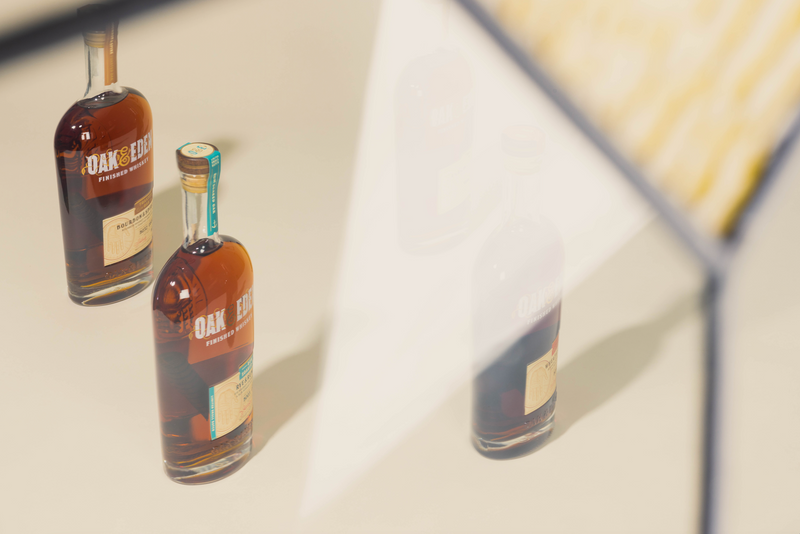
HOW TO STORE BOURBON: A COMPLETE GUIDE
Every bourbon lover knows that there is no such thing as too many bottles in your home bar. Each bottle of bourbon brings its distiller's unique take on an American classic, revealing flavors, notes, and depths that are hard to beat.
However, there is one problem that arises when you’ve got a bourbon collection: How are you supposed to store it all?
You can leave your bottles lying around, but that’s just not always the smartest move—- especially if you want your bourbon to retain its flavor as you’re storing it.
We’re here to help you take the guesswork out of storing your bourbon collection. Here is Oak and Eden’s complete guide to storing bourbon at home.
Why Store Bourbon Properly?
Before we dive into the best practices for storing your whisky properly, you may be wondering what the big deal is about storing your bourbon anyway. After all, what’s the worst that could happen? Well as it turns out, there are some less-than-ideal consequences.
When your bourbon is stored improperly, you can damage the flavors and tasting notes that the distiller worked so carefully to impart to the drink. It will decrease the shelf-life of your whiskey, can make your bourbon harsher, release unpleasant flavors, and ruin a bottle of whiskey before you even get the chance to open it.
Whether you have open bottles that you want to preserve as long as possible or special bottles you are saving for a day in the future, storing your bourbon properly is the only way to guarantee a delicious product when you pour yourself a drink.
What Are Bourbon Storage Best Practices for Opened Bottles?
Now, let’s get into the main event: storage best practices. First, you need to know what to do with your opened bottles sitting around on your shelf.
#1) Store Them Away From Light
The first practice to follow when storing your open bottles of bourbon is to store them away from light, especially direct sunlight. In fact, according to some whiskey connoisseurs, direct sunlight is the only factor that can ruin a bottle of whiskey.
This is because of the sun's UV rays, the same rays that are responsible for causing sunburn and skin cancer in humans. These UV rays cause a chemical reaction in your whiskey which can lead to the color washing out, the flavors diminishing, and stripping the whiskey of the notes and depth that took years to develop.
While you don’t have to store open bottles in a dark cavern or in a cupboard (although those are both fine ideas), you should do your best to make sure your bar or wherever they are stored is not getting direct sunlight.
#2) Limit Oxygen Exposure
As soon as you open a bottle of bourbon (or any other type of whiskey or alcohol for that matter), you’ve started the ticking clock towards expiration. A big culprit of this is exposure to oxygen.
When your bourbon is exposed to the oxygen in the air, it will quickly begin the process of oxidation, causing unpleasant changes to your whiskey over time. There are three things that you can do to limit the oxygen exposure that any open bottles of bourbon get:
Limit the Number of Open Bottles: By limiting the number of open bottles you have, you decrease the amount of whiskey actively oxidizing. Try limiting yourself to two open bottles of bourbon at a time to keep your whiskey fresh and help it reach its full shelf-life.
Keep Bottles Sealed: You must make sure you put the cap or cork back on your bottle every time you pour. While brief periods of time with the cap off will not impact your whiskey too much, leaving the cap off for days, weeks, or months is a surefire way to oxidize a bourbon.
Pour Into Smaller Bottles: The final tip that you can use to limit your bourbon's oxygen exposure is to pour them into smaller bottles. As you drink your whiskey, the headspace (AKA, room for air in the bottle) increases. By continuing to pour your bottles into smaller vessels with less headroom you can get more life out of your whiskey.
#3) Store Bottles Upright
While wine is typically stored horizontally to keep the cork moist to prevent degradation, bourbon’s higher alcohol contact will actually cause the cork to degrade faster if it is in constant contact with the liquid. Keep your bottles upright to avoid issues.
#4) Maintain Consistent Temperature
The final piece of advice for your open bottles of whiskey is to maintain the temperature in your storage area. Keeping your whisky between 60 and 70 degrees Fahrenheit is an ideal range that will maintain the flavors of the whiskey over time.
What Are Bourbon Storage Best Practices for Unopened Bottles?
While the basic rules of bourbon storage still apply to unopened bottles (no sunlight, limit oxygen, store standing upright, consistent temperature), there are also some other options for the unopened, full, and sealed bottles in your collection.
Create a Display
If you have an extensive collection of bourbon whiskey or other kinds of whiskey, you may want to show it off. Having a display cabinet of some sort or even setting up a display at your home bar can let you show the world your love for bourbon while also keeping your bourbon in perfect condition.
If you are going to use lighting in your bar or storage display make sure you are using museum-grade lighting which won’t expose the liquid to UV rays or raise the temperature to an unsafe degree.
Keep in mind that bottles on display will collect dust, so you’ll need to clean them regularly and rotate them to prevent buildup.
Long-Term Storage
For your special bottles of bourbon — the ones that you are hanging on to for the long haul — you may want to find a more permanent storage solution that will preserve the bottle exactly as it was meant to be drank.
If you have a safe or vault, then you may want to store your expensive bourbons there. Not only will your vault or safe provide a dark place to store your bourbons, but it’s also a secure place to protect these valuable bourbons. As any serious collector of bourbon can tell you, the most expensive bottles in a collection can easily total into the tens or even hundreds of thousands of dollars.
Also be sure that you are storing your nice and unopened bourbon whiskey carefully to prevent damaging or tearing the labels, bottles, caps, boxes, or sleeves they came in. Just like any other collector, keeping your collection in mint condition is critical for preserving its value.
Use Off-Site Storage
If you don’t have a safe or vault, you don’t have the space for your collection at home, or you’re unable to provide a safe storage environment for your bourbon at home, then commercial and off-site storage services may be a wise option for you.
Make sure you are choosing off-site storage that is secure and temperature regulated to prevent spoiling your special bottles while they sit. Of course, you will also have to keep a close eye on your inventory and the security of the facility.
It is smart to check in every month or two to check your bottles in storage and keep a tight inventory so that missing bottles can be reported.
What Should I Do With Nearly-Empty Bottles?
While these storage tips can help you avoid wasting whiskey in the future, if you’ve already got open bottles that have been sitting around in less than ideal storage conditions (or lots of bottles near empty and no idea what to do with them), we’ve got some ideas for you, too.
If your whiskey is starting to go bad, the best solution is to finish the bottle quickly before it gets too bad. As long as you kill a bottle of whiskey that you open within about six months from opening you can be sure you’re going to get good flavor.
Consider hosting a dregs party, where you invite your guests to bring their nearly empty bottles to the party and you make the most of what you have to get rid of your scraps. This is particularly smart if you have a lot of open bottles that you can’t get through on your own.
Another fun option you can try is mixing the dramas of all your open bourbon bottles in a mason jar, decanter, or empty bottle. You should let the different bourbons meld and blend for a few weeks before tasting, and you can keep mixing and blending until you’re happy with your mixture.
Alternatively, you can keep adding the drams of future bottles as you slowly go through the drams to create an ever-evolving, home blend that is unique every time you drink it.
Basically, whatever you can do to not waste your bourbon whiskey is what you should be doing. Whiskey — even bad whiskey — is too good to let it go to waste.
Takeaways
Your bourbon is a precious commodity. You have to store it properly in order to preserve its freshness, flavor, and quality.
Be sure you are keeping all bottles of bourbon away from direct sunlight, where UV rays can cause chemical changes that diminish the flavor of your whiskey. Also be sure to keep bottles sealed when not in use, and limit their oxygen exposure to decrease oxidation.
Store bourbon in the upright position to keep the cork stopper from deteriorating due to the hinge alcohol content of whiskey. And of course, try to keep the temperature in a consistent range between 60 and 70 degrees Fahrenheit.
When storing your unopened collectible bottles, show them off with a display case or shelf — just be sure to follow all the same rules you would for unopened bottles.
If you are looking for some great whiskeys and bourbons to add to your collection you should take a look at our offerings at Oak & Eden. All of our whiskeys use our special in-bottle finishing technique, which adds more notes to our whiskeys and bourbons while they are resting in the bottle.
With these tips, you can keep your bourbon collection in pristine condition, and enjoy your bottles down to the very last drop.
Sources
How Best to Store Your Whisky | Whisky Analysis
Whisky oxidation | Alcademics
How to Store Whiskey At Home: Things To Know (2022) | Liquor Laboratory
READ THE STORY
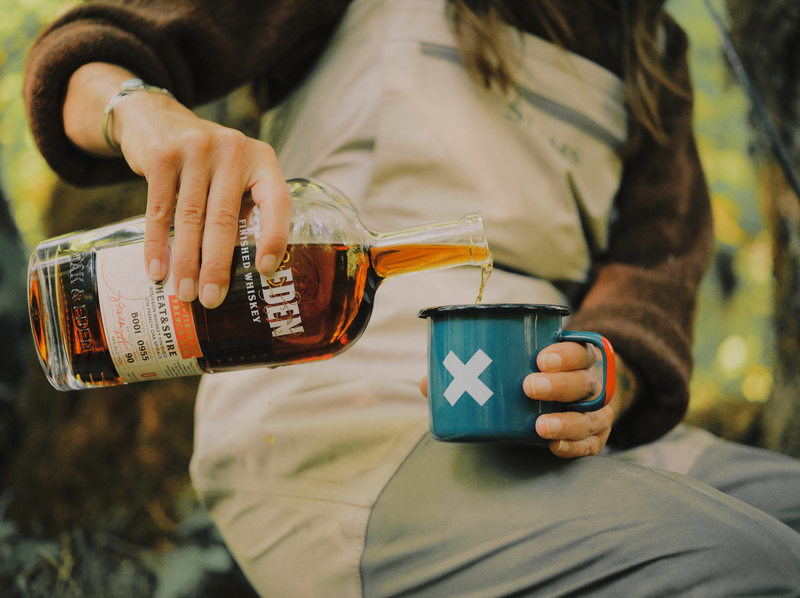
WHAT IS THE BEST WHISKEY? 5 ONES YOU MUST TRY
There are many things that are special about whiskey. But what we love the most here at Oak & Eden is how each whiskey is unique from all others. Whether it is a different region, different style, or just a different barrel of single malt, each whiskey brings its own unique flavors and tastes to the table.
Since there are so many options, it is important to taste a variety of different whiskies. It is the only way to develop your palate, learn what you like and don’t like, and find the best whiskies out there in the world. Whether you’re a fan of the old fashioned or you like to sip your whiskey straight, there’s something for everyone.
But if you don’t have the time to taste all the different kinds of whiskey from all the different distillers in the world, don’t worry, we have you covered. We’ve compiled our list of must try whiskies, covering the gamut of styles and flavors, so that you can get a taste of what different styles of whiskey have to offer.
Here is your guide to finding the best whiskey for you, and the whiskies that you must try to develop your palate.
What Gives Whiskey Its Flavor?
The deep, complex flavor profile that you’ve come to expect from whiskey is, perhaps surprisingly, largely thanks to the wood casks in which it’s aged. Before entering the barrels, whiskey is a clear, sharp liquor, but spending time in the wood softens it and allows it to develop all those notes that whiskey is known for — flavors of vanilla, caramel, smoke, or even leather.
Those casks also give distillers the option of adding a little extra flavor by using vessels that once held something else. For example, if you want to give whiskey a fruity flavor, you can age it in former sherry casks. If you choose charred oak casks, the finished product is likely to taste smokier and richer. The aging process is really where you have the opportunity to play.
So, beginner whiskey drinkers should know that when they don’t like the taste of a specific whiskey, it’s likely that they don’t like the characteristics of the wood in which it was aged. Luckily, you have many options to choose from, so you’re sure to find something you enjoy at any price point.
How To Taste Whiskey
Before we can get into the best whiskeys that you must try, we feel it would be a disservice to leave you without any idea of how to taste your whiskey like a pro. While tasting technique is not one of the most important things about enjoying whiskey, it can help you identify flavor notes and elements that you might miss otherwise.
Step One: Observe the Whiskey
The first step to tasting your whiskey is to observe it. But before you can observe you have to put it in the right glass. While the Glencairn style glass, with the bulbous bottom and tapered lip, is the ideal glass for a whiskey tasting, using a rocks glass is going to be fine as well.
Then you should start by looking at your whiskey in your glass. For this reason it is important that you use a clear glass to taste your whiskey. The color of your whiskey comes from the aging process, which is also where the flavor of whiskey is derived.
The darker the color of a whiskey, the heavier and more robust you can expect the flavors and aromas to be.
Step Two: Smell Your Whiskey
Before you can taste your whiskey, you should smell it first. Aroma and smell makes up a good portion of your sense of taste, so allowing the scents of the whiskey to wash over your nose before drinking can prepare your taste buds to taste the whole whiskey.
You should do this by gently placing your nose near the opening of your glass and gently inhaling through your nose. Taking a large wiff right from the glass will give you a big inhale of alcohol vapor, which will fry your olfactory sense and leave you feeling… well… not great.
You should also avoid swirling your whiskey like a wine before smelling. Yes, swirling the beverage will release the aroma, but it also releases more alcohol vapors, which is why it is okay for lower ABV drinks like wine and less smart with hard liquors like whiskey.
Step Three: Sip Your Whiskey
The final and everyone's favorite step of tasting your whiskey is to sip it gently and small. Remember that, while whiskey is delicious and fun to drink, there is a difference between tasting your whiskey and downing your whiskey.
Start by taking a very small sip and holding it in your mouth for a bit before swallowing to allow the flavor to hang around on your tongue for a bit. As you keep sipping you can slowly increase your sip size as your tongue and mouth adjust to the alcohol content.
Whiskey Tasting Pro Tips
Before we dive into the delicious whiskies that you have to taste at some point to truly taste all that whiskey has to offer, we want to give you a few final expert tips to taste your whiskey like a pro.
Do Not Sip Water After Your Whiskey - While water can be a good choice to cleanse your palate in between whiskies, you don’t want to sip water in between sips of the same whiskey. The finish, or aftertaste, of the whiskey is one of the crucial elements of the flavor. Allowing each sip to build on the next will allow you to continue tasting subtle flavors and experience the full finish of the whiskey that you are sipping on.
Add a Bit of Ice or Water - Another tip that can help you experience everything in a whiskey is adding just a touch of water or a cube of ice to your glass. This will gently dilute the whiskey, decreasing the ABV without significantly altering the other flavor elements of your whiskey. With a lower ABV, your tongue will be better able to identify very subtle notes and elements of the whiskey.
Chew Your Whiskey - The final tip is one that you can take or leave depending on how seriously you take your whiskey tasting. If you really want to get all the flavor from your whiskey, you can swirl it around your mouth, and “chew” the whiskey so that it coats every surface of your mouth. Different parts of your mouth taste different elements of flavor, so coating your whole mouth can bring out new and interesting things.
If you follow these tips, and the steps above, then you are ready to taste whiskey with the experts of the world.
5 Must Try Types of Whiskey
Now we are finally ready to dive into our list of 5 of must try types of whiskey. Rather than taking the approach of telling you an exact whiskey brand to search for, we are instead just going to delineate the major types of whiskey that you have to try in order to experience the many different flavors of whiskey. Without further ado, here is our list of 5 must try whiskeys.
#1 Bourbon Whiskey
The first type of whiskey that you must try is bourbon whiskey. This option comes from close to home, and it’s close to our hearts.
Bourbon whiskey must be made in the United States, with a majority of bourbon being produced in the state of Kentucky. Bourbon whiskey is made with a mash bill of at least 51% corn, and must be aged in new, charred oak barrels for a minimum of two years.
This American whiskey is notorious for its vanilla and caramel flavor notes. The best bourbon is a gently sweet, warm, and delectable spirit that tastes great on the rocks or in your favorite whiskey cocktails and mixed drinks.
We offer a great bourbon whiskey at Oak & Eden which you can read more about here.
#2 Scotch Whisky
Now we are going to hop across the pond to the United Kingdom for our next must try type of whisky. You may have noticed we are spelling whisky without the “e” in this section, because that’s the way the Scots do it.
Scotch whiskey must be made and aged in Scotland, and many Scottish people claim that Scotland is where whiskey was invented, although the Irish would beg to differ. Scotch whiskey is traditionally made with malted barley, and must be aged in oak barrels for a minimum of three years before bottling. There are several regions known for their whisky distilleries, including Islay, Highlands, Lowlands, Speyside, and Campbelton.
Scotch whiskey is a much more aggressive flavor than bourbon, with a famous smoky, peaty flavor profile and spice. The best Scotch whiskey is also known for its malted flavor, a side effect of the use of malted barley in the mash bill. Johnnie Walker is one well-known brand of Scotch, as are Laphroaig and Macallan.
#3 Rye Whiskey
Rye whiskey does not have a regional specification as to where it can be made, which is why you find rye whiskies made all over, but mostly still in the United States and Canada.
Rye whiskey must be made with a mash bill containing at least 51% rye, with the other 49% coming from a combination of other grains. Rye whiskey, like bourbon, must also be aged in new oak barrels for a minimum of two years, but only if produced in the United States.
Rye whiskey packs a bigger and bolder taste than bourbon whiskey while still staying away from the smokey elements that Scotch is known for. The best rye whiskey is spicy, smooth, and round, with a bit of a bite and the same smooth bourbon finish. Wild Turkey is one notable brand.
#4 Irish Whiskey
If we were going to put Scotch on the list then you know we had to put Irish whiskey up here too. Whether whiskey was invented in Ireland or Scotland, we may never know, but what we do know is that both are delicious.
Irish whiskey must be made in Ireland using grains that are commonly found in Ireland. Irish whiskey is most typically made using unmalted barley, and is dried without exposure to smoke. Irish whiskey must also be aged for a minimum of three years before it can be bottled and consumed.
The best Irish whiskey is a much lighter, fruitier, and mellower type of whiskey than Scotch and most other types of whiskey. The barrel aging still gives Irish whiskey a caramel and vanilla/oak finish, potentially with notes of dried fruit, making irish whiskey a very pleasant whiskey to drink straight or on the rocks. Jameson is one very popular brand.
#5 Wheat Whiskey
And the last inclusion on our list is one that you likely don’t encounter every day, but should be a whiskey that you try at least once in your lifetime. Wheat whiskey can be made anywhere in the world but is most commonly made in the United States.
Wheat whiskey must be made with at least 51% wheat in the mash bill, but some master distillers choose to use 100% wheat in their wheat whiskey mash bills. Easier to find is wheated bourbon, which replaces the rye in a traditional bourbon, which mellows and sweetens the flavor.
Wheat whiskies are generally very mild and pleasant sippers. You can really taste the cereal grains in a wheat whiskey or wheated bourbon in a way that can change the way you think about whiskey. Maker’s Mark is one potential option.
The Best Whiskey: Honorable Mentions
While the whiskeys listed above are iconic, but they’re nowhere near the only options on the market. If they’re not satisfied with the options above, whiskey lovers should consider trying one of these whiskey:
Japanese whisky. Options from Japan tend to be very similar to Scotch, and Suntory is a popular option.
Tennessee whiskey. Tennessee whiskey, like Jack Daniels, is charcoal filtered.
Canadian whisky. This whisky tends to be both light and sweet.
What Is The Best Whiskey: Takeaways
There are few things as fun as tasting and trying different kinds of whiskey. And now you know all the techniques you need to taste your whiskey properly, and the 5 types of whiskey that you must try.
Make sure to observe, sniff, sip, and savor your whiskey when you are tasting it to allow the flavors to wash over you. Feel free to dilute or chew on your whiskey in your mouth to increase the flavor perception, but do yourself a favor and avoid swirling your glass before smelling.
So what truly is the best whiskey? Well the answer is simple - whatever whiskey you like the best. At the end of the day, whiskey is about enjoying your favorite liquor the way that makes you the happiest.
Oak & Eden offers a variety of expertly crafted whiskies, including bourbon, rye, and wheated bourbons that you are bound to love. Check out our selections here.
Sources:
Wheat Whiskey & Wheated Bourbon Explained | Distiller
What Is Irish Whiskey? | The Spruce Eats
What is Scotch Whisky? | World Whisky Day
The Serious Eats Guide to Rye Whiskey | Serious Eats
READ THE STORY
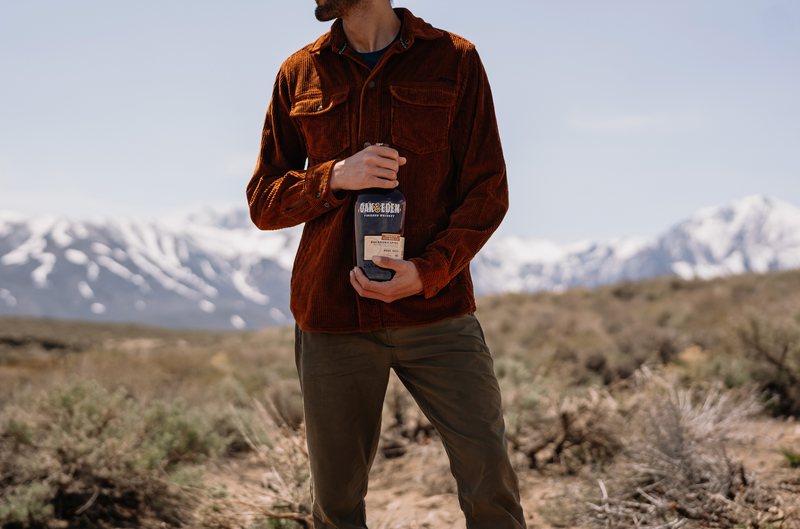
HOW LONG DOES WHISKEY LAST? WHAT TO KNOW
If you are as big of a fan of whiskey as we are, you probably have a wide variety of bottles of whiskey to choose from at your home bar. Different whiskeys are appropriate for different situations, and having a choice is fun.
The downside is that you probably have bottles of whiskey on your bar that have been open for… well… longer than you would like to admit. We know we do. This may have you wondering: Is this whiskey still good?
Does whiskey expire or go bad? What happens to whiskey when it sits open? How long does whiskey last? Will my special, unopened bottles go bad if I don't drink them? The questions are nearly limitless. The answers might surprise you.
We did our research to figure out the answers to these questions (and more), so you have everything you need to know about this spirit. Here are the must-knows about the shelf life of whiskey.
What Is Whiskey?
To understand how long whiskey lasts, we need to know what it is. Whiskey is one of the five major types of liquor — the others are vodka, gin, tequila, and rum. It is typically amber to copper brown in color and is typically made from distilled cereal grains, like rye, wheat, barley, and corn.
Whiskey is hard liquor, meaning any whiskey is at least 40% ABV or alcohol by volume. Whiskey is also typically aged in wooden barrels, sometimes for years, before being bottled and sold or consumed.
Those barrels are what give whiskey its flavor. This is why moonshine and vodka are clear, and whiskey is darker in color. The wood the whiskey is aged in imparts colors and flavors into the liquid.
Every whiskey has its own unique flavor notes, but most whiskeys will have flavors that fall into the following categories:
Nutty
Spicy
Warm
Caramelly
Woodsy
Whiskey can be sipped straight, on the rocks, or in any number of cocktails, making it a very versatile drink.
Does Whiskey Go Bad?
So does whiskey go bad? The short answer is: it depends.
An unopened bottle of whiskey can last forever without going bad. As long as the bottle remains sealed and it remains stored in proper conditions, any special bottles you have will last for decades.
But once you open the bottle, the clock starts ticking. An opened bottle of whiskey will last as long as two years or go bad in as few as six months, depending on a few factors.
What Makes Whiskey Go Bad?
Whiskey goes bad for the same reason that all alcoholic beverages go bad over time. Factors like exposure to air, sunlight, and extreme temperature can alter the flavor and alcohol content of the liquor, making the spirit unsafe to drink.
How Does Light Impact Whiskey’s Shelf Life?
Light impacts the shelf life of whiskey and all liquors. Direct sunlight exposes the alcohol to UV rays, the same kind of sun rays that give you sunburns, which can cause the alcohol to lose color.
This is why whiskey bottles, and many other alcohol bottles, are typically brown or green — to help block some of the UV rays from reaching the liquid. However, the best protection is to keep your bottles stored somewhere completely out of direct sunlight, like a cupboard or shelf.
How Does Temperature Impact Whiskey Shelf Life?
Once you deal with light, you should know that temperature plays an important role in the shelf life of whiskey too. Whiskey contains something called terpenes, which are chemical compounds responsible for the scents and flavors in whiskey and other foods, drinks, and perfumes.
Temperature changes to the alcohol will alter these compounds and degrade them, altering their flavors, weakening or changing them. This can render some bottles undrinkable if enough unsavory alterations occur.
Storing your alcohol at a relatively consistent temperature, around 70 degrees Fahrenheit, is ideal. A cellar or basement is a good storage place for bottles you are keeping for a long time, as long as it is well insulated against temperature swings.
How Does Oxidation Impact Whiskey’s Shelf Life?
The final key to understanding how long whiskey lasts is the largest factor in determining the shelf life of your whiskey: oxidization.
A sealed bottle of whiskey stays good indefinitely because there is no or virtually no alcohol exposure in the bottle. As soon as you open it, the seal is no longer airtight. As you pour more out of the bottle, there is room for more oxygen in the bottle. This means that the oxidization rate increases over time as the volume of the bottle changes.
This means that as soon as you open a bottle of whiskey, it will start to go bad. The speed at which it goes bad increases as you continue to drink more of the bottle.
How Long Do I Have To Drink an Open Bottle of Whiskey?
Once you open a bottle of whiskey, the clock starts ticking. But how long exactly do you have to get the best flavors out of your whiskey?
If you store your bottle in the best possible storage conditions, it may last as long as two years from opening or one year in less ideal conditions. However, this is only if the bottle is at least halfway full. Once you cross the quarter half-full mark or less, you can only get as much as six months out of a whiskey.
These are, of course, estimates. Depending on storage and air exposure quality, these numbers may go up or down.
How Does Aging Alcohol Work?
You’ve probably been wondering for a bit now what is different about aging alcohol before bottling compared to letting a bottle of alcohol sit unopened or opened on a shelf in a bottle. Why does one go bad while the other seemingly gets better with age?
While the whiskey is in wooden barrels, it is sealed to prevent oxidation which is the main mover of decay in whiskey’s flavors and compounds. As such, the aging process allows the whiskey to take on new flavors in the wooden barrel without going bad.
We use the same idea for our finishing process but take it a step further. Here at Oak & Eden, each bottle of whiskey is equipped with a spire, a spiral-cut piece of wood that sits in a whiskey bottle and continues the finishing process even after the whiskey leaves the barrel.
This gives you control over exactly how long you’d like your whiskey to age.
Tips To Store Whiskey in the Best Conditions
If you store whiskey in ideal storage conditions, you can get a sealed bottle to last just about forever. You can give your bottles the best chance to stay fresh by following these few tips for proper storage conditions.
Store Your Whiskey Out of Sunlight
The first key to keeping your whiskey fresh and flavorful while storing it is to keep it out of direct sunlight, where UV rays can degrade the colors and flavors. Place your bottles in an area of the home that does not get direct sunlight and, if possible, in a dark cupboard.
If you have any whiskeys that came in a box or bottle sleeve, it is there to protect them from sunlight. Store these whiskeys in those containers when they are not being poured to protect them from sunlight.
Store Your Whiskey Somewhere With a Consistent Temperature
The next thing you can do to keep your whiskey as fresh as possible is to keep your whiskey in a temperature-controlled location. Temperature changes can cause the whiskey to lose its terpene flavor compounds and alter the flavor in less-than-palatable ways.
Try storing your bottles in a cupboard during hot days as the temperature tends to stay a little cooler. Keep long time saver bottles in a basement or cellar space to avoid temperature changes.
Store Your Whiskey Bottles in a Cellar or Wine Fridge
Our final tip to help you keep your whiskey good for as long as possible is to put your whiskey in a cellar or wine fridge. While the upfront cost of a dedicated cellar room or wine fridge is high, keeping a bottle fresh for years to come is worth it.
A cellar or wine fridge will be a temperature, humidity, and sunlight-controlled area. This keeps the environment as consistent as possible to prevent damage to the whiskey.
So, How Long Does Whiskey Last?
While whiskey doesn’t necessarily expire, it does start to lose flavor and elements after it is opened.
An unopened bottle of whiskey will last indefinitely if stored in proper condition. After opening a bottle of whiskey, you have as long as two years or as few as six months or less to drink it before it goes bad.
To store your whiskey most effectively, keep it out of direct sunlight, avoid massive temperature swings, and keep it sealed airtight when drinking.
Keeping whiskey for the long haul only takes a little effort, but it’s worth it to protect your favorite spirit.
Sources:
The Oxidation of Alcohols | Chemistry Views
What Is Whiskey? | The Spruce Eats
How to Properly Store Alcohol at Home | Insider
READ THE STORY
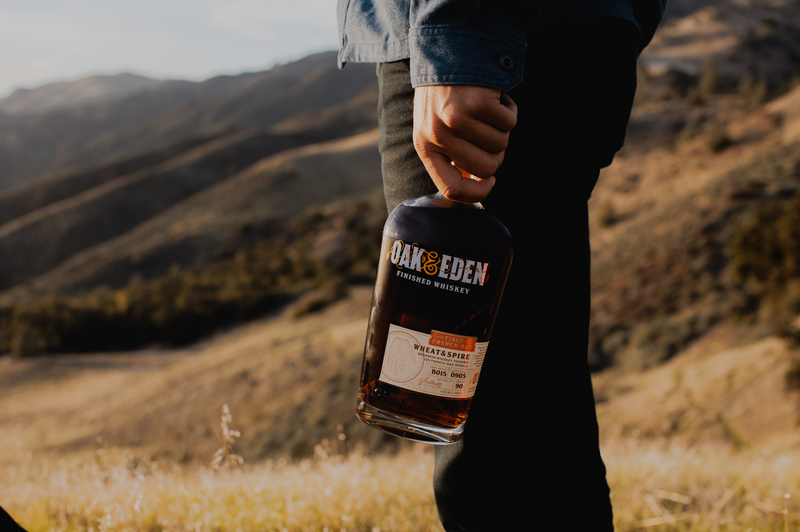
WHEN WAS WHISKEY INVENTED? A BRIEF HISTORY
Whiskey can be found in bars around the globe, and varieties of whiskey are made in dozens of countries, each with its own unique style. Some whiskies are uniquely American, others Irish, more yet Scottish, or even Japanese.
With such a globally recognized spirit, it can be difficult to understand where whiskey got its start. Whiskey has been around for a long time and has spread across the globe to where it is today.
The history of whiskey is an interesting look at how technology and local tastes combine to create different styles that are unique to each region — all just as delicious as the next.
Here is a brief history of whiskey, starting when it was first invented to the world of whiskey today.
The Invention of Distillation
In order to cover the history of whiskey around the world, we need to start where it all began: the art of distillation. Distillation has been in practice since the 2000s BC, when people in Mesopotamia were using the technique to produce stronger aromatics and perfumes.
The first written record of distillation that we currently know of takes us 2000 years into the future to the first century AD. These first accounts of distillation come from the Greeks and describe how distillation was used to turn seawater into potable drinking water.
The Spread of Distillation Through Europe
The process of distillation continued to spread west throughout Europe, where the process was used by many to produce medicinal products and ceremonial ingredients. Distillation continued to spread throughout the first millennium AD, gaining popularity and becoming more effective with advancements.
Distillation was used throughout the world during this time and was likely used to produce alcoholic beverages for a long time before we have real documentation of it happening.
Eventually, the techniques of distillation spread their way north into Scotland and Ireland, both of which lay claim to the title of the inventors of whiskey. While other Europeans were using wine as the beverage to distill into a spirit, the Scots and Irish, lacking access to grapes, turned to fermenting grains to produce an alcoholic beverage to distill.
This led to the production of aqua vitae, Latin for “water of life,” a name that was used for any distilled alcoholic beverage back then. In Gaelic, a Celtic dialect, it was called uisge beatha. These Scottish and Irish aqua vitae are the first examples we have of a modern whiskey-like beverage.
The Coining of the Term Whiskey
The first time we see an aqua vitae referred to by the term “whiskey” takes us all the way to 1405 in Ireland. The Annals of Clonmacnoise, an ancient Irish book of history, refers to a clan member dying from “taking a surfeit of aqua vitae (whiskey).”
As the 1400s continued in Ireland and Scotland, whisky production was in full swing and was being bought, sold, and consumed regularly. In fact, there are a few pieces of written evidence showing that kings were often involved in granting supplies to monks for the distillation of whiskey.
We know for sure that distillation existed in Scotland by 1494, as King James IV is recorded to have given Friar John Cor a large amount of malt, according to the Exchequer Rolls.
Whiskey Spreads to the Americas
As European settlers and colonists continued to flow across the Atlantic ocean towards the Americas in the early 1600s, the Irish and Scots among them brought their knowledge of whiskey distillation with them to their new home.
Around this time, the first-ever licensed whiskey distillery made its debut. In 1608, the Old Bushmills Distillery was licensed in Northern Ireland, making it the world's very first official whiskey distillery.
Meanwhile, back across the continent, whiskey was gaining popularity in the new American colonies, where the production and consumption of whiskey continued to grow. In fact, whiskey became so popular in the United States that many distillers used whiskey as a form of currency during the American Revolution. Even George Washington himself was a whiskey distiller, distilling as much as 300,000 barrels of rye whiskey per year at his Mt. Vernon plantation.
Whiskey in The United States and Canada
After the Revolutionary War concluded, whiskey continued to play an important role in American history and politics. The first official commercial distillery in the United States was constructed in Louisville, Kentucky, by Evan Williams, whose whiskey is still widely available today.
After the revolutionary war, a whiskey tax was levied by the newly formed American government to help pay back some of its war debts. This tax was met with disdain and outrage from Americans, particularly farming populations who had grown used to fermenting and distilling their unused grains to make grain mash.
This whiskey tax led to what is widely known as the Whiskey Rebellion in the 18th century. A group of six hundred armed men attacked the home of a tax inspector to prevent the collection of the whiskey tax. President George Washington eventually sent a militia of 13,000 to quell the rebellion in Pennsylvania.
While the rebellion may have ended, the whiskey tax was still a major pain for farmers. It was a key player in the election of Thomas Jefferson, who repealed the tax shortly after ascending to the presidency. The moral of the story: Don’t mess with an American’s whiskey.
The Legalizing of Distillation in the United Kingdom
It may sound shocking to hear, but up until 1823, the distillation of whiskey in Scotland and Ireland was illegal. This meant much Scotch whisky and Irish whiskey production took place during the night to avoid law enforcement, which gave us the term “moonshine.”
Shortly after the legalization of distilleries in the United Kingdom, more improvements in distillation came about. This included the Coffey still, or the column still, which is still used to produce most American whiskey today. This was considered a superior method to the pot stills that had been used up until this point, although both are still popular today.
Prohibition Era United States
From 1920 to 1933, the United States passed an amendment to the constitution that made the production, sale, and use of alcohol and alcoholic beverages illegal. This devastated the whiskey market in the United States, but there was one exception.
The government made an exception for doctor-prescribed medicinal whiskey, which could only be procured from a pharmacy. This played a role in the massive growth of pharmacy chain Walgreen’s expansion, growing from only 20 stores to 400 during this 13-year period.
The Advent of Japanese Whiskey
While Japanese soju and sake distillers had likely been making their own version of whiskey since the mid to late 1800s, the real advent of Japanese whiskey didn’t come about until the early 1900s.
The “Father of Japanese Whiskey,” Masataka Taketsuru, fell in love with and studied closely the production of Scotch in Scotland (which, as a side note, has five main distinctions: Highland, Lowland, Islay, Speyside, and Campbeltown). He then returned to Japan with the love and knowledge of whiskey deeply ingrained in his being. He founded the Nikka Whisky company in 1943, which is still one of the most awarded Japanese whisky distilleries.
Before founding Nikka, Taketsuru worked at the Suntory distillery, founded in 1923. Suntory is the other most popular and awarded brand of Japanese whisky. Together Nikka and Suntory have grown a diehard whisky fanbase in Japan and have brought new flavors and tastes to the whiskey world at large.
The Global Boom of American Whiskey
Today, you can find American-made bourbon, Tennessee whiskey, and rye whiskey in bars across the globe, but this was not only the case. The boom of American-made whiskeys didn’t start until the 1960s, when the U.S. government officially labeled bourbon as the official distilled spirit of the United States.
This led to booming sales and production as certain types of whiskey from the Americas became more popular throughout the following decades. Rye whiskey, too, has continued to grow in popularity, especially in the last two decades, where year after year, rye consumption has continued to rise since 2005. Canadian whisky has also become popular.
Modern Advancements in Whiskey Making
And that takes us up to where we are today. Several advancements are taking the whiskey world by storm and changing how we think of our favorite alcoholic beverage. All whiskey must be aged in wooden casks, but we take it a step further.
Oak & Eden’s approach to bringing new technology to whiskey making is our patented in-bottle finishing technique. After finishing our whiskey in a new oak barrel before bottling, we craft our wooden spires to place in-bottle, which finish your whiskey while resting in the bottle.
Our spires are spiral-cut pieces of wood that have been chosen carefully to complement each of our blends of whiskey for the ultimate flavor profile. In-bottle finishing is what gives Oak & Eden whiskey its creamy, smooth texture and incomparable flavors.
A Brief History of Whiskey: In Summary
The history of whiskey is a long and wild ride through science, technology, religion, politics, and cultures. Altogether, the history of whiskey makes the flavors of each sip sing more true.
While distillation processes have been used around the globe for centuries, the first distillation of whiskey as we know it today took place in Scotland or Ireland in the early 1000s AD. From there, whiskey production grew in popularity, spreading to the Americas with European colonists.
Whiskey then continued to play an important role in American political life through the whiskey tax, prohibition, and eventually the naming of bourbon, which is mostly corn whiskey, as the official distilled spirit of the United States.
Japanese whisky came about in the 1900s, based on the methods of Scotch production and refined for Japanese tastes at the Nikka and Suntory distilleries, both still producing award-winning whiskeys today.
That brings us to today, where advancements in whiskey-making are still being made. Consider trying a bottle of our Oak & Eden bourbon, rye, or wheat whiskey to taste the difference that our in-bottle finishing process makes.
Sources:
Japanese Whisky: The Origin Story | Whiskey Culture
Coffey still | Whisky Advocate
What is Kentucky Bourbon Whiskey? | BourbonCountry.com
READ THE STORY
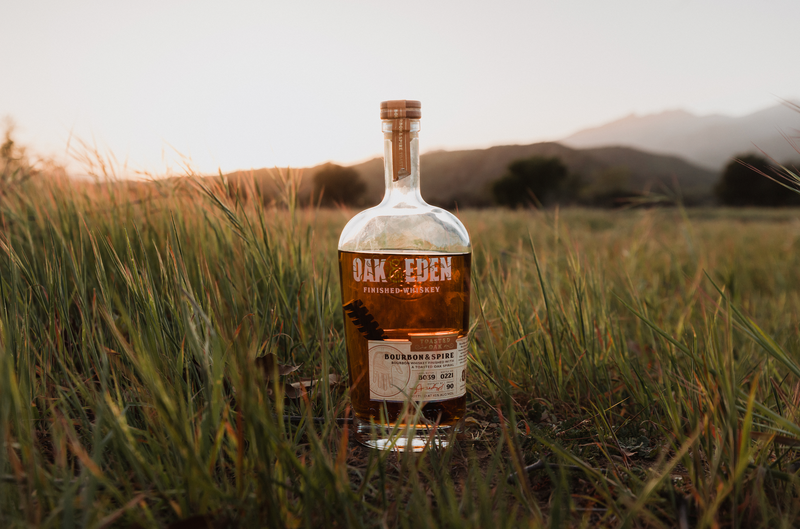
WHAT DOES BOURBON TASTE LIKE?
What is your go-to drink at the bar? Do you reach immediately for a beer? Or are you always down for a glass of red wine? Or maybe you choose something classic like a Martini?
Whatever your go-to is, a pretty small percentage of people choose bourbon, even though this drink is complex and delicious.
Those who have never tried bourbon before might be a bit nervous that they won’t enjoy it. But bourbon is no more offensive than any other spirit; in fact, it packs even more flavor into a small serving than many other drinks.
But what does bourbon taste like, exactly? Here is a quick overview for new drinkers of bourbon to understand what bourbon tastes like before diving in headfirst.
What Is Bourbon?
Before we get too deep into the flavors of a good bourbon whiskey (and believe us, there are some deep flavors in good bourbon), it will help to understand what exactly bourbon is.
Bourbon is a specific type of whiskey made in the United States. It was originally produced in Bourbon County, Kentucky, though now it can be made anywhere in the U.S.
Bourbon is hard liquor, meaning it has an ABV of at least 40% at bottling. Bourbon is made from a mixture of corn, wheat, barley, and rye but must contain at least 51% corn.
Bourbon is also an aged spirit and must be aged for at least two years in new American charred oak barrels before bottling. This liquor is also caramel brown in color and can be anywhere from light amber to dark oaky brown.
What Are The Legal Requirements To Be A Bourbon?
The explanation can get a little confusing, so we wanted to give you a breakdown of the requirements of bourbon whiskey.
Made in the United States: The first legal requirement for bourbon is that it must be made in the United States. To be a Kentucky bourbon, it must be made in Kentucky
51% Corn Mash Bill: All bourbon whiskies are made with a mash bill of 51% corn or more, with the rest made of a combination of wheat, barley, and rye.
Aged for 2 Years in New Charred American Oak Barrels: All bourbons are aged for a minimum of two years in new wooden barrels made from American oak.
Minimum 40% ABV: All bourbons must be bottled at no less than 40% ABV.
What Does Bourbon Taste Like
Now that you know the basic things that make a bourbon a bourbon, we can dive into the taste factors. Bourbon has many different flavor components, and these vary between distillers and different recipes. However, there are a few consistent characteristics you can expect from bourbon.
The most common notes in bourbon are caramel, vanilla, and oak. Surprisingly, whiskey is actually one of the more “sweet” tasting liquors, despite not containing added sugars.
How Does Bourbon Get Its Flavor?
Bourbon, like other spirits like vodka, is a distilled beverage, so why does one have so many flavor notes, and the other is considered “neutral”?
It all comes down to two crucial elements — the mash and the aging process.
How Does Mash Impact Bourbon Flavor?
The first major component that impacts bourbon flavor is the mash bill. The mash bill denotes what percentage of different grains are fermented together to make the whiskey.
The mash bill is the main element of the bourbon, and just like different grapes can influence the flavors of wine, the different mash bill combinations can impact the bourbon’s flavor for a bolder or sweeter taste.
These combinations are limited because all bourbons must use a mash bill of at least 51% corn to still be considered a bourbon. This means that corn, with its sweet, mellow, and light flavor profile, is always the main ingredient.
Distillers do get some room to play with flavor in the mash bill, as the other 49% is unregulated. Distillers can use any amount of corn, wheat, rye, or barley to make up the rest of the mash. Depending on which are used, the bourbon can become more spicy, earthy, malty, sweet, or mellow.
How Does Aging Impact Bourbon Flavor?
The other aspect of making bourbon that impacts flavor is the aging process. All bourbons must be aged for at least two years in freshly charred oak barrels. Whiskey, or any other spirit, starts out clear. This aging process is where most of the flavor and all of the color of the liquor comes from.
This is why vodka, which is unaged, is clear, while whiskey is dark. Other spirits, such as tequila, can range from clear to brown depending on the length of aging. But how exactly does aging whiskey in a barrel give it color and flavor?
Wood expands and contracts with the environmental changes in temperature and humidity. Over the next two years, the wooden barrel ends up breathing the whiskey in and out, imbuing it with the flavors and colors present in the wood. This makes the whiskey darker and can give it notes of vanilla,
While bourbon must be aged in oak for two years, you still get variation between distillers depending on where they source their oak from and the level of fire they expose their barrels to.
What Is Finished Whiskey?
We know what you are thinking: are there any other ways to impact the flavor of whiskey before it gets bottled? The answer is a resounding yes.
Finished whiskey is whiskey that has been aged a second time in another barrel after the American oak barrel. This imparts more flavor notes to the whiskey, such as vanilla, honey, tobacco, or fruit. At Oak & Eden, we have pioneered a new way to finish whiskey — not in a second barrel, but in the bottle.
We use our patented spires, spiral-cut pieces of wood that have been carefully selected and toasted, to add the maximal flavor notes to our whiskey blends.
Our Oak & Eden Bourbon Whiskey contains an American oak spire, charred to a medium toast level to bring in the perfect layering of vanilla and caramel while your whiskey sits in its bottle.
What Goes Well With Bourbon?
Now that you know the basic flavors of bourbon, it’s time you take a sip and mix your own bourbon cocktails. The good news is that many things go well with bourbon whiskey.
The Whiskey sour is a classic cocktail that combines bourbon whiskey with lemon juice, simple syrup, and sometimes an egg white for added froth. Enjoy it freshly shaken and poured over ice for a twist of sweet and sour. The vanilla and caramel notes of the whiskey mix nicely with the citrus to give you the perfect sipper.
Whiskey is also known to go well in simple mixers like sodas, particularly cola. In fact, whiskey and Coke is an incredibly popular choice at most bars, as is the whiskey and ginger ale. Make one for your own with Oak & Eden’s Bourbon & Spire for a deeply satisfying and smooth drink with sweet, tangy notes.
The Taste of Bourbon: Takeaways
Trying bourbon for the first time can be a bit scary, but it’s also exciting. Enjoying this spirit can open up a whole new world of flavors to you, and bourbon has one of the most approachable flavor profiles of any hard liquor.
Bourbon tastes strongly of vanilla, caramel, and oak, and depending on what option you choose, you’ll find that some flavor notes are stronger than others. These flavors are imparted through the mash bill and the aging process of the whiskey, with different practices resulting in slightly different and varied flavors.
These flavors are a great compliment to many other flavors, including citrus and dark sodas. But you can also enjoy bourbon whiskey straight or in a simple Old Fashioned.
If you are looking for a great bourbon to try, our Oak & Eden Bourbon Whiskey is one of the best, with each unique bottle finishing giving additional flavors and nuance to every bottle. Give it a try, and you won't be disappointed.
Sources:
What a Whiskey's Age Statement Really Means | Men's Journal
What Is Whiskey? | The Spruce Eats
What is bourbon? And how is it different from other whiskies? | World Whisky Day
READ THE STORY
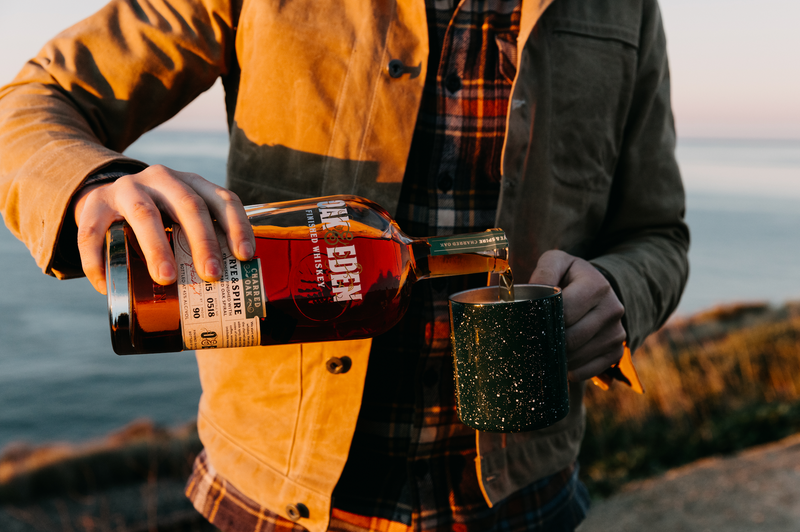
RYE WHISKEY VS. BOURBON: WHAT TO KNOW
Whether you’re well versed in whiskey or a novice just along for the ride, we’ll tell you what you need to know about the differences between rye whiskey and bourbon. We’ll talk about how they are made, what sets them apart, and how Oak & Eden crafts both using an innovative bottling process to create a customizable finished spirit unlike anything else.
READ THE STORY
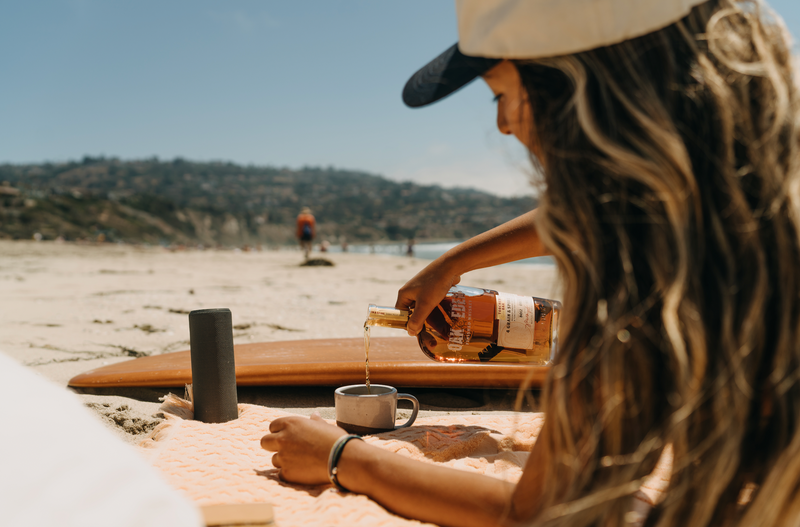
HOW TO DRINK WHISKEY: COMPLETE BEGINNERS GUIDE
Whiskey can be an alienating drink for many just because of its sheer complexity.However, whiskey is for everyone, and it has a lovely flavor profile that anyone can enjoy. But if you are just getting into whiskey, you may not know where to begin.
On the other hand, if your friends are forcing you to go to a whiskey tasting even though you don’t really like whiskey and you don’t want to seem like you don’t know what you’re doing, you’re in the right place, too.
Drinking whiskey isn’t as complicated as some people believe or want you to think. With this straightforward guide, you’ll know everything you need to drink whiskey like an expert.
Here is the complete beginner's guide to drinking whiskey.
What Is Whiskey: Starting With the Basics
Whiskey is one of the five standard varieties of liquor, along with vodka, gin, rum, and tequila. There are many different variations of whiskey across regions and cultures, but the essential elements of a whiskey are that it is a distilled spirit made from cereal grains, commonly wheat, rye, barley, or corn.
Whiskey is at least 40% alcohol by volume (ABV), making it a hard liquor. Every whiskey brings its own unique flavors but the general flavor of whiskeys across the globe falls into categories like caramel, vanilla, toasty, warm, spicy, and woody.
What Are the Different Kinds of Whiskey?
Bourbon Whiskey: Bourbon whiskey is perhaps the most famous American whiskey in the world. Bourbon whiskeys must all be made in the United States and must also be made using a grain mash bill of at least 51% corn. Bourbon whiskey is then aged in new, charred oak barrels.
Rye Whiskey: Rye whiskey, on the other hand, does not need to be made in the United States. Rye whiskey is quite popular in the US, but it is also a staple in Canada (where it is spelled whisky). Rye whiskey must be made using a mash bill of at least 51% rye. This gives rye whiskey its notorious spiced flavor profile that it is well known for.
Tennessee Whiskey: Tennessee whiskey is one of the most heavily restricted types of whiskey in the world. Tennessee whiskey must be made in Tennessee. It must use a 51% corn mash bill, like bourbon, and must be aged in new charred oak barrels as well. Tennessee whiskey is then subjected to a charcoal filtration process that further removes impurities and mellows out Tennessee whiskey flavors.
Scotch Whisky: Scotch whisky is one of the oldest types of whisky available anywhere in the world. Scotch whisky is spelled like Canadian whisky, without the “e.” Scotch whisky is typically made with a mash bill of at least 51% malted barley. Scotch is made using pot still distillation and is then aged in Scotland for at least three years before bottling and consumption.
Irish Whiskey: Irish whiskey is another one of the oldest types of whiskey. Irish whiskey is also made using 51% barley, but it is typically unmalted. Irish whiskey is also typically known for its smooth and light flavor profile, where Scotch is known for its peat-heavy and smokey flavor profile.
Japanese Whiskey: Japanese whiskey has only been around for about a century now, but it has already cemented itself in the whiskey world as well-crafted whiskey. Japanese whiskey takes after Scotch whiskey, using predominantly malted barley which is often imported from Scotland. Japanese whiskey is aged in American wood barrels, Japanese wood barrels, or sherry casks, which give Japanese whiskey unique flavors.
How To Taste Whiskey
Now that you know more about what whiskey is and the varieties of whiskey that you may encounter, you are finally ready for whiskey tasting etiquette. Keep in mind that these are also all just suggestions. At its heart, whiskey is for everyone, and you can enjoy it however you enjoy whiskey best.
Observing the Whiskey
The first step to a whiskey tasting is observing the whiskey, which is essentially looking at what you drink before you drink it. The very first thing that you may notice is that whiskey has its own glass, the Glencairn glass.
A Glencairn glass is round and bulbous at the bottom and tapered at the top to allow the aromas to rise up in a concentrated manner while giving you room down below for a decent-sized pour.
You will then start to notice the color of the whiskey itself. This is a big clue into the flavor profile of your whiskey, as the wood it is aged in is responsible for the color and much of the flavor. The general rule is the darker the color, the deeper the flavor.
Smell Your Whiskey
The next step of the whiskey tasting process is smelling your whiskey. The aroma of whiskey plays a large role in the flavor, and you can tell a lot from whiskey by a good whiff. A significant amount of what you taste is actually influenced by what you smell, so nosing your whiskey (as it’s often called) can complement the tasting step.
The specific technique for nosing whiskey is called “retronasal breathing,” which is the same method people use to enjoy cigars. You breathe in through your mouth, close your lips and hold in that breath for a moment, and then breathe out through your mouth. That should help avoid the burn that is sometimes associated with the smell of whiskey.
Does your whiskey smell of caramel? Vanilla? Oak? Or does it smell spicy? Smoky? There are no wrong answers, but keep yourself open to making associations as you smell.
Sip and Savor
The final step to tasting whiskey is sipping and savoring the lovely flavors in your whiskey. Remember, tasting is different from drinking; your goal is not to chug your glass but to identify and taste the flavors and notes of your whiskey.
This is best achieved by taking small, slow sips. Taking a small sip and letting your palate adjust to the whiskey with as little alcohol in your mouth as possible will slowly allow your mouth to adjust. Then you sip again, slightly larger, and keep tasting for the specific flavor notes.
Whiskey Tasting: Don’t Do This!
Now that you know what you should do at a whiskey tasting, let’s briefly discuss a few things that you should not do at a whiskey tasting. Some of these are simple etiquette mistakes that may go unnoticed, while others will change your experience for the worse.
Do Not Swirl Whiskey
The first major don’t of whiskey tasting is swirling your whiskey. If you have ever been to a wine tasting, you know that the swirl is a major aspect of a wine tasting. By aerating the wine, you release more of the aromas and flavors into the air before tasting and sipping.
But with whiskey, the swirl may make the aroma unapproachable. When you swirl alcohol, you are releasing the aromas but also the alcohol vapors. For wine, which hovers around 12% ABV, this may not make much of a difference. However, with whiskeys that are at least 40% ABV, you could release such a strong set of vapors that you intoxicate your olfactory senses.
Your whiskey will smell strongly enough without a swirl, and you will actually be able to smell the subtleties of the different whiskeys much better if you just let them sit.
Do Not Sip Water Right After Sipping Whiskey
Another thing to avoid when you are at a whiskey tasting is taking a sip of water right after you drink your whiskey. While water is a great way to cleanse your palette and reset before the next whiskey, drinking water too fast after sipping could leave you missing out on the important finishing notes.
The “finish” of a whiskey, or the aftertaste left in your mouth after swallowing, is a major element of whiskey, and you should let yourself taste the finish of each whiskey. Don’t rush your sips, and don't feel like you need to sip on something else right after a sip of the whiskey.
Rather, try to focus on the flavors playing on your tongue and how they develop and change after you have swallowed.
Whiskey Tasting Expert Tips
Finally, we will give you a few expert tips to taste whiskey even better and more clearly. While you certainly don’t have to take any of this advice, it is gathered from some of the experts in the whiskey field.
Add a Bit of Water or Ice
The first expert tip to help you to better taste your whiskey is to add a bit of water or ice to your glass. This will slowly dilute your whiskey, making it less alcoholic, which can help you taste more subtle flavor notes that you might miss otherwise.
Just be careful not to add too much. Putting a single ice cube in your whiskey and allowing it to melt over the tasting can give you new elements and notes.
Chew Your Whiskey
This final one is a bit extreme for most casual whiskey drinkers, but we’re including it anyway. After you take a sip of whiskey, you can roll it around your mouth and chew it like you would chew food to get the whiskey to coat every surface of your mouth.
This can allow you to taste different elements of the whiskey across your mouth. Different parts of your mouth are responsible for different tastes and flavor notes, so allowing it to spread across your mouth can help you taste everything it has to offer.
How To Drink Whiskey: Takeaways
Drinking whiskey can be scary for beginners who are afraid of drinking whiskey the wrong way. But drinking whiskey is about enjoying whiskey, and as long as you are enjoying yourself, you are doing it right.
That said, there are a few techniques that can help you at a whiskey tasting to get the most from your experience. Make sure you start with the right kind of Glencairn glass, then gently sniff, sip, and savor your experience.
If you are looking for some great whiskeys to try, check out our Oak & Eden whiskeys. All of our whiskeys are finished in a bottle with our patented wooden spires, adding flavor and smoothness to your whiskey while it sits in the bottle.
Sources:
Japanese Whisky: The Origin Story | Whiskey Culture
What is Kentucky Bourbon Whiskey? | Bourbon Country
A Beginner's Guide on How to Drink Whiskey | The Manual
READ THE STORY
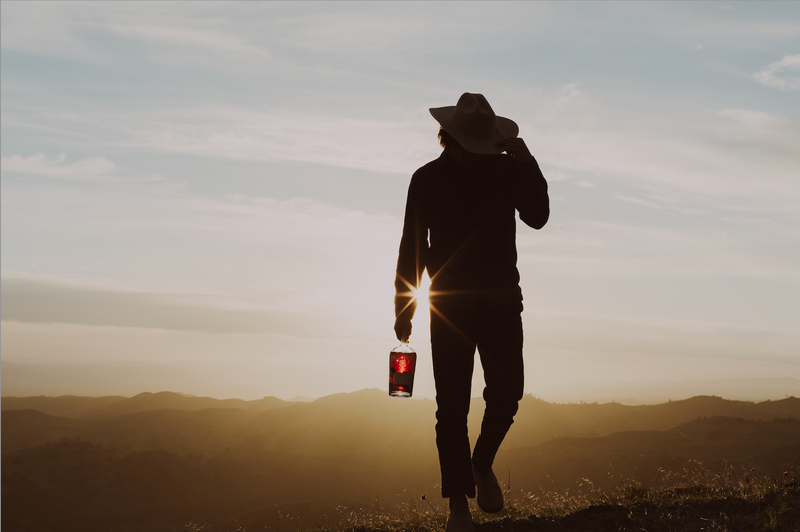
WHAT IS A GOOD WHISKEY TO GIFT?
Gift-giving is a skill and an artform. No matter the occasion, finding the right present that tells the recipient you care about them can be a challenge. When shopping for the ultimate gift, you’re looking for a present that maximizes three things: usefulness or enjoyability, price, and sentimental value.
READ THE STORY
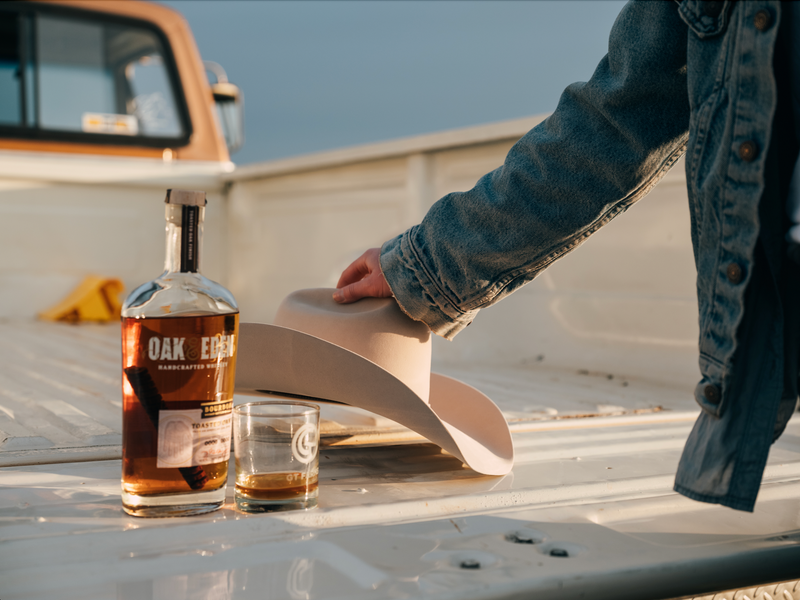
WHEN IS NATIONAL BOURBON DAY?
There are a lot of holidays that our great nation celebrates. From January to December and every month in between, you can bet there is a day that we Americans love to celebrate. In fact, the trend towards holidays is so strong that pretty much every single day is a celebratory day for some person, place, or thing.
Bourbon is no exception to this rule. There is, indeed, a national holiday to celebrate the official spirit of the United States. Every year, National Bourbon Days comes around in the U.S., giving us the perfect opportunity to celebrate our favorite hard liquor.
So, when exactly is National Bourbon Day? Why is there a specific day to celebrate bourbon? What makes bourbon special? How did bourbon first come to be invented?
We’re answering all of these questions and more so you can be prepared to celebrate the greatest day of the year.
When Is National Bourbon Day?
Every year National Bourbon Day is celebrated on June 14th. Tucked in between Memorial Day and Father’s Day, National Bourbon Day can fly a bit under the radar. For those in the know, it’s hard to forget how fun celebrating Bourbon Day can be.
According to legend, June 14th is the first day that bourbon was distilled, although this is more symbolic than anything. Whether the 14th of June is the birthday of bourbon whiskey or just a random day of the year, it is what the day represents that matters.
What Is Bourbon?
To celebrate National Bourbon Day, we’ve decided to give you all the details on bourbon, how it’s made, and how you can celebrate on the 14th.
Bourbon is a specific type of whiskey that must be distilled and aged right here in the United States. Bourbon whiskey must be made with a mash bill that contains at least 51% corn and must be aged for a minimum of two years in new charred oak barrels. So long as a whiskey meets these requirements, it can legally call itself bourbon.
If you want to earn the distinction of Kentucky bourbon, a bourbon whiskey needs to be distilled and aged in the state of Kentucky (as the name implies). Bourbon can be aged for much longer than two years — and often is for additional flavor.
Bourbon has been the National Spirit of the United States since 1964, and it has enjoyed booming popularity globally and stateside since the nineties. Bourbon is notorious for its sweet caramel and vanilla notes which come from both the corn and the charred oak barrels.
How Is Bourbon Made?
In order to truly appreciate this amazing spirit on its national holiday, we want to give you a look into how bourbon whiskey is made. Here at Oak & Eden, we take bourbon making seriously to ensure that every bottle you drink is just as good as the last.
Step One: The Mash Bill
Every bourbon whiskey starts with the selection of a mash bill that is at least 51% corn. The other 49% of the grains can come from more corn, rye, wheat, or barley. Our Oak & Eden Bourbon & Spire Whiskey is made with a corn, rye, and barley mash bill that impart the smooth, creamy, and delicious taste that you get in every bottle.
Once the grains have been selected, they have to be mashed before they can be fermented to produce alcohol. The mashing process helps release some of the sugars from the grains to make fermentation faster and easier.
This is done by grinding the mash bill grains very finely, combining them with hot water, and agitating it to release the sugars. This ends up creating a porridge-like mixture called “the mash.”
Step Two: Fermentation
Now that the sugars have been extracted from the mash, they are ready for fermentation. This is where yeast is added to the mash, which eats all the sugars and produces alcohol as a byproduct. This mix is left to ferment for anywhere from two to four days, depending on the type of yeast involved in the fermentation process.
Fermentation is finished when the liquid reaches about seven to 10% ABV, which is somewhere between beer and wine. This liquid is sometimes called the distiller’s beer.
Step Three: Distillation
In order to take this distiller’s beer from seven to 10% ABV all the way above bottling ABV for whiskey or bourbon (typically 40%), this liquid must go through the distillation process. This process helps extract the alcoholic components of the mash while leaving behind any harsh and unwanted byproducts.
Bourbon is made using a column still, which is a continuous process making it the most time-effective distillation method. Column distillation starts by pouring your distiller’s beer into the bottom of the column. There, it is heated with water vapor, causing the alcohol to vaporize and rise up the column.
Throughout the column are placed horizontal plates which cause the vapor to condense again briefly before being vaporized by the heat, leading to different strengths of alcohol as you climb up the still. Once the vapor reaches the desired strength, it is directed into another condensing chamber, where the gas is cooled back down to a liquid.
There are regulations on the maximum distilled proof of a whiskey or bourbon, set at 160 proof (or 80% ABV). Using column distillation, you can distill spirits much farther, up to as much as 95% ABV, which would only be useful for the most neutral of grain spirits.
Step Four: Aging
Now that the spirit is up to a high ABV, it is ready to be aged. Bourbon must be aged in new American oak barrels, which are then charred to the distiller’s discretion. Bourbon must also be aged for two years but can often be aged for much longer before bottling.
The aging process is what gives whiskey and bourbon their colors and depths of flavors. As the bourbon sits in barrels over the years, the wood is allowed to expand and contract with the temperature, pulling bourbon in and out of the wood. This extracts hundreds of natural flavor botanicals from the oak, giving bourbon whiskey its unique taste.
Step Five: Bottling
Once the bourbon has reached maturity, it can be bottled and sold. If your bourbon happens to be an Oak & Eden bourbon, then your bourbon goes through one more step. We have created a first-of-its-kind technique that allows for in-bottle finishing.
Every bottle of Oak & Eden whiskey and bourbon contains a wooden spire specifically chosen and toasted for that blend, which continues to add flavors and depth to your bourbon as it sits in your bottle. This allows our bourbons to reach new levels of complexity that were previously not possible.
How Can I Celebrate National Bourbon Day?
The best way to celebrate National Bourbon day is to enjoy bourbon responsibly. Whether you like to drink your bourbon on the rocks, in a bourbon sour, or as a bourbon mule, June 14th is the perfect day to share your love for America’s signature spirit.
If you’re looking for a few fun and creative recipes to add a little spice to your National Bourbon Day, you can check out a few of our favorite cocktail recipes. Experiment, play around, and remember that bourbon should be enjoyed — have fun, and trust your tastebuds.
Takeaways
Every year, National Bourbon Day comes around to commemorate a true American spirit: bourbon whiskey. Bourbon can only be made here in the United States, and as the signature Spirit of the nation, it’s quite representative of American culture.
National Bourbon Day falls on June 14th, right at the beginning of summer. While some claim June 14th is the day bourbon was first distilled, this is just a folktale. Bourbon is a type of whiskey that must be made in the United States using a mash bill of at least 51% corn and aged for a minimum of two years in new charred oak barrels. The bourbon-making process is quite rich and textured, giving you the most delicious spirit possible.
Every bottle of bourbon goes through grain selection, mashing, fermentation, distillation, aging, and bottling. Oak & Eden whiskey, including our bourbon, gets an extra step: in-bottle finishing. This helps to give our whiskeys and bourbons an additional chance to extract botanicals from the wood that makes these spirits delicious in the first place.
There is no right or wrong way to celebrate National Bourbon Day, so long as you are having fun and staying safe. You can keep it classic with bourbon neat or on the rocks, or experiment with some of our fun whisky cocktails recipes. However you decide to celebrate this June 14th, make sure you do it with bourbon.
Sources:
National Bourbon Day | National Bourbon Day
What's the Difference Between Bourbon and Whiskey? | Food & Wine
Distillation | Organic Chemistry CU Boulder
READ THE STORY
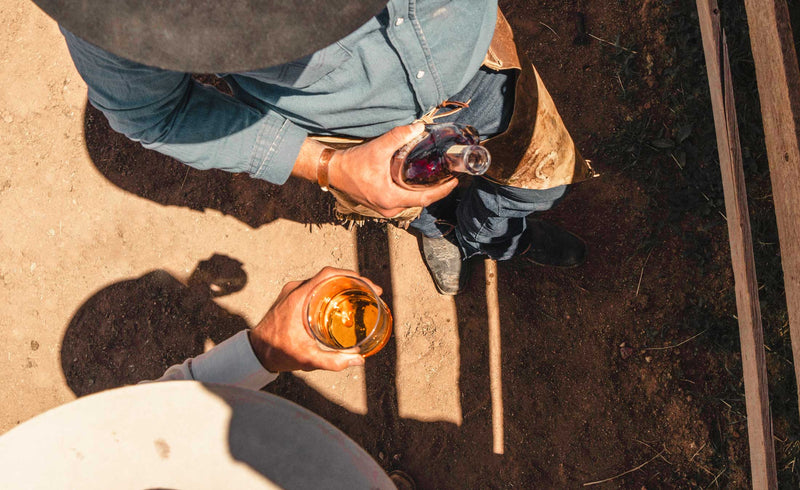
FATHER'S DAY GIFT GUIDE FOR THE BOURBON DAD
Out with neck ties and grilling tools. Dad doesn't want another pair of socks, and he DEFINITELY doesn't need another tie to add to his collection. This Father's Day, get the bourbon dad in your life what he really wants: the perfect essentials for his bar cart and whiskey cabinet. We've taken the guesswork out of gifting with this guide, so you can shop with confidence and find something dad is sure to love.
For the Entertaining Dad
For the bourbon dad who loves to entertain, consider a bar cart that will store all of his bourbon bottles and barware in one place. This way, he can easily roll it out when company comes over and show off his collection.
Buy the Tabiauea Bar Cart
For the Bourbon Loving Dad
Our fan favorite seasonal coffee infused bourbon is a tough one to beat. Winning the highest achievement in the sprits industry – a double gold medal at the San Francisco World Spirits Competition, this bourbon is perfect for the dad who loves a good his coffee as much as he loves his bourbon.
Buy Oak & Eden Bourbon & Brew
For the Recipe Following Dad
Every bourbon dad needs a go-to guide for making his favorite cocktails. This bartending book has everything he needs to know, from how to make classic drinks like the old fashioned to more creative concoctions.
Buy The Bar Tender's Guide Book
For the Home Mixology Dad
This sleek copper bar set is perfect for the bourbon dad who loves mixing drinks. The set includes a shaker, jigger, strainer, and stirrer, so he can make any cocktail his heart desires.
Buy Godinger Copper Bar Tools Set
For the Campfire Drinking Dad
Every bourbon dad needs a good mug to enjoy his favorite bourbon on the rocks. This YETI Rambler mug will keep his drink cold for hours, all the while sipping in style, so he can enjoy it at his leisure.
Buy YETI Rambler Mug
For the Rye Loving Dad
While this list is primarily for bourbon dads, we would be remissed if we didn't include a rye whiskey for the dads who prefer a quality rye. While most rye whiskeys are deep & spicy, Oak & Eden Rye & Spire is uniquely smooth due to the charred American Oak spire placed in the bottle.
Buy Oak & Eden Rye & Spire
READ THE STORY
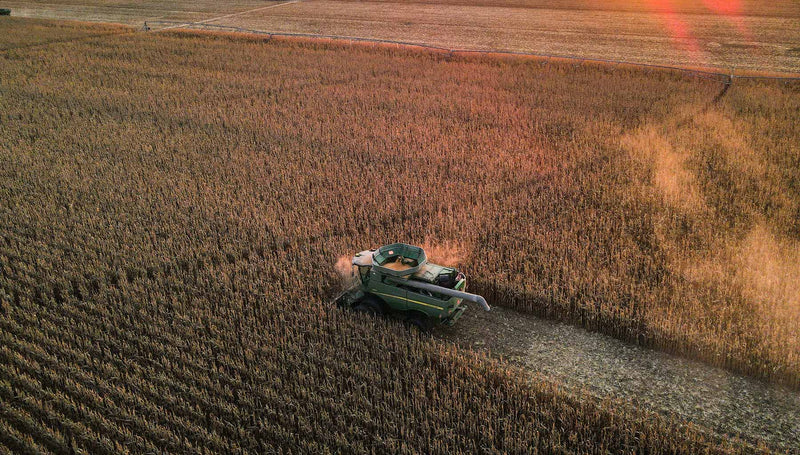
WHAT IS BOURBON MADE FROM?
What Is Bourbon Made From?
Bourbon is the most American of all the liquors and spirits in the world. But is America’s native spirit really any more special than other alcoholic beverages? What is it that makes bourbon special? And what exactly is it made from?
If you want to know what bourbon is made of, you’re in the right place. We’ve compiled all of our bourbon knowledge to give you a complete guide on one of the best kinds of whiskey anywhere in the world.
What Is Whiskey?
Before we dive into bourbon, we need to cover a few basics about whiskey itself. Unlike bourbon, whiskey isn’t a distinctive product of the United States.
There are several different types of whiskey, all of which have unique elements and requirements, but at their core, they all share a few key characteristics. Whiskey is a distilled spirit made from distilled cereal grains, commonly corn, wheat, barley, and rye.
Whiskey is hard liquor and is at least 40% alcohol by volume ( ABV). Whiskey is usually aged in wooden barrels, often for years, before bottling and consumption. Whiskey is anywhere from pale amber to deep brown in color, depending on the aging process and grains used.
What Is Bourbon?
Bourbon is a specific type of whiskey that originated in Bourbon County, Kentucky. Nowadays, straight bourbon can be found anywhere in the United States but must be from Kentucky to be labeled as Kentucky bourbon.
Bourbon must also be made with a sour mash bill of at least 51 percent corn, with the rest being made from a combination of additives which commonly include wheat, malted barley, and rye. This iconic American whiskey has the caramel and vanilla flavor profile that America has grown famous for.
Some of the most popular bourbon producers in the U.S. today include Jim Beam, Maker’s Mark, Four Roses, Town Branch, Buffalo Trace, Wild Turkey, and Woodford Reserve. While Jack Daniels is a renowned Tennessee whiskey, it’s technically not bourbon.
How Is Bourbon Made?
The whiskey-making process is quite varied around the globe, depending on the country of origin and the type of whiskey being made. Bourbon is one of the most highly regulated whiskeys in the world, with the steps of the process closely monitored for quality and consistency across bourbons.
Here is an in-depth look at how the liquor is made at bourbon distilleries and what makes it so delicious.
Step One: Selecting and Mashing the Grains
The first step of the bourbon-making process is the selection of the grains. The mixture of grains used in bourbon is the first of many regulated aspects of the process. All bourbons must be made with a mash bill containing at least 51% corn.
The other 49% of grains can be made up of more corn, rye, barley, or wheat, depending on the specific distillers' recipe. Each distiller tends to have its own specific blends, using grains carefully sourced from around the United States and the world at large for the best and most specific flavor profiles possible.
Once the mash bill is prepared, the grains are ground up very fine and then added to a large vat where it is combined with hot water to create a porridge-like substance, which is called the mash. This whole process is called “mashing” and helps to release the sugars in the grains before fermentation.
Step Two: Fermenting the Grains
The next step of the bourbon-making process is the fermentation and maturation of the grains. This is the process that actually produces the alcohol that is in our favorite spirit.
The mash is placed into a new tub or tank, where yeast is introduced. This yeast then feeds on the sugars that were released during the mashing process, which has the byproduct of producing alcohol.
The fermentation process for straight bourbon whiskey takes anywhere from 48 hours to 96 hours, depending on factors like temperature, humidity, type of grains, and type of yeast used for fermentation. When fermentation is complete, the mash will reach 7-10% ABV, at which point it can be called the distiller’s beer.
Step Four: Distillation
The next, and perhaps one of the most important steps of bourbon production, is distillation. Distillation is the process of purifying and increasing the alcohol content of liquor. Distillation was first invented and used in ancient Mesopotamia to produce aromatics and perfumes.
Distillation has been used in whiskey production for over a thousand years, starting in Ireland and Scotland. Bourbon is produced using the column still distillation method, which is a more modern version of distillation than pot distillation (the older method many other kinds of whiskey used).
In a column distiller, the distiller feeds the distillers beer into the column, where it is heated to boiling by the infusion of hot water vapor. This causes the alcohol to vaporize, rising through the column until it hits the first condenser plate.
The condenser plates are metal plates in the column still that alternate up the height of the column. When the alcohol vapors reach the plates, they condense back into liquid. From here, the vapors are redistilled in a pot called a doubler. Then the rising hot water vapor heats the condensed liquid back into vapor, where it rises to the next plate to repeat the process.
Eventually, the gasses are captured and funneled into the condenser still where the spirit is brought back to its liquid state at around 70% ABV.
Step Five: Aging
From the column still, the spirit then goes into new, charred white oak barrels to be aged for a minimum of two years. The charred new oak casks give bourbon its distinct vanilla notes and sweetness. Using these oak containers is one of the legal requirements for a spirit to be labeled bourbon.
As the whiskey rests in the wooden barrels, the porous wood adds its flavors and aromas to the wood. Over time, this works to purify the whiskey, remove the harsh flavors, and add new and exciting elements to the flavor profile.
If you’re ever wondering how old a specific bottle of bourbon is, you’ll find an age statement on the label. In general, the older the bottle, the rarer it is.
Step Six: Bottling
Once the whiskey has finished aging, it is ready to be bottled and sold for consumption. Many distillers will mix many barrels of whiskey together before bottling to create uniformity. If a bottle of whiskey contains only whiskey that was aged in one barrel together, then that is called a single barrel whiskey.
Step Seven: In-Bottle Finishing
For most whiskeys and bourbons, the whiskey-making process is complete. But at Oak & Eden, we take things one step further. We use a technology we call in-bottle finishing to add flavors and finishing notes to our whiskey while it sits in its bottle waiting for you to drink.
In every bottle of Oak & Eden whiskey, you will find our patented wooden spires: spiral-cut pieces of wood designed for maximum surface area. These spores are selected, spiced, and prepared precisely for each different blend of Oak & Eden Whiskey to give each bottle and blend the perfect finishing touch.
So What Is Bourbon Made From?
Now that we understand what exactly goes into the bourbon-making process, we can understand a little bit clearer what bourbon is actually made from.
First and foremost, bourbon is made from grains, of which at least 51% needs to be corn. The other grains used can be any combination of barley, rye, or wheat. Bourbon must also be made using column distillation instead of pot distillation, another distillation technique used for other whiskies, like Scotch.
And finally, bourbon must be aged in new oak barrels with char on the inside. While you may not consider the barrel an important ingredient in the bourbon, we certainly do. The wood that whiskey is aged in is where most of the flavor and all of the color of whiskey come from. This means that, by some counts, the barrel is the most important ingredient in any whiskey, not just bourbon.
Is Bourbon More Special Than Other Varieties of Whiskey?
All this commotion about bourbon whiskey may have you starting to feel that bourbon is the pinnacle of whiskey and no other whiskey could compare. But bourbon is just one of the many regional varieties of whiskey throughout the globe.
While bourbon has seen a bit of a global resurgence in recent decades, there are great whiskeys made across all varieties and in all regions of the globe. From smoky Scotch to smooth Irish whiskey, there are plenty of whiskey blends and options for all tastes and flavors.
Here at Oak & Eden, we offer a variety of whiskeys, including bourbon, rye, and wheat whiskey. We also offer some special blends that combine our whiskey with flavors of cold brew coffee and more.
You can learn more about our story and our whiskey here.
What Is Bourbon Made From: Takeaways
Bourbon is the most famous American-made whiskey in the world and is notorious for its balanced, sweet, and warm flavor profile. There are a lot of distinctions that make bourbon unique that all bourbons must meet to legally call themselves bourbon.
Bourbon whiskey must be made with a mash bill of at least 51% corn. Then the whiskey must be made in the United States and distilled using column distillation. From there, the whiskey must be aged in new, charred oak barrels for a minimum of two years before bottling and consumption.
Oak & Eden Whiskey goes through an extra step, which is in-bottle finishing. Our carefully crafted wooden spires add subtle flavor notes to our fully aged whiskeys while they are in the bottle waiting for you to drink. This gives our whiskeys their creamy, smooth, and complex flavors.
Give Oak & Eden whiskey a try and see what difference the spire makes.
Sources:
Coffey still | Whisky Advocate
What is Kentucky Bourbon Whiskey? | BourbonCountry
What's the Difference Between Bourbon and Whiskey? | Food & Wine
READ THE STORY
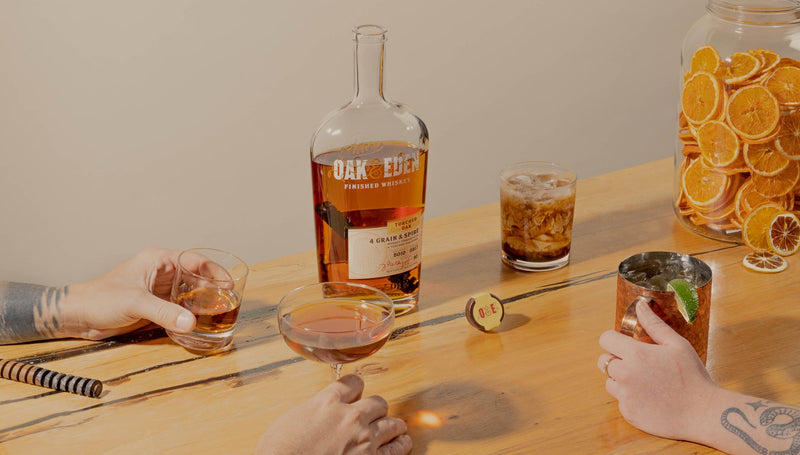
WHAT IS WHISKEY? WHAT YOU SHOULD KNOW
What Is Whiskey? What You Should Know
There are usually a few bottles of different whiskeys from different distilleries at every bar.
Whiskey is one of the five core liquors — vodka, gin, rum, tequila, and whiskey — which are the most popular liquors globally. But beyond that, do you really know what whiskey is? Sure, it’s alcohol, but what’s in it?
Whether you have never had a sip of whiskey in your life and are looking to get into it, or you are a seasoned whiskey sipping expert, you might be surprised just how much about whiskey you didn’t know.
Here are a couple of the essential facts about whiskey that you should know to best enjoy this delicious spirit.
Whiskey: The Basics
There are dozens of different varieties of whiskey that are all distinct regional creations that have unique tastes, flavors, production techniques, and histories. A few examples of common whiskey nomenclature include:
Single-malt whiskey or single distillery whiskey
Canadian whiskey
Scottish whisky (Scotch)
American whiskey (Bourbon)
Irish Whiskey
Corn whiskey
Whiskey from Japan
Whiskey cocktails like an old fashioned or whiskey sour
At its core, however, there are some things that all whiskey types share, no matter where they came from.
Whiskey is an amber to the brown-colored distilled spirit made from fermented grains of varying blends and varieties depending on local grains and tastes. This mash of cereal grains often includes some corn. Whiskey is hard liquor and usually has an alcohol content of about 40% ABV.
It’s typically distilled and then aged in wooden casks for some time before they are eventually bottled. This aging process is a major component of the flavors of each specific different kind of whiskey.
Each whiskey is unique in flavor, but common flavor notes across varieties of whiskey are warm, spicy, caramelly, nutty, woody, and toasty.
When Was Whiskey Invented?
The origin of whiskey holds plenty of its own clues about what whiskey has to offer and the flavors of whiskey around the globe.
The story of whiskey all starts with the discovery of the distillation process, which through the use of alternated boiling and condensation, produces a stronger alcoholic product. Distillation was first used in Mesopotamia as far back as 2000 B.C, making it over 4000 years old.
Distillation slowly spread throughout Greece and then Europe, where the process was used to distill everything from aromatics to drinking water to alcoholic beverages.
The first time that we see whiskey coming up is in the 1000s A.D., when monks in Scotland, unable to ferment alcoholic beverages from grapes, began fermenting grain mashes that would be distilled to become the first whiskies.
Whiskey was originally referred to as aqua vitae, Latin for the water of life, which eventually became known as whiskey. Distilleries became quite successful in Ireland and Scotland, and as Europeans immigrated to the United States, distilleries came with them.
Eventually, this led to the proliferation of distilleries in Kentucky and Tennessee, which produce some of the world's finest bourbons, ryes, and Tennessee whiskies.
What Are the Different Kinds of Whiskey?
There are many different kinds of whiskey, each with its own unique requirements, ingredients, styles, and flavors. Here is a little overview of what each kind of whiskey is.
Bourbon Whiskey
Bourbon is a type of whiskey that is uniquely American. There are several things that make a bourbon a bourbon, but first and foremost, all bourbon has to be made in the United States.
Rye Whiskey
Rye whiskey, unlike bourbon whiskey, does not have to be made in the United States of America. In fact, rye whiskey is very popular in Canada in addition to the United States. Rye whiskey uses a mash bill of at least 51% rye. This gives rye its distinctive, spicy flavor profile that people love.
Tennessee Whiskey
Tennessee whiskey is much like bourbon whiskey, except Tennessee whiskey must be made in the state of Tennessee. Tennessee whiskey must use a Maysville with at least 51% corn and must also go through a special charcoal maturation process that mellows the flavors in the whiskey.
A prime example of this type of whiskey is Jack Daniel’s.
Scotch Whisky
Scotland was one of the first places in the world to produce whiskey.
Scotch whiskies are typically malt whiskies, meaning they are made using mostly malted barley in the mash bill. Scotch whiskies must also be made in Scotland as well as be aged for a minimum of three years also in Scotland.
Irish Whiskey
Jameson is the most famous of the Irish whiskies around the globe, and while they may be similar to Scotch, they are distinct. Irish whiskey, also known as Gaelic whiskey, is made with barley (typically unmalted). This gives Irish whiskey its smoothness and removes some of the smokiness that Scotch whiskey is famous for.
Japanese Whisky
Japanese whisky is a newcomer to the global whisky world, and it is spelled without the “e,” just like Scotch. Japanese whisky is based on Scotch, using manly malted barley, often imported from Scotland.
Japanese whisky uses the same distillation method as Scotch and is then aged in American wood, Japanese wood, or Sherry casks, which give Japanese whiskey its unique flavors like citrus and incense.
How Is Whiskey Made?
The process of whiskey is a long and complicated process, but one that takes us from simple grains to one of the finest beverages in the world. Here is an inside look at each step of the process one by one.
Pickling and Fermenting the Grains
Every great whiskey starts with different types of grains like wheat, barley, corn, and rye, which are carefully selected and combined in precise proportions to create the fermented mash bill, the recipe for the grains.
These grains then have to be mashed for them to release the sugars, which is done by grinding the grains and combining them with hot water in a tank and then stirring and mixing. Once the grains have released their sugars, and the mixture has thickened, it is ready for fermentation.
In a fermentation tank, yeast is introduced to the mash, which is then left to ferment for a few days before it is ready to move on. The fermentation process depends on the strain of yeast and the grains used.
After the fermentation period is over, the distiller has a beer-like liquid between 7-10% ABV, often referred to as distillers beer.
The Distillation Process
Now the fermented grain mash liquid or distilled beer is ready for the distillation process. The distillation process is used to increase the volume of alcohol in something. There are a few different distillation methods, but all are based on evaporating and condensing liquids to remove impurities and unwanted items.
Pot Still Distillation
Pot still distillation is one of the popular whiskey-making methods for malt whiskeys, which are whiskies made with malted barley. The malting process replaces the mashing process for malted whiskies. But Bourbons and other grain whiskies do not go through pot distillation.
In a post still, the distiller's beer is put in a still, a large metal pot, where it is heated to boil. Since alcohol has a lower boiling point than water, it evaporates quickly, and the gasses that rise off the boiling distiller's beer rise up into a tube that carries this gas into the second still, where it is condensed back into a liquid.
The resulting liquid comes out at about 20% ABV, so the process is then repeated two more times to reach a final product that is typically around 60-70% ABV.
Column Distillation
Column distillation is the other common distillation process for whiskies and is the primary process for grain whiskies like bourbon, rye, and corn whiskies. Unlike pot stills which have to go through a batch process, column stills work continuously to the final product.
The distiller’s mash is fed into the column still, where it is heated with hot water vapor, which causes the alcohol vapors to rise up the column. As the vapor rises, it repeatedly hits alternating metal plates in the column, which condense the vapors.
Then, the rising steam, which is still being fed through the column, heats the liquid again, as it constantly condenses and evaporates over and over up the column, where it eventually reaches a tube connecting it to the condenser which leaves the final distilled spirit.
Column stills are capable of very high distillation percentages, as high as 95%, although when distilling alcohol for consumption, they are not usually set to go that high.
The Aging Process of Whiskey
After distillation has been completed, the longest step of the process comes into play: aging. Much of whiskey's color, flavor, and aroma comes from the aging process rather than the distillation process.
The aging process is where many of the rules and regulations surrounding different designations of whiskey are located. For bourbon, rye, and other American whiskies, the rules stipulate the use of new, charred oak barrels for the aging process.
In other countries and styles, different distillers may use different woods and barrels that have previously been used for other purposes to create distinct flavor profiles and aromas for their own tastes.
During the aging process, the wood is porous and imparts its flavor profiles, terpenes, and oils into the liquid, giving it both color and flavor.
The Bottling Process of Whiskey
From there, your favorite whiskey is then bottled with at least 40% ABV and sealed for consumption later. Depending on the distiller and the run of whiskey, several barrels are usually combined in one bottling.
If only a single barrel is used in a bottle, then it is labeled as a single barrel or single cask whiskey.
What Is Finished Whiskey?
Many whiskeys are aged in just one barrel over the duration of the aging product. But other whiskies change barrels during the aging process, where the whiskey is “finished” with flavors from another wood.
Finished whiskey is a way that distillers can add additional flavors and elements to their whiskies, depending on what flavor profile they want the whiskey to have. These finished whiskies can be more complex and varied than traditional single-barrel whiskey.
What Is In-Bottle Finishing?
In most whiskies, bottling is the final step of whiskey production, and from here, the bottle is sold and consumed. But for Oak & Eden whiskey, the process isn’t quite finished. We use a process that we invented called in-bottle finishing.
In every bottle of Oak & Whiskey, you will find one of our specially designed wooden spires, designed for maximum surface area. This spire continues to flavor and finish your whiskey in the bottle, so it continues to improve and develop new flavors as it continues to rest in the bottle.
Unlike a second barrel finishing, our in-bottle process allows the whiskey to receive its finishing notes in the bottle itself. The longer you have the bottle, the longer the flavors of the spire will have to infuse the whiskey with the subtle flavor notes that Oak & Eden whiskies offer.
What Is Whiskey? The Takeaways
Whiskey is a varied and diverse spirit with many different varieties and regional tastes and flavors that go into them. At its core, whiskey is a distilled grain spirit, typically made from corn, barley, wheat, and rye, which is then aged in wooden barrels.
Whiskey is noted for its caramel and vanilla notes and flavors, as well as the woody and warm flavors common in whiskey. Whiskey is made through a process beginning with selecting the grain mash, fermenting the grains, distilling, and then aging and bottling the spirit when it is complete.
There are many different specific types of regional whiskey styles, from bourbon whiskey, rye whiskey, Irish whiskey, Scotch whisky, Japanese whisky, and Tennessee whiskey.
Oak & Eden offers bourbon, rye, and wheat whiskies that you are bound to love. Our whiskies use a technique called in-bottle finishing to get the finest flavors and aromas out of your whiskey. If you have never tried a finished whiskey before, we promise you are going to love it.
Sources:
Japanese Whisky: The Origin Story | Whiskey Culture
Coffey still | Whisky Advocate
What is Kentucky Bourbon Whiskey? | Bourbon Country
READ THE STORY
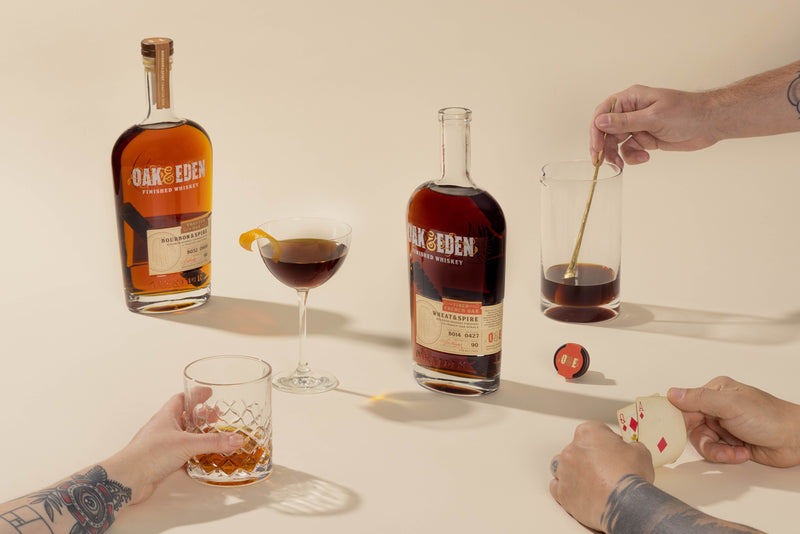
WHAT IS WHISKEY MADE OF?
The next time you’re at the bar, consider gravitating towards the smoky, dark, and intense bite of whiskey. Whether you choose to sample this liquor on its own or indulge in a mint julep, a Manhattan, or an old fashioned, it promises to be simple, classic, and delicious.
READ THE STORY
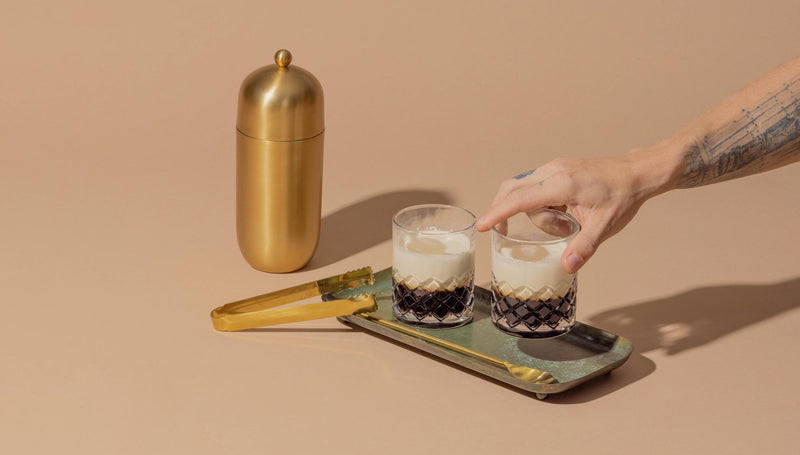
WHAT TO MIX WITH BOURBON: 9 CREATIVE IDEAS TO TRY
Whiskey drinkers around the globe have enjoyed bourbon for nearly two centuries. Known for its trademark dark flavor profile, this coveted liquid leaves an impression on even the most experienced drinkers.
READ THE STORY
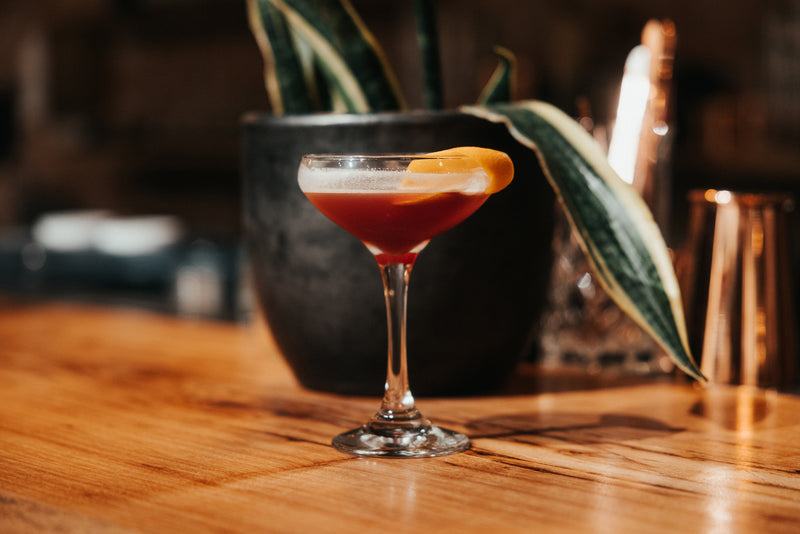
HOW TO DRINK BOURBON: ULTIMATE BEGINNERS GUIDE
Every year, bourbon becomes increasingly more popular among new drinkers. It’s showing up with greater frequency on cocktail menus worldwide, as well as an option to drink on its own.
READ THE STORY
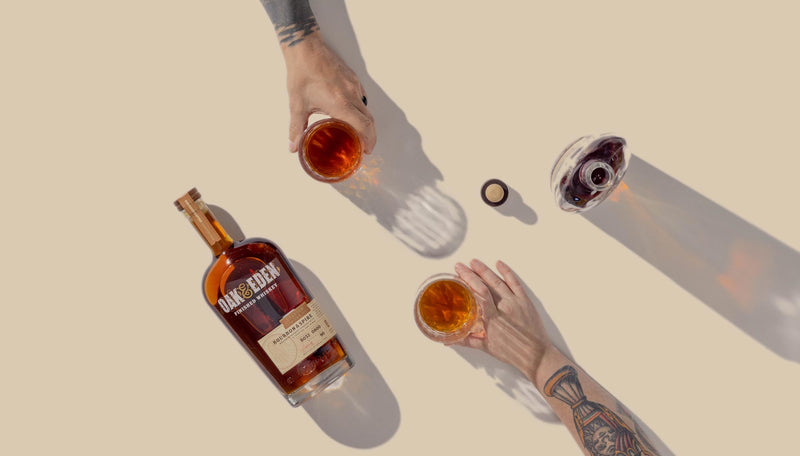
WHISKEY VS. BOURBON: WHAT TO KNOW
Bourbon whiskey is the most famous type of whiskey in the United States of America. As the most famous spirit to come out of distilleries in the US, bourbon carries a heavyweight as the world's liquor ambassador of the United States.
READ THE STORY
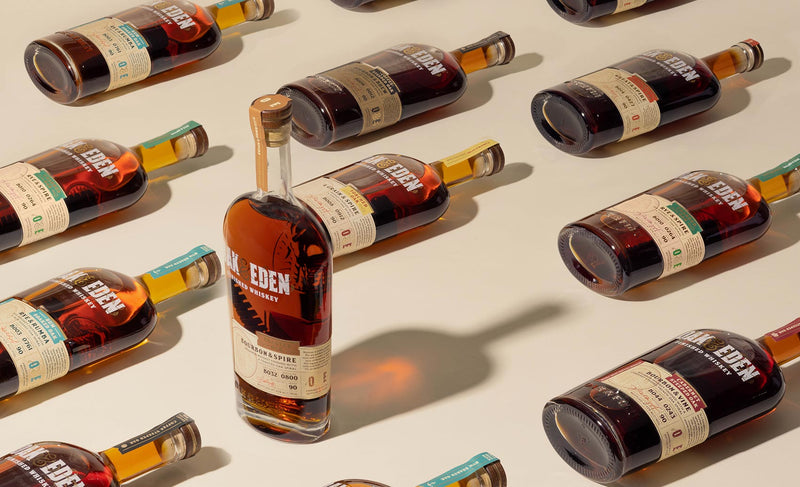
WHAT IS BOURBON? COMPLETE GUIDE
Bourbon whiskey is an American whiskey that has been enjoyed for generations. Cowboys, musicians, and bargoers alike have all rallied behind this timeless smoky drink.
READ THE STORY
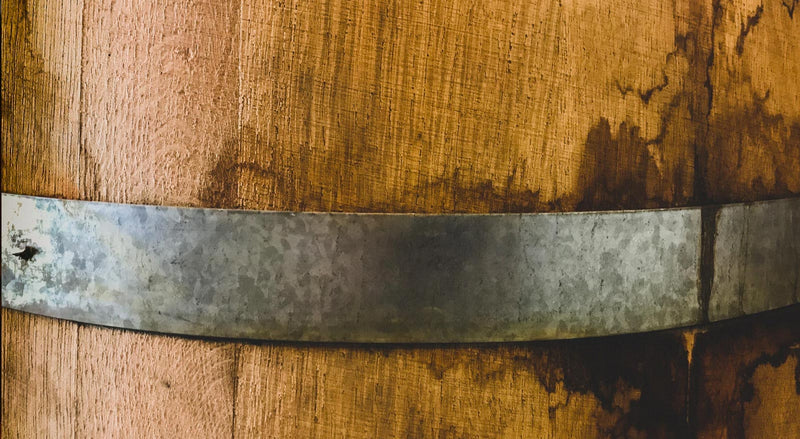
ANGEL’S SHARE WHISKEY: WHAT IS IT?
The angel’s share is the whiskey lost to evaporation during the aging process. It’s an inevitable part of making whiskey.
READ THE STORY
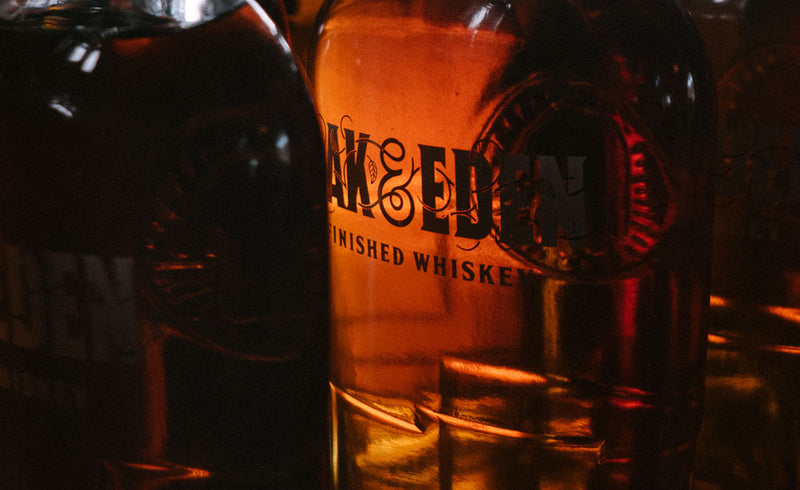
WHAT IS SINGLE BARREL BOURBON?
Bourbon is one of the most delicious drinks on the planet. Classic on the rocks, straight up, or as the main ingredient of a cocktail, bourbon is the quintessential American spirit.
READ THE STORY
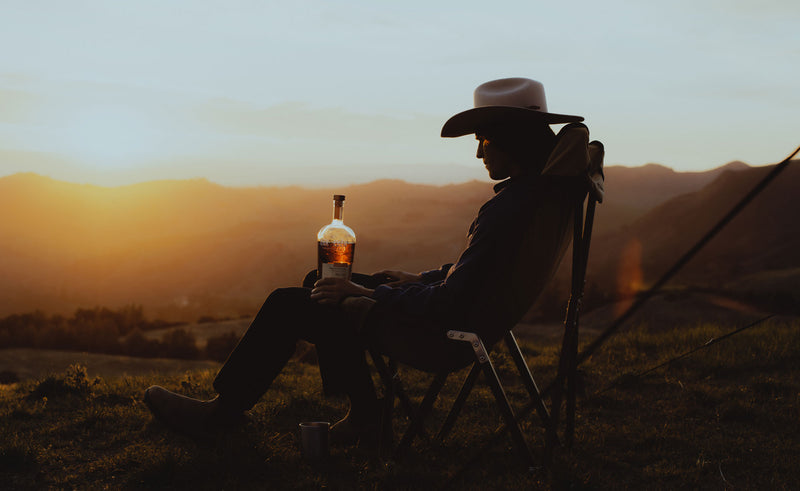
WHISKEY VS. SCOTCH: WHAT YOU SHOULD KNOW
Whiskey brings people together to laugh, tell stories, and share good times, whether at the bar or in the comfort of their homes.
READ THE STORY
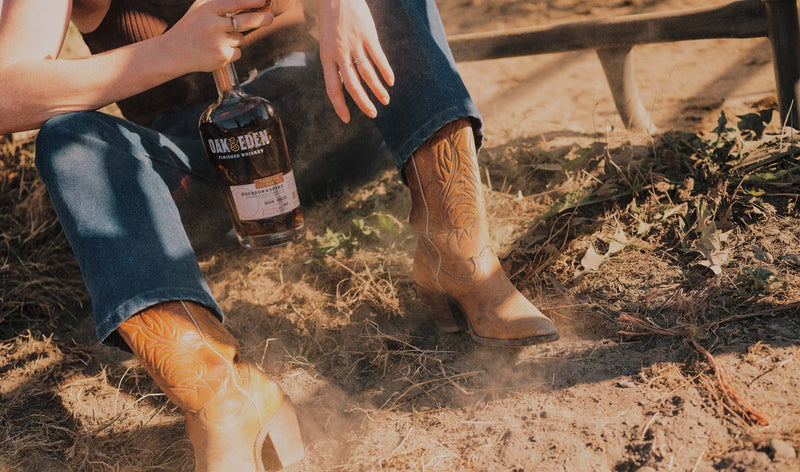
BOURBON VS. COGNAC: WHAT YOU SHOULD KNOW
Bourbon and Cognac are two of the most popular distilled spirits in the world. Both are well-known for their aging processes, which impart the rich and subtle flavors that make them unique.
READ THE STORY
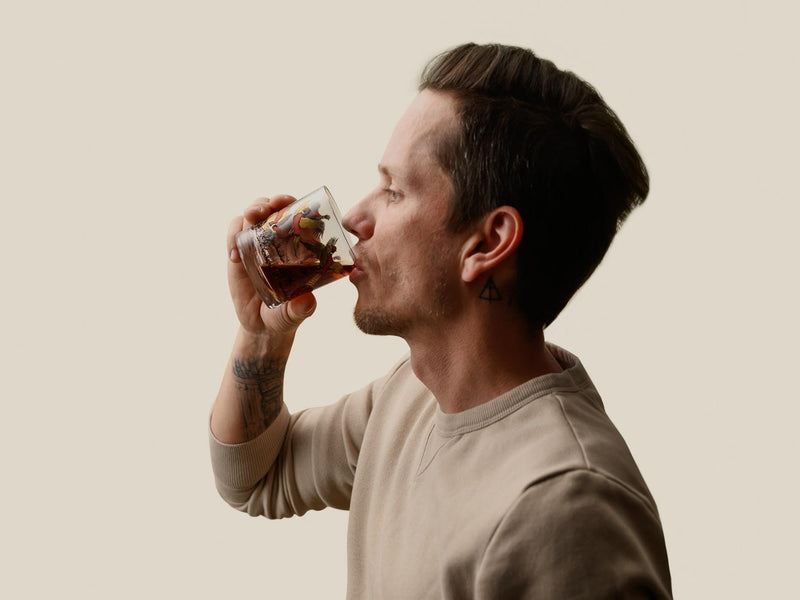
WHISKEY: THE HEALTHIEST SPIRIT ON EARTH?
Whiskey is no stranger to the health conscious, but what is it exactly that gives it this healthy reputation?
READ THE STORY
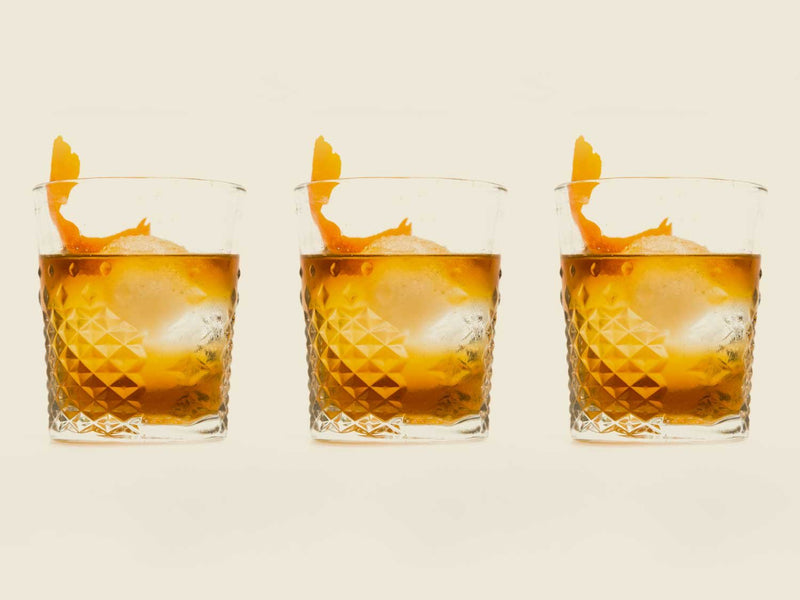
4 TYPES OF WHISKEY TO MAKE THE PERFECT OLD FASHIONED
We're here to discuss four different types of whiskey: bourbon, rye, wheated bourbon and four grain bourbon. We'll help you decide which to use for your next drink so you can make a tasty cocktail!
READ THE STORY
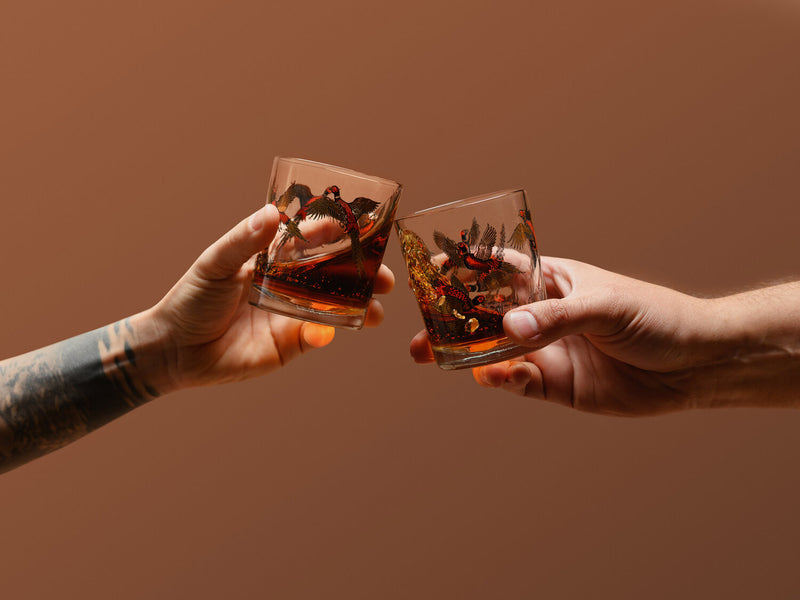
WHISKEY OR WHISKY: WHAT’S THE DIFFERENCE?
Whiskey or whisky? What’s the difference? Is it simply two different spellings of the same word, or are they two slightly different words describing two separate groups of spirits?
READ THE STORY
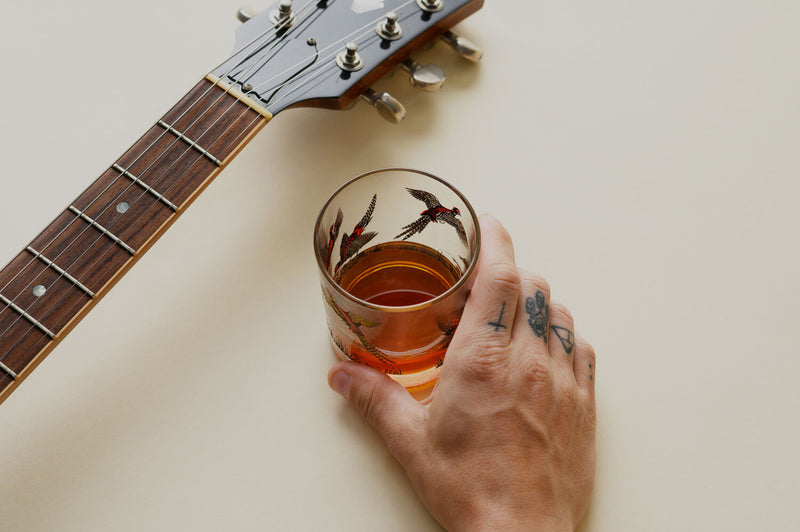
ARTIST CURATION: A JAMESTOWN REVIVAL SOUNDTRACK
Whether you’re feeling strong of heart, bold in your belief, tired after a long day of refining your craft, or dreaming of the days to come, we welcome you here.
READ THE STORY
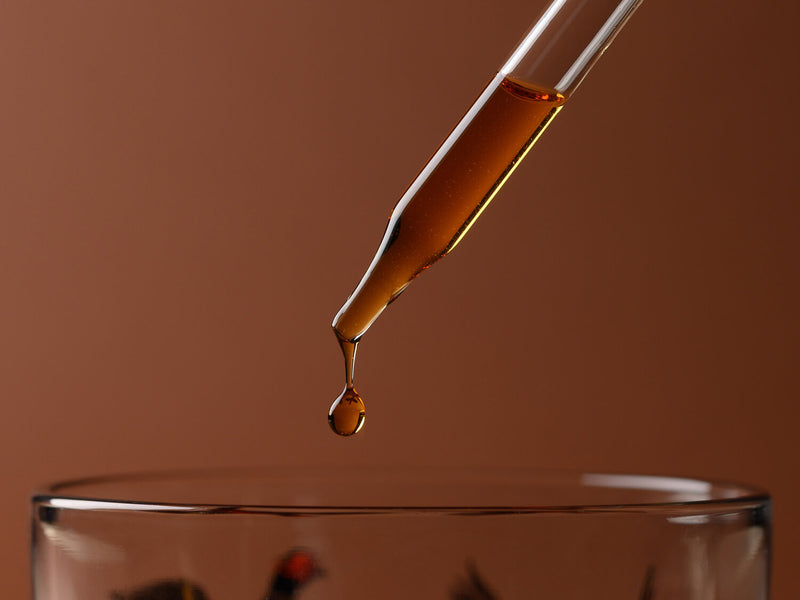
BITTERS 101
Bitters are made from botanicals, like aromatic herbs, roots, fruit, and bark. These ingredients are infused into a flavorless alcohol base to create a potent flavoring.
READ THE STORY

